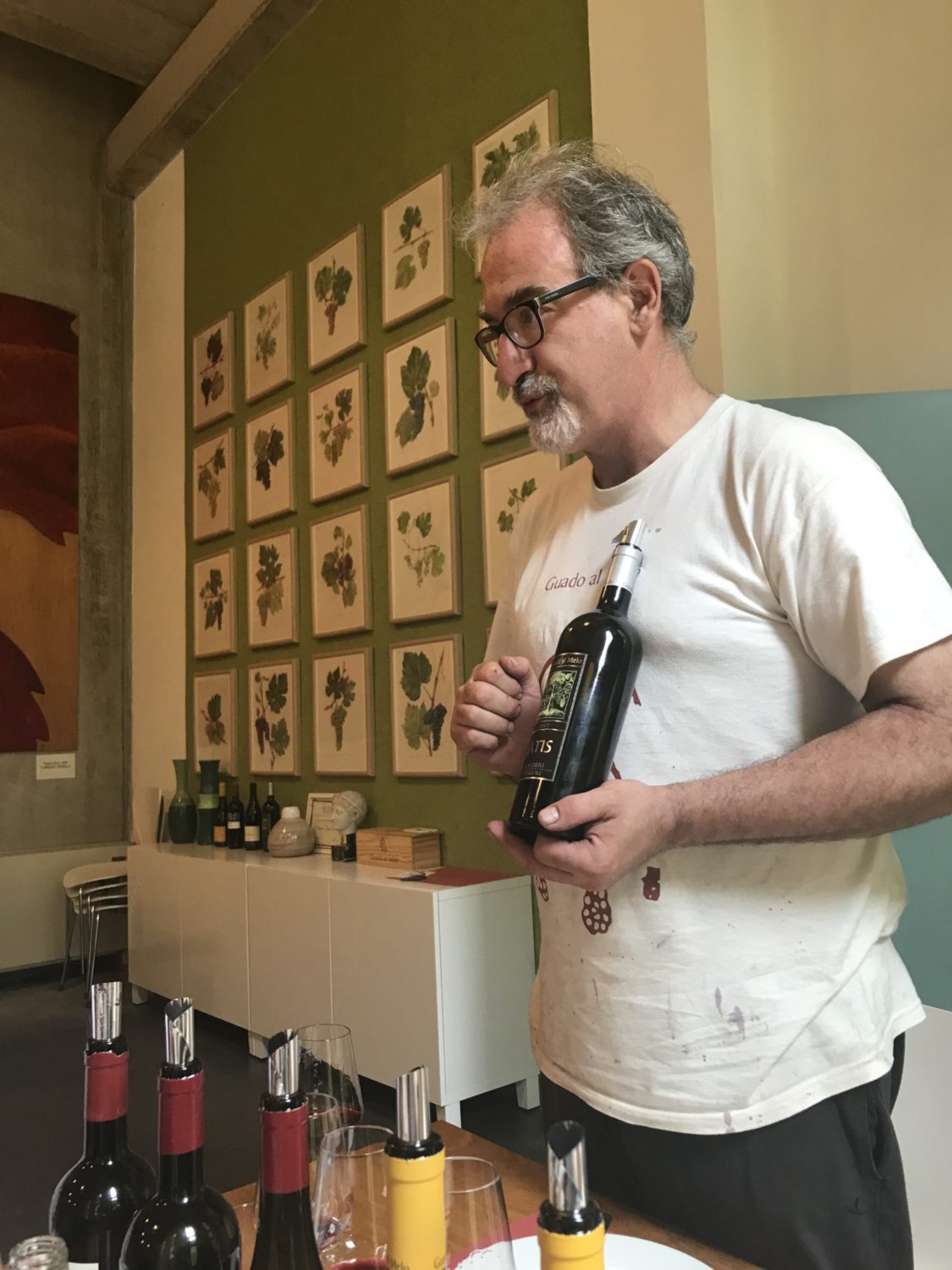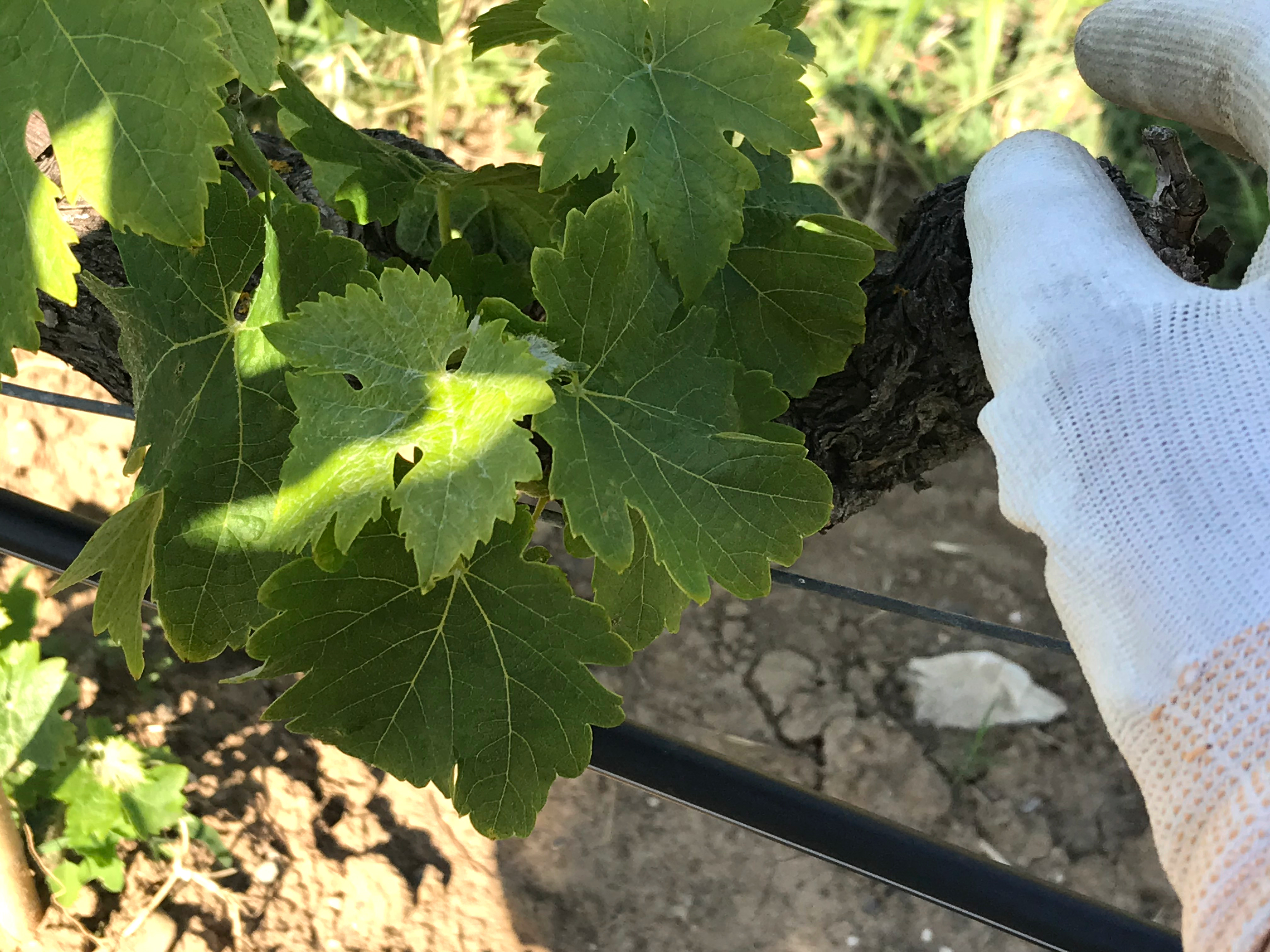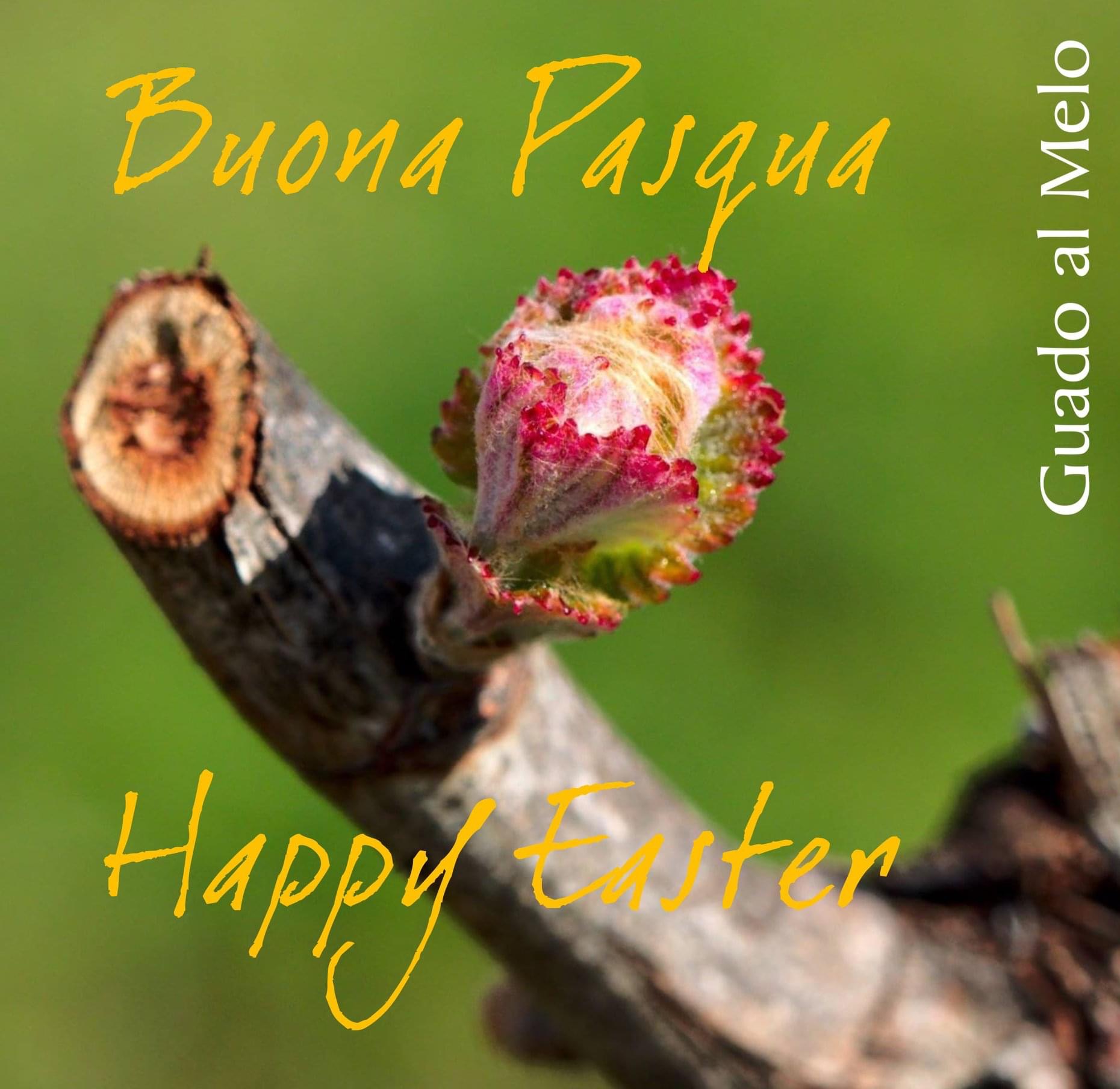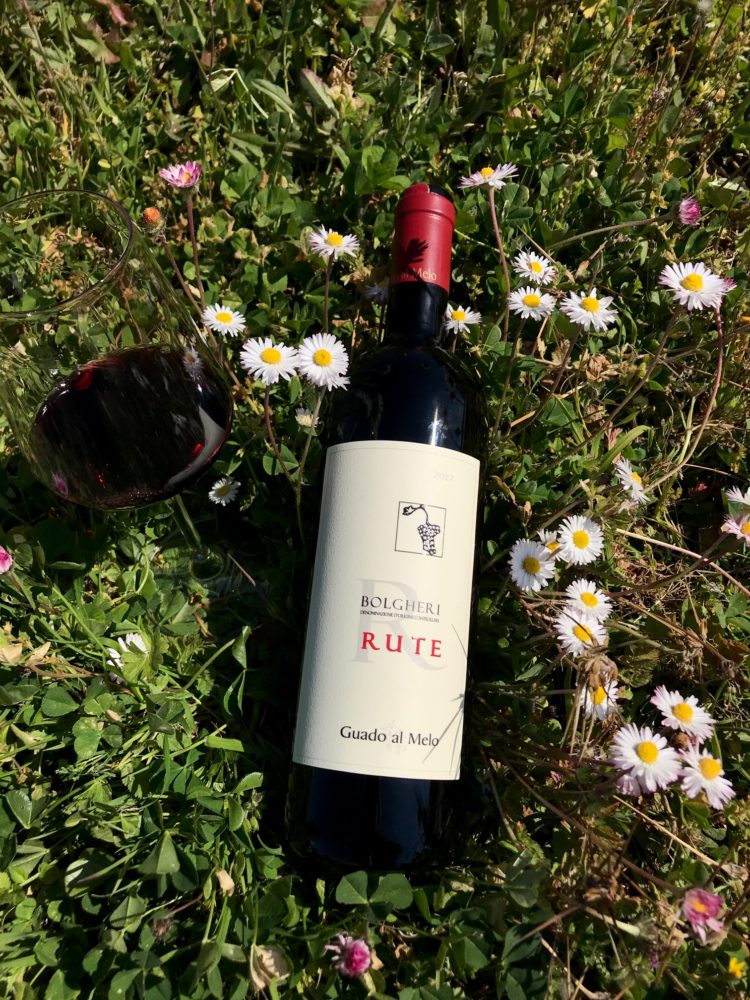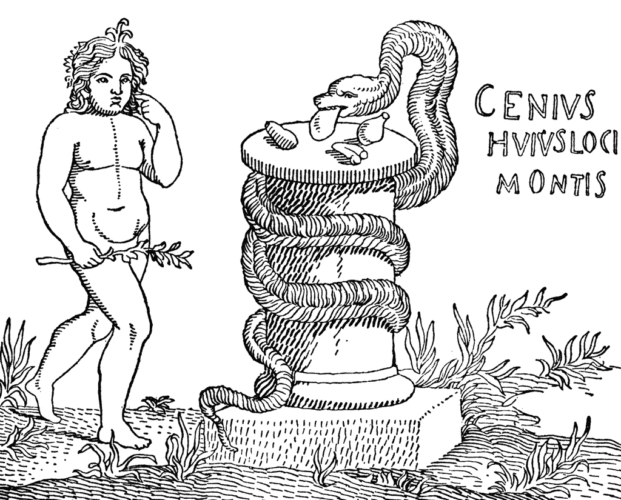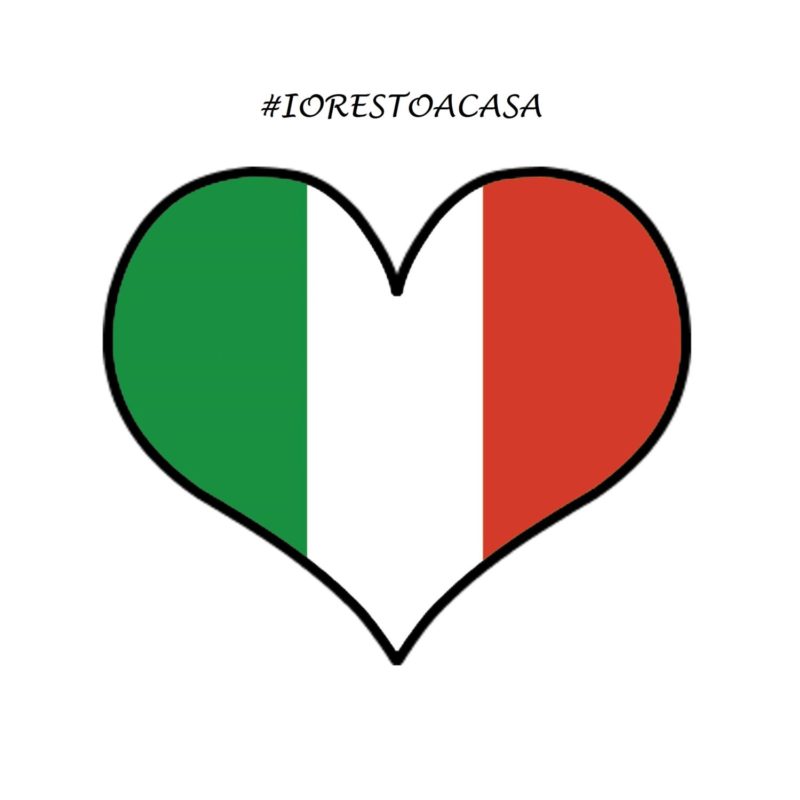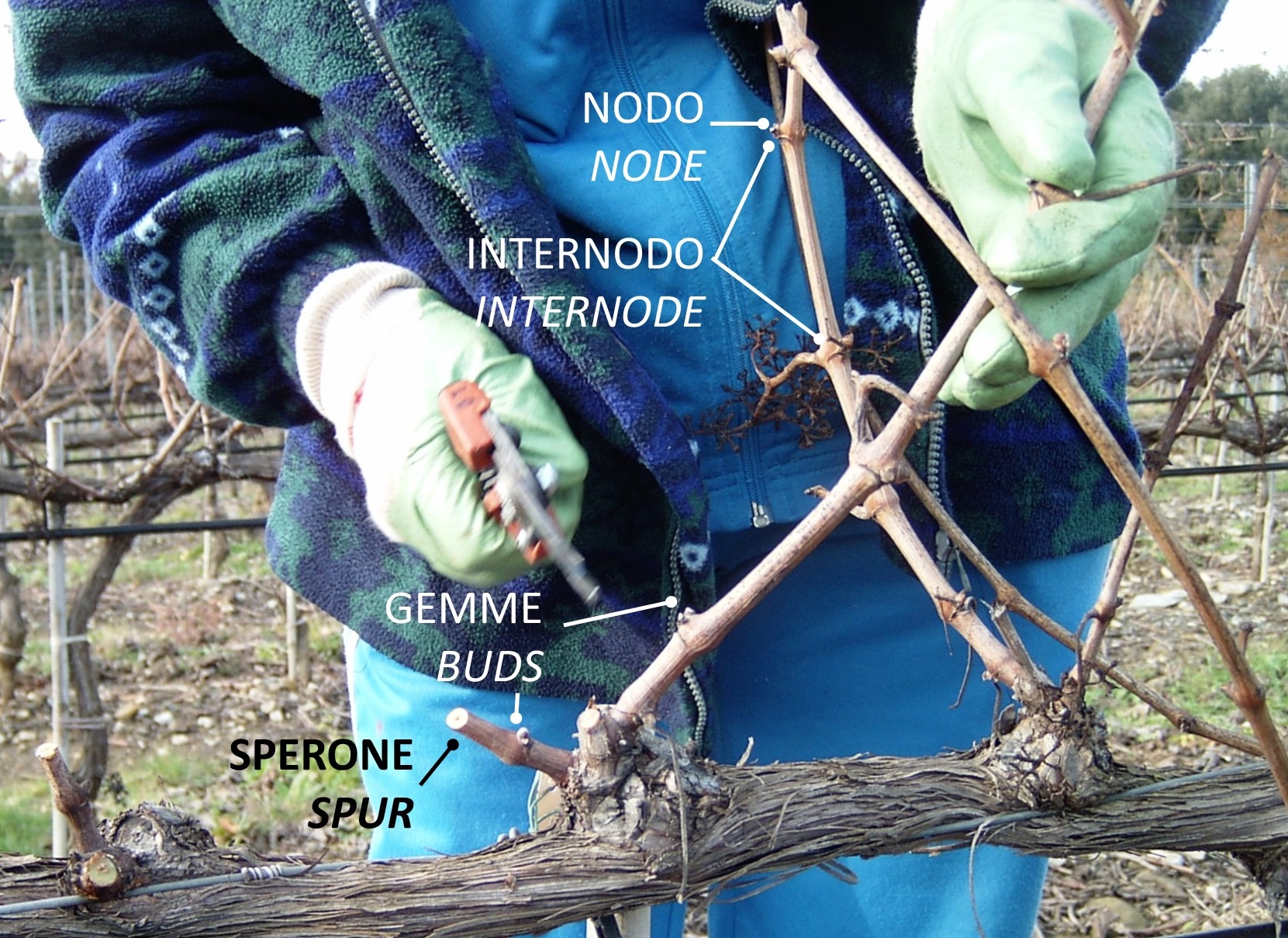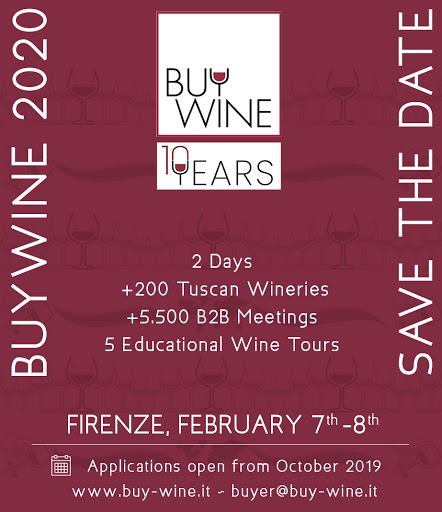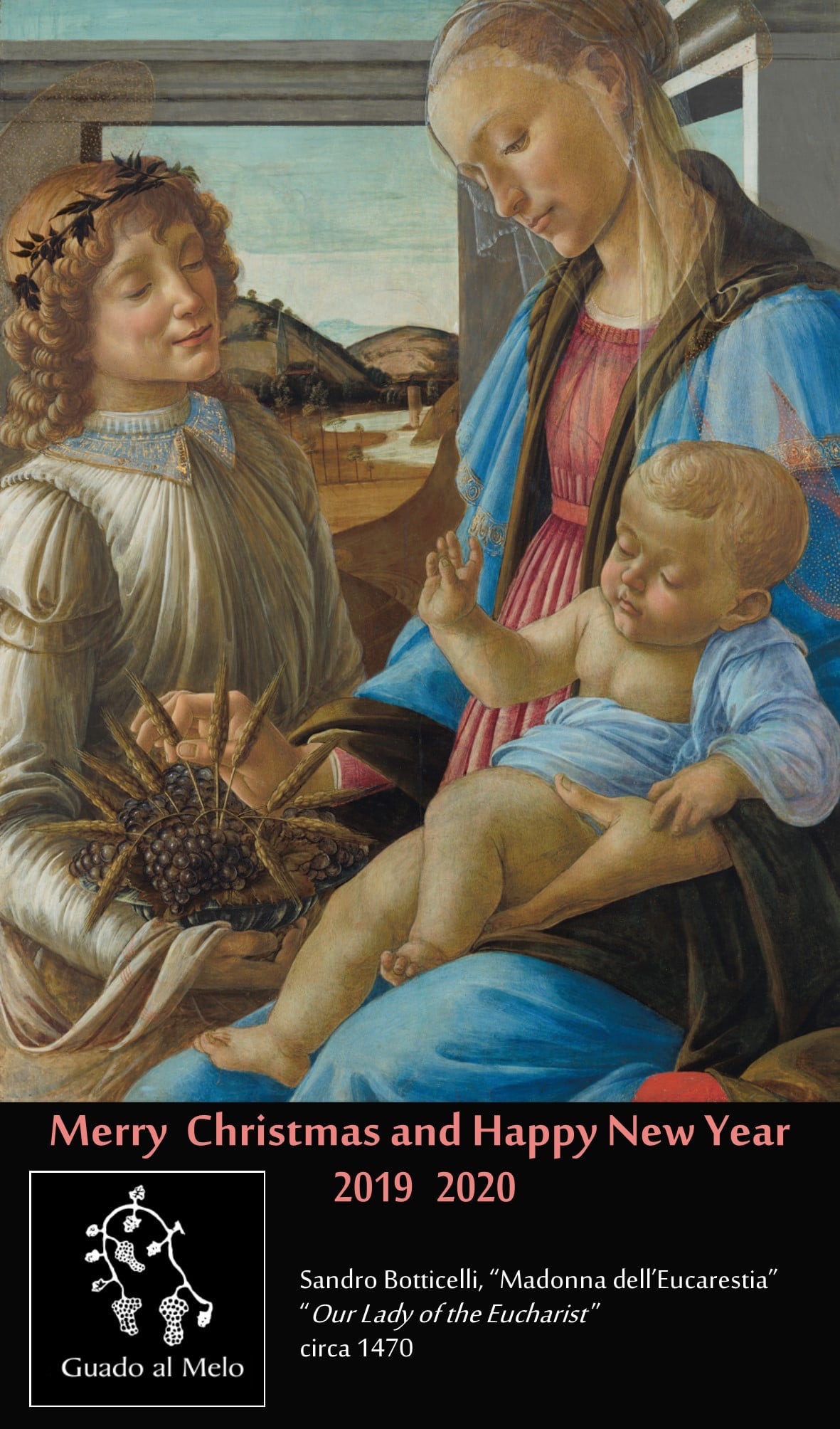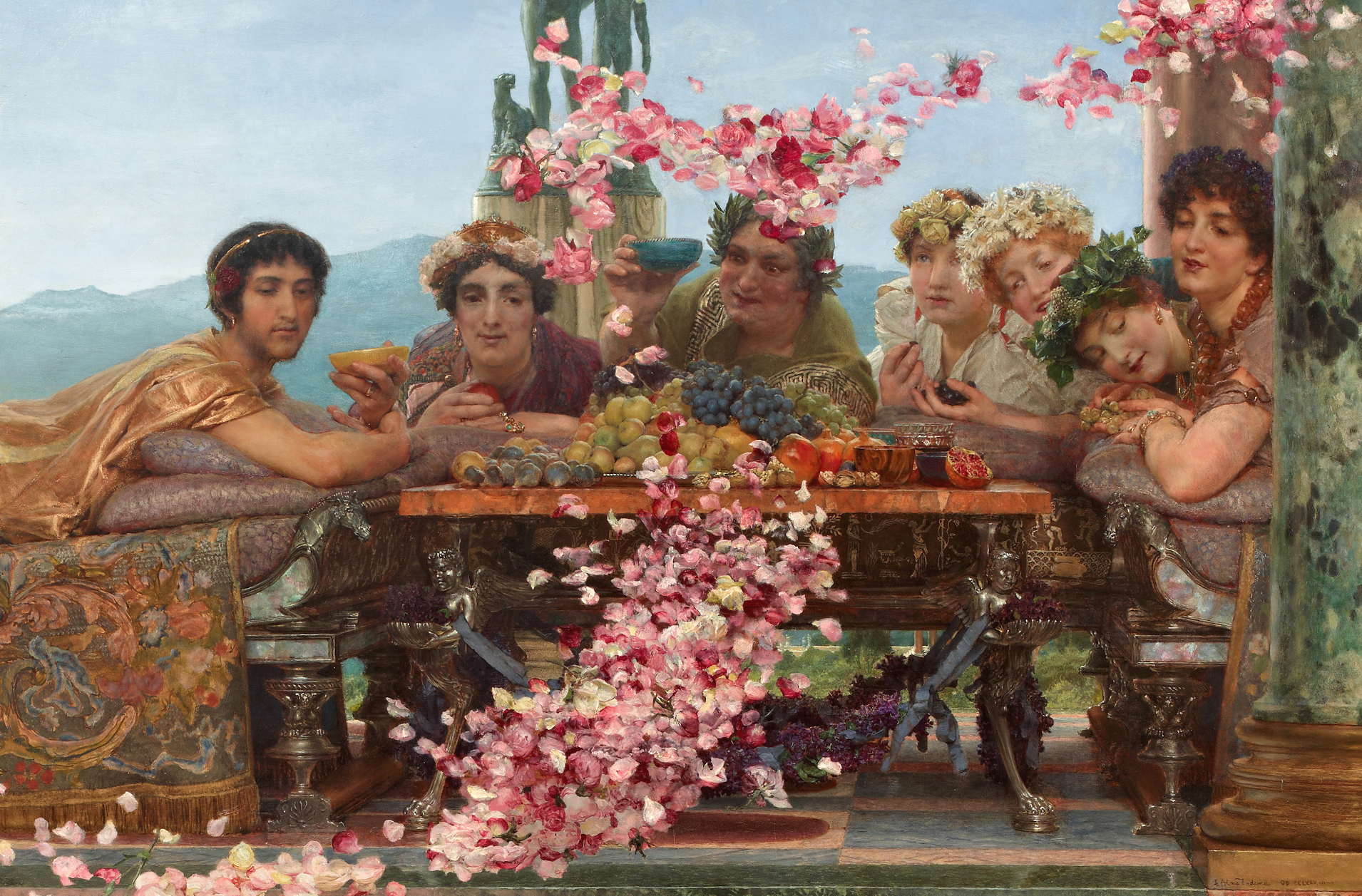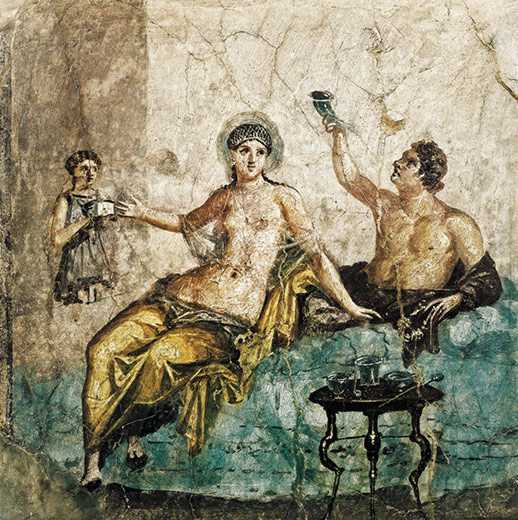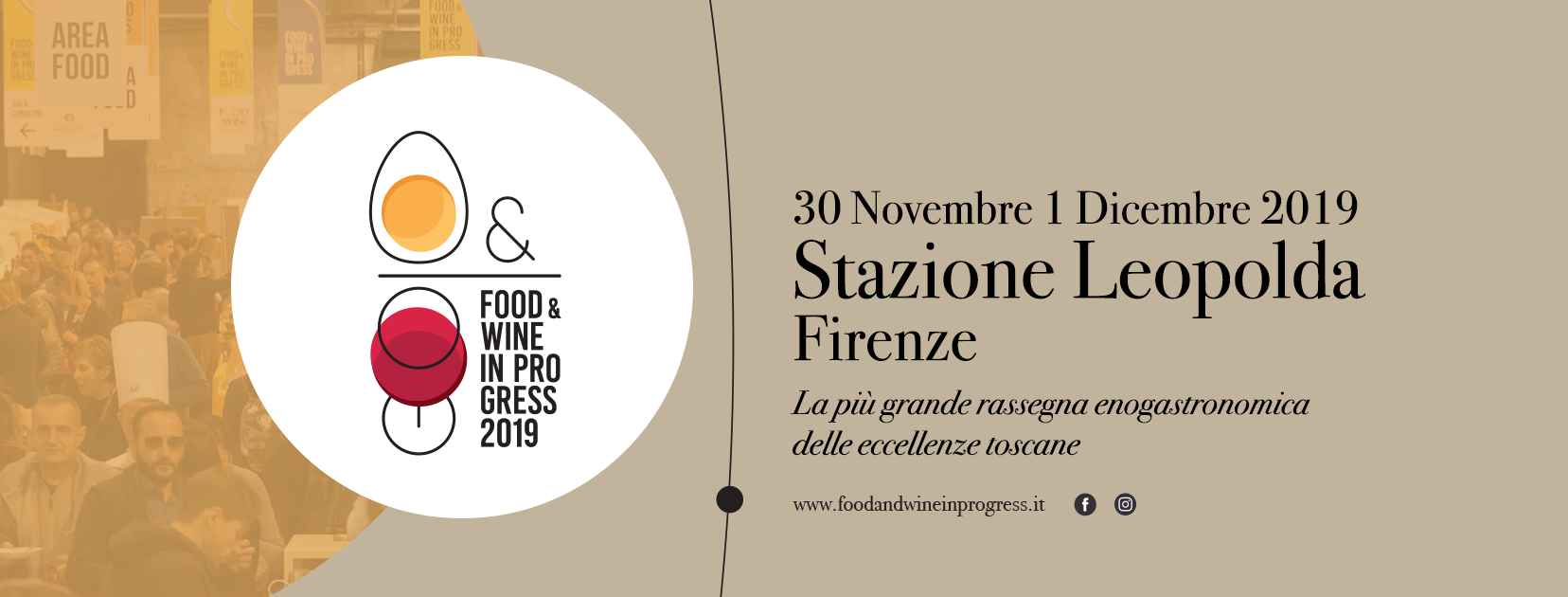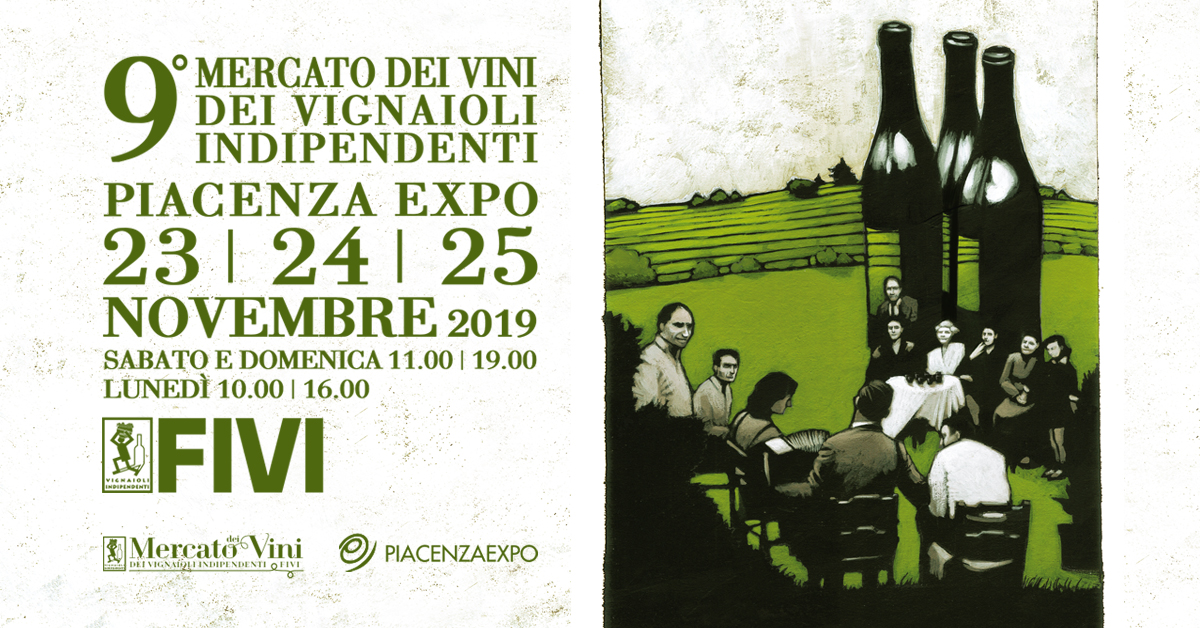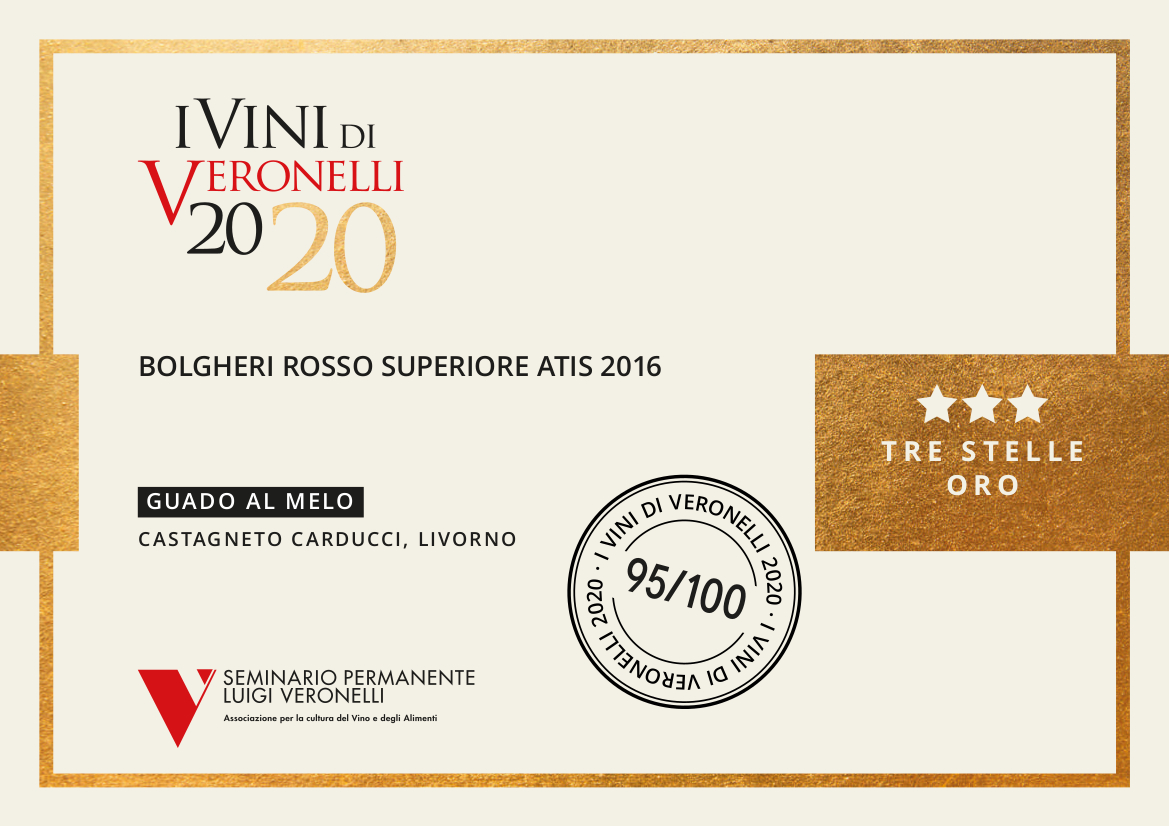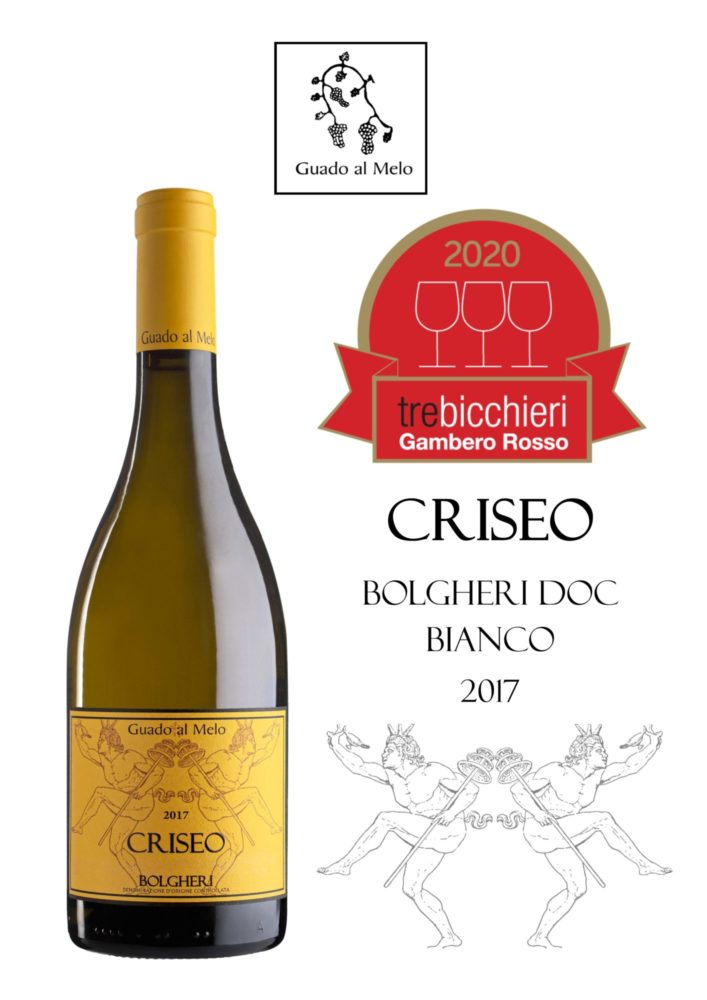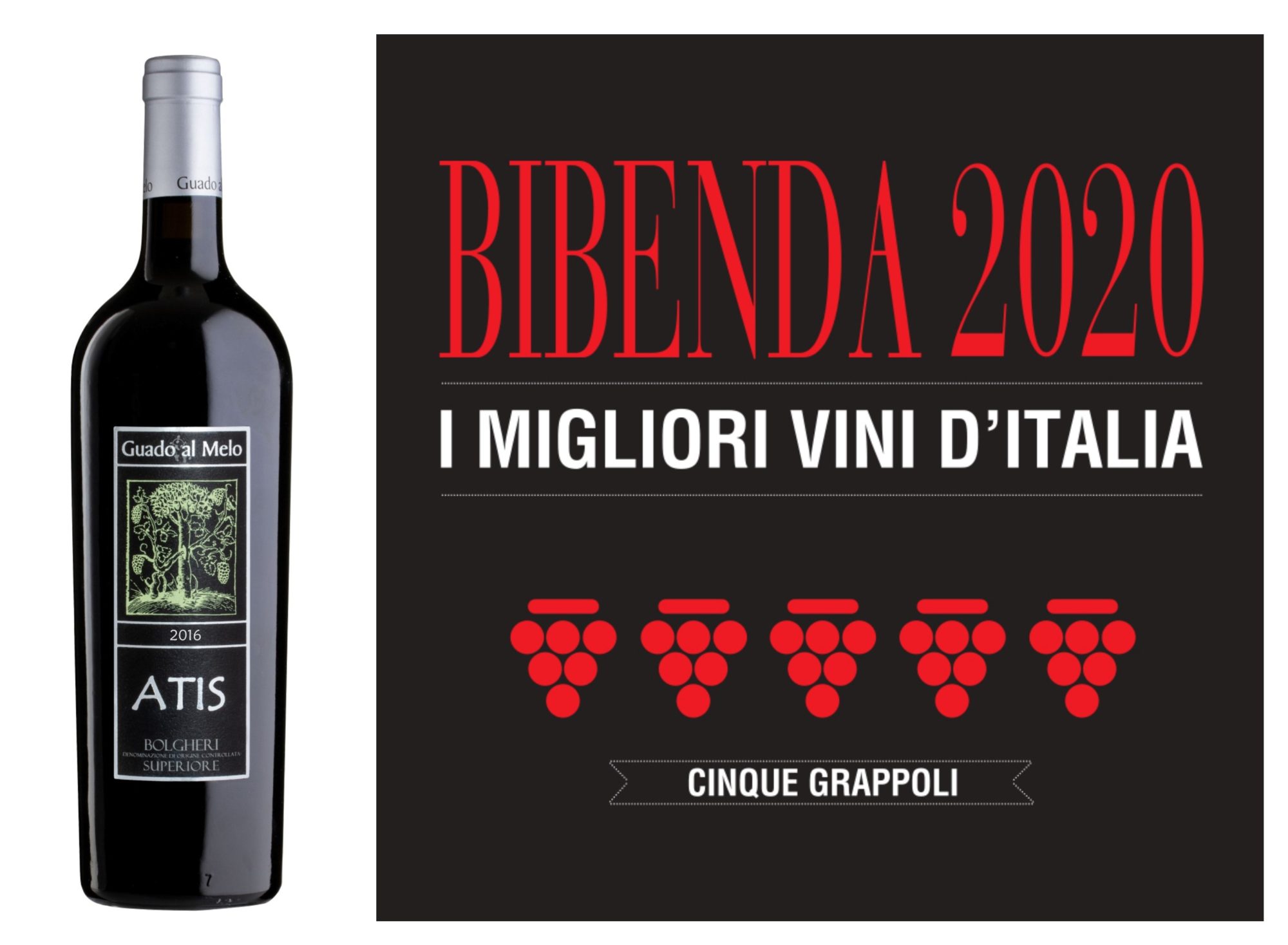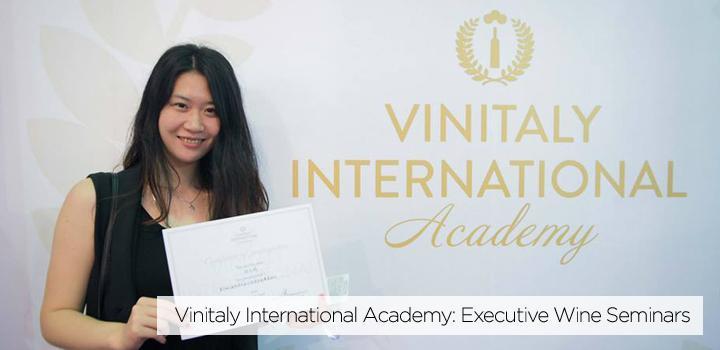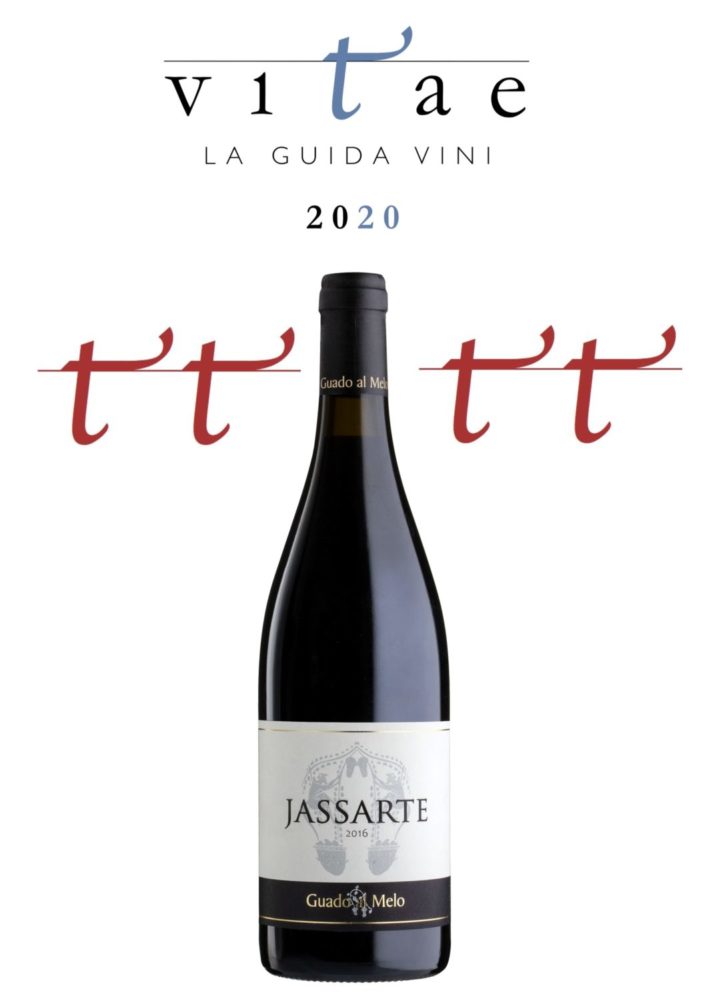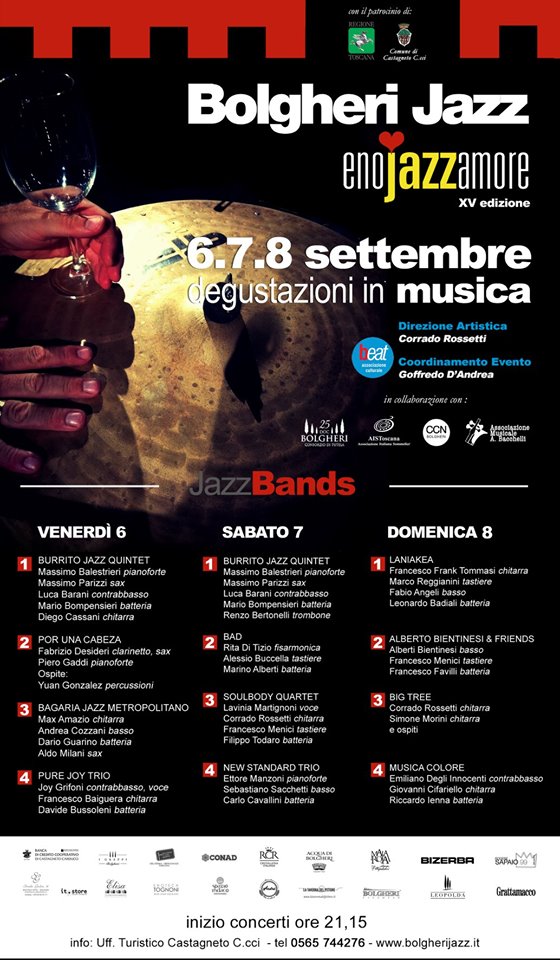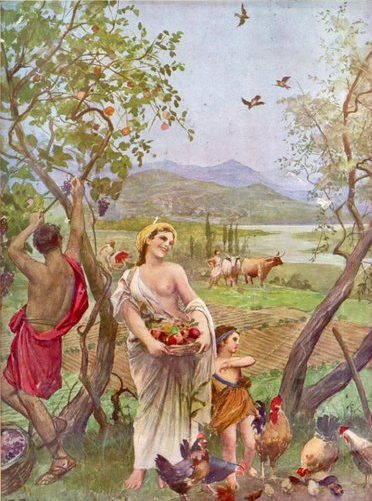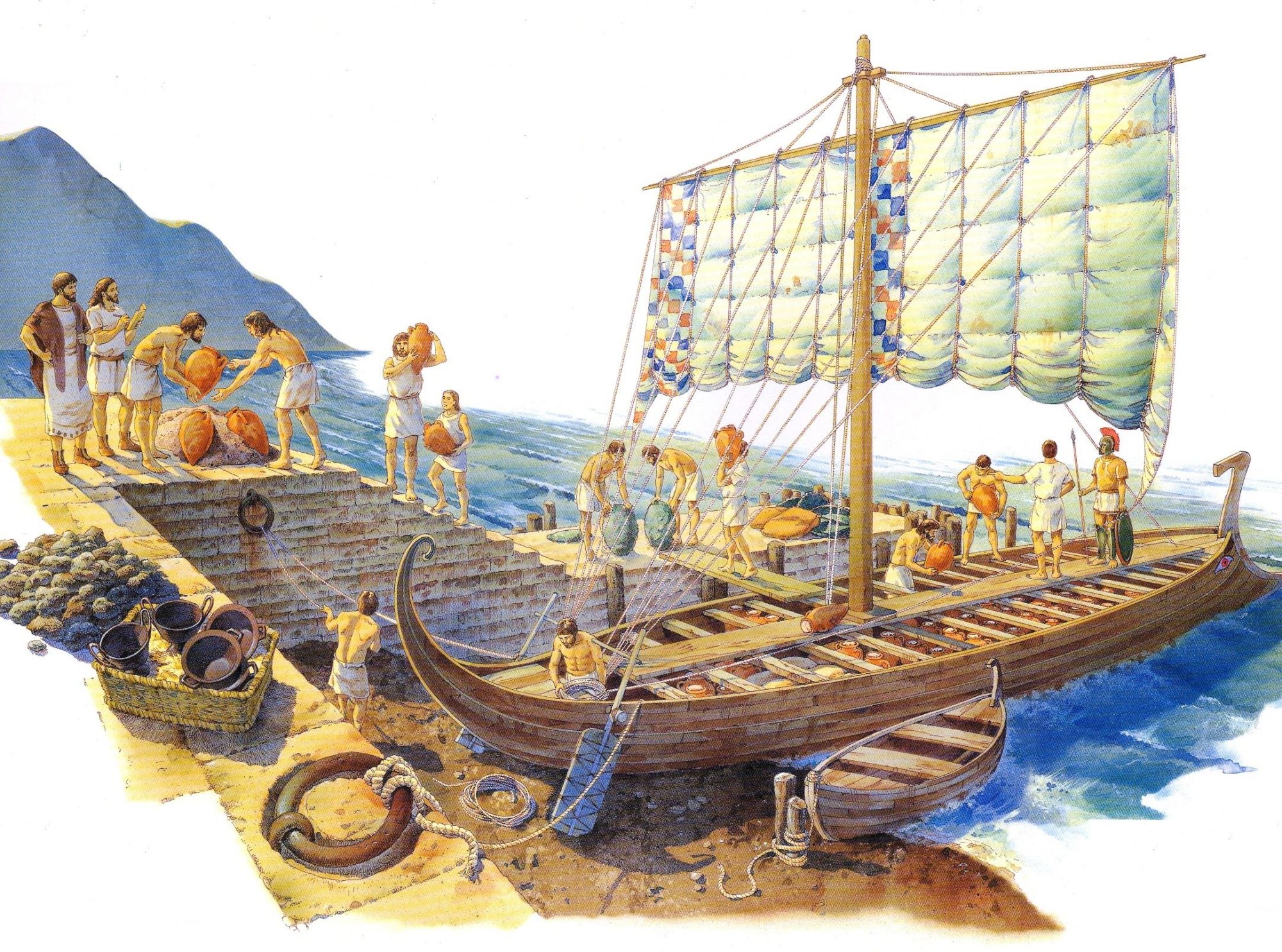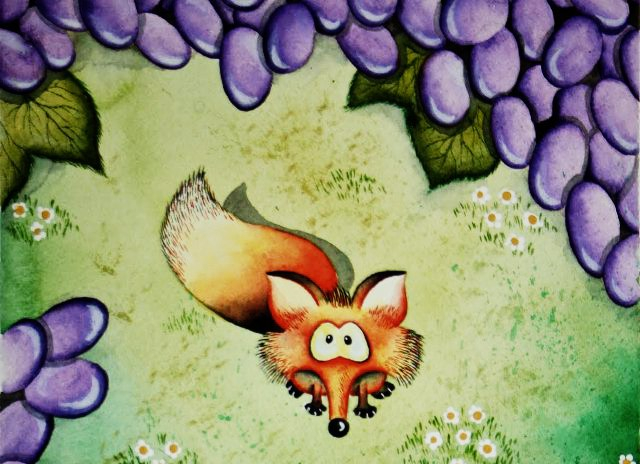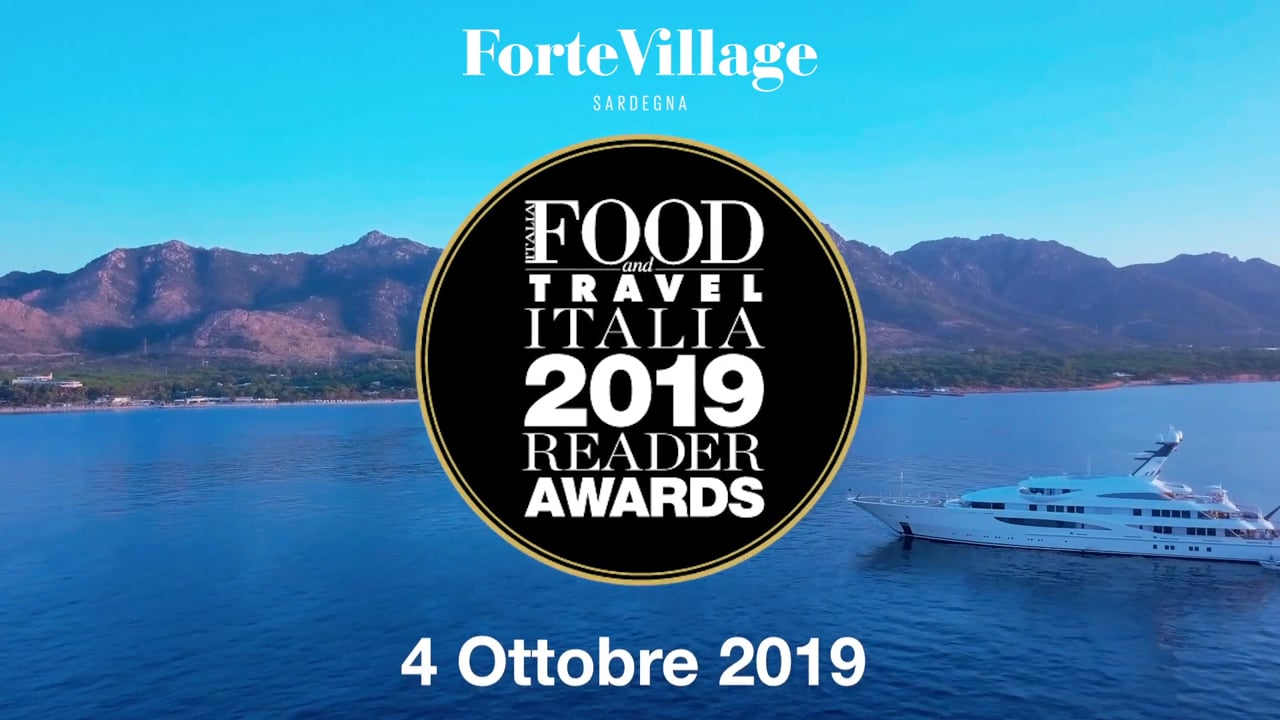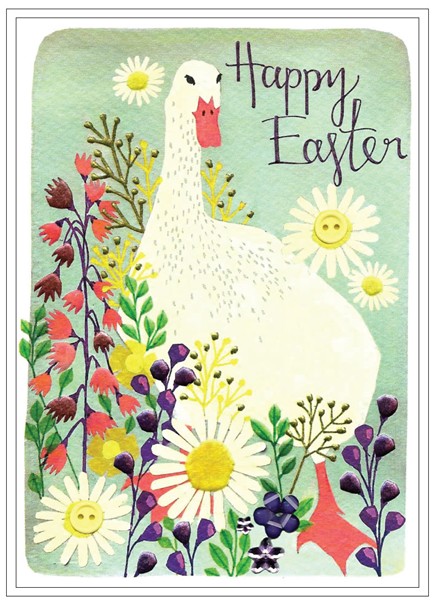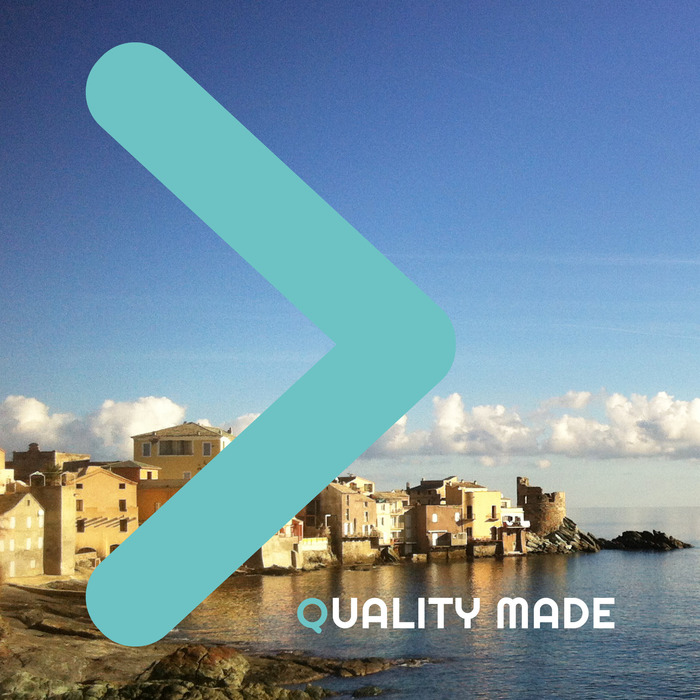What are we doing now in the vineyard: the topping
After the fruit set, this is the moment of the topping, that is, the cutting of the final parts of the growing shoots, the apex and the last leaves. It is an ancient traditional practice, recommended since the Roman agronomist Columella. Today we know why. It is not a generalized practice, but it brings several advantages that I am now trying to explain to you.
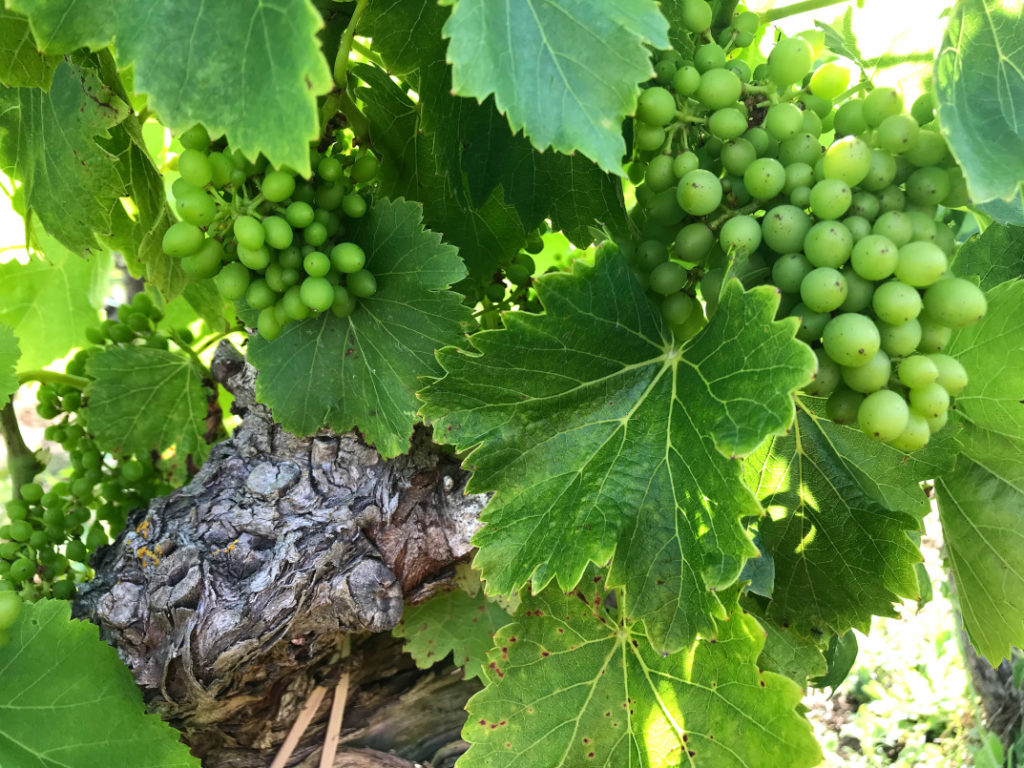
The topping is part of the large family of works called "green pruning", which modify the canopy of the plant. If done properly, they improve the production and the sustainability of the vineyard.
These practices are in general usefull to keep the canopy within certain growth limits, to avoid the risk of accidental breakage of the branches. They also serve to regulate the balance between vegetation and production. It is important that the vine has sufficient canopy, in relation to its environmental and production conditions, to accumulate sufficient energy in the form of sugars. However, it is not only a question of quantity: the sugars correct distribution between the various parts of the plant is also fundamental for an optimal ripening. Some practices of green pruning also affect these energy balances. However, the canopy must not even be too much big, for an optimal exposure at the sun of the leaves and the bunches (these, depending on the climatic conditions, sometimes is better a more exposure, sometimes they must more protected). Finally, the too overlapping vegetation creates unfavorable, humid micro-environments that favor different diseases. So certain green pruning jobs also serve to prevent pathogen infections.
Let's go into detail: why do we do the topping?
The most simple reason is to cut the very long vine shoots. The physiological implications are instead listed here, in a synthetic way:
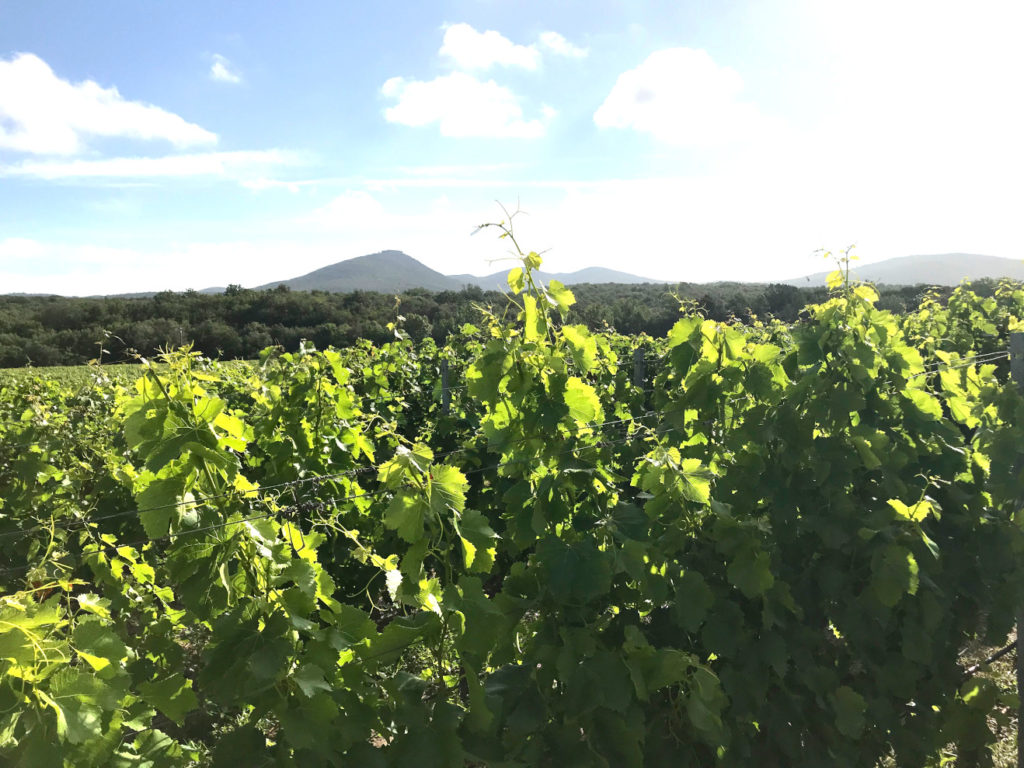
- The topping makes the vines more resistant to water stress: the apical leaves are the largest consumers of water. By removing them, the plant achieves a better balance for the available water resources.
- It contributes to the creation of more balanced wines: the cutting of the apices blocks the development in height and stimulates the lateral buds, which form the lateral shoots. This shifts the internal balance, lowers the general vigor and therefore leads to a slight decrease in the production of sugars, which, at the same time, are better conveyed towards the bunches.
- It improves the micro-climate of the canopy: the cut slightly lightens the canopy, with greater illumination and aeration of the underlying leaves and bunches, improving the general quality. Furthermore, the humid environmental micro-conditions which favor various diseases are avoided.
- It rejuvenates the canopy: at first it actually ages it, because it cuts the tips with young leaves. Later, during the maturation, the stimulation of the lateral shoots leads to the birth of many new young leaves, very efficient in photosynthesis. The leaves of the main shoot begin to age at this stage. The overall rejuvenation helps to support an optimal maturation, allowing the accumulation in the bunches of all those components that will give the wine richness and complexity.
Be careful, however: all the viticulture practices are optimal if well done. They can create problems if done wrong .
The topping is optimal at this stage, immediately after the fruit set. If done too early it blocks the growth of the shoots and limits the canopy. If done too late, its action on the delicate physiological vine balance can become more negative than positive, because it can cause a too strong decrease in the sugar content and weight of the grape. For example, in cooler climates, the late growth of the lateral shoots goes to compete too much with the ripening berries for the absorption of the energy resources of the plant, to the detriment of the latter. In warmer environments, on the other hand, late topping does not particularly stimulate the growth of the lateral shoots. The risk is taking away leaves without benefits, only getting to decrease the canopy.
How much to cut? It depends on situation, but usually it is short. Generally, too drastic cuts must be avoided: we are not pruning an ornamental hedge! As said, if the leaves are too few, we risk negative consequences. It has been calculated that the bunches need to have a sufficient number of leaves above them for optimal ripening (at least a dozen). The leaves above the cluster are those that provide the sugars for ripening. Those below send their sugars essentially to the branches and perennial organs (trunk, roots). If the vegetative luxuriance is too intense that it requires very important cuts, we must consider changing something else in the general management of the vineyard.
Although the attention I have explained is needed, topping is not a job that requires a great precision. For this reason, in a espalier system like ours, it can be done mechanically, also because it is very important to end it quickly, in the short time that follows the fruit set.
New vintage: Criseo Bolgheri Bianco (white) 2018
The wait was long but the new vintage of our Criseo Bolgheri DOC Bianco, 2018, has finally arrived.
There is always a bit of a wait, but this year has been longer than usual. Every year we finish it before the following year is released because it is a wine produced in small quantities. In fact, it comes from a single vineyard of only 0.7 hectares, Campo Bianco, located close to our ford (= Guado), before the forest begins.
The 2017 vintage had been particularly low: the drought had significantly reduced the production yields. Because of this and the more attention derived from the TreBicchieri Award of the Gambero Rosso, the 2017 vintage finished very quickly. If you are curious to taste it, there are only a few last Magnums.
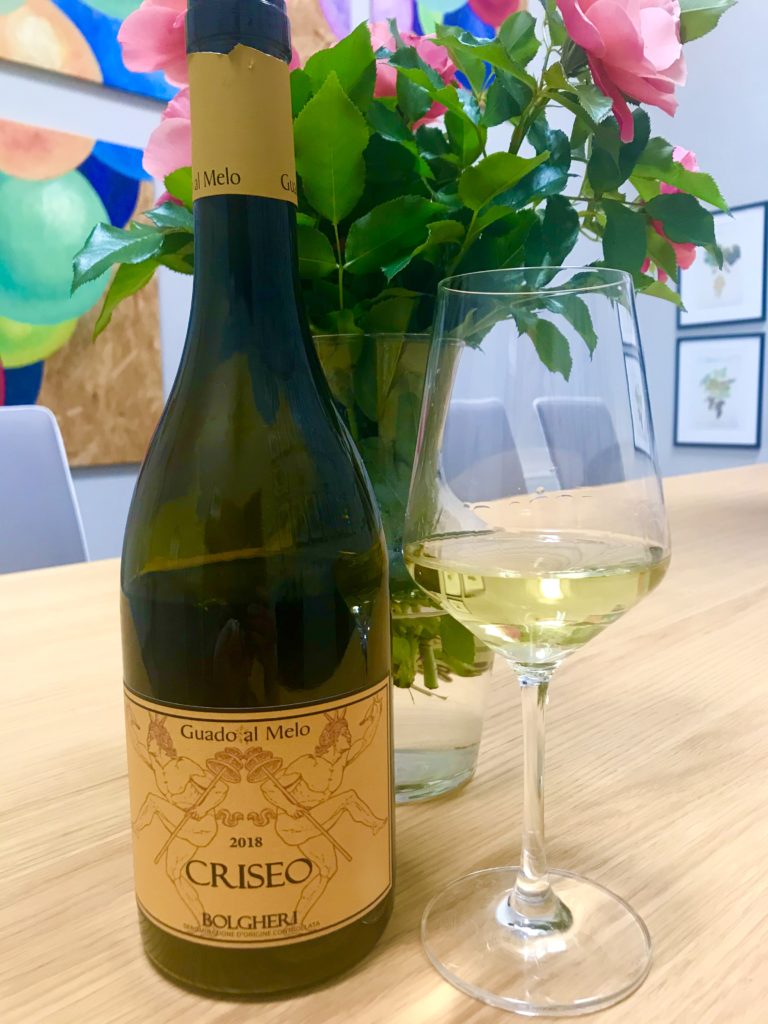
2018 was a very regular year, with characteristics of greater climatic freshness than 2017. Spring was very rainy and made it possible to recover the dryness of the previous year. Summer was instead, as normal, hot and dry, without particular excesses. Some short rains cooled the temperatures at the end of summer, without creating problems. This seasonal trend allowed a longer ripening than usual: we harvested the Campo Bianco vineyard on September 10th.
The harvest date varies with the vintages: in the hottest and driest it can be brought forward to the end of August or in the first days of September, in the cooler it can moved a little further. The important thing is to seize the perfect moment of synergic maturation of the vineyard, in which the perfect balance is found between the varieties present (mainly Vermentino, Fiano, Verdicchio, Manzoni Bianco, Petit Manseng). In this choice, the experience we have acquired in over twenty years is very important.
This wine is a field-blend. The grapes, which grew together in the Campo Bianco vineyard and were harvested together, are also co-fermented after the selection. The co-fermentation is a old traditional practice, capable of making them express a unique personality.
Its taste? It is full-bodied, soft but balanced by a great freshness. It also has an incredible aromatic complexity, with aromas that change constantly as the wine is oxygenated in the glass. Fragrances of grapefruit, tropical fruit, pastry, sage, white flowers, saffron, mineral notes, hydrocarbons are released. Over time the latter will prevail, because it is a white wine that can have a long aging, thanks to the fact that after fermentation has remained in steel on the lees for almost a year. Now, we propose it after another year in the bottle.
It is excellent now, but if you love whites with more evolved notes, such as Michele and me, you can safely keep it in the cellar (at low temperature and with a bottle lying down) for a few more months ... or a few years.
If you resist!
We are waiting for you
Our winery is open now, with special opening hours. The wine shop is open:
from Monday to Thursday 10.00-12.30 15.00-17.30
Friday 10.00-12.30 15.00-17.30
Saturday 10.00-13.00 15.00-18.00
Guided tours and tastings are by reservation only. Please, phone at 0039 0565 763238 or send a message to info@guadoalmelo.it
Spring in the vineyard: the works of this period
In this season the growth of the vine is very fast. There are so many jobs to do!
We are now finishing the green pruning works, that is, a set of different interventions that act on the green parts of the plant (leaves, shoots, branches, bunches), so called in contrast to the "dry" or winter one (which we did on the branches). We do these jobs all by hand, because we must carefully chosen how to do them for each individual vine. Let's see those of this period.
Desuckering is the elimination of shoots that arise from the rootstock of the vine, as well as those that arise from the latent buds, on the trunk or other woody branches. It is important to do this very early, before they develop too much. We also has done the thinning of the shoots on the canes of the year.
https://youtu.be/nNVu7MpobYk
All these green pruning jobs are very important to help the vine find the right balance. They allow to decrease the load of the plant, so that future bunches ripen as well as possible. They prepare also the future winter pruning, which will be easier. Furthermore, the leaf mass is made less dense, thus avoiding the creation of an humidity environment conducive to the development of mold or other diseases. Finally, they also prevent blossom dropping problems. In general, compared to the flowers produced by each vine, only 20-50% (depending on the variety) will be fertilized and will set, that is, it will form the fruit. There is a problem when the blossom dropping is higher than normal for the variety. It can depend on physiological imbalances, difficult climatic conditions, nutritional deficiencies, various diseases (virosis, downy mildew, powdery mildew, vine moth, ...).
The work we are doing now is the arrangement of the branches in a vertical position. In espalier systems like ours, this is done by lifting a pair of parallel wires. The effects are numerous: the branches do not invade the inter-row and we do not risk breaking them in the passageways with the tractor, they are better distributed and less bundled. The vertical position, as I already explained in the post on pruning, increases the physiological activity of the shoots.
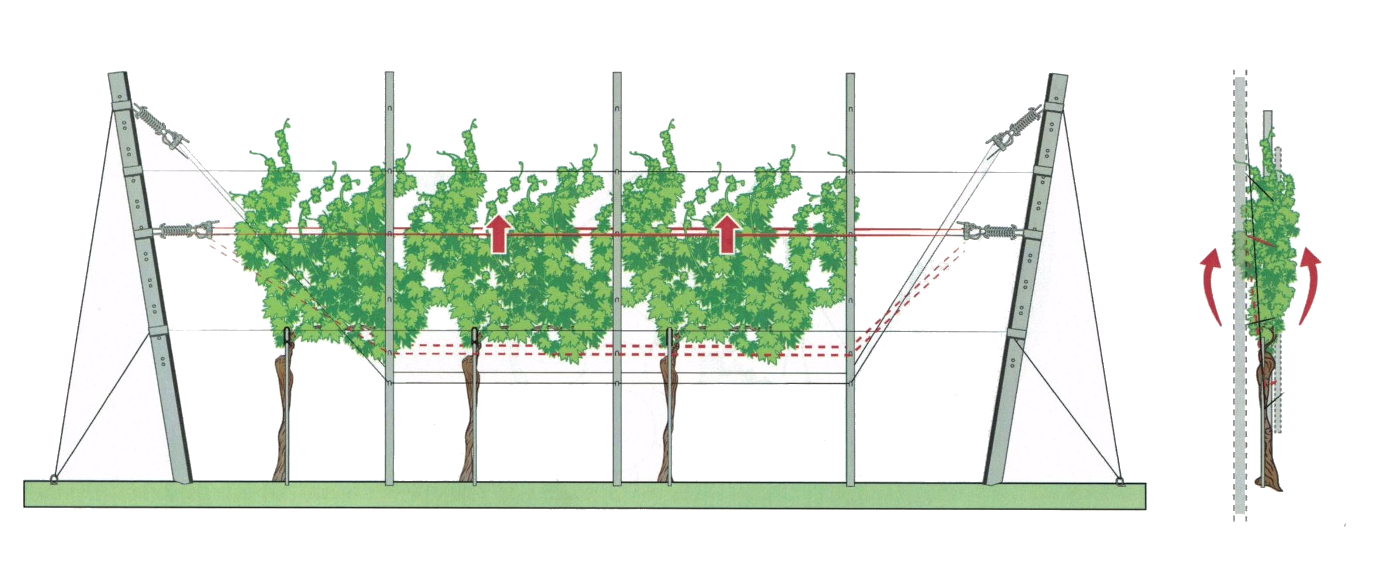
In this period it is also very important to understand, as soon as possible, if there are nutritional deficiencies in the vine. However, a dedicated post will be needed on this complex argument.
Depending on the environmental conditions, we must also take action to avoid the problems caused by powdery mildew and downy mildew, according to the principles of integrated pest management (sustainable viticulture practices). In this spring 2020, at least for now, we are more at risk of powdery mildew than downy mildew, as is usual for the climatic conditions of our territory. Downy mildew is a problem in the most humid and rainy areas. As for the vine moth, we have already distributed traps and systems of sexual confusion (biological control) in the vineyard.
Make every day Earth Day
Today is Earth Day but we must remember it every day, with actions than with words. We, as winegrowers, know that if our work is not sustainable, it cannot have a future.
For this reason, we choose every day the current best practices of integrated sustainable viticulture, which garantee 0 residues in wine and the environment, as well as a rich biodiversity in the vineyard.
For this we have built an underground cellar, which "disappears" in the landscape, which allows us to save 70% of energy, with a rainwater recycling system that reduces consumption by 40% (for all internal uses for which no drinking water needed).
For this reason, in the cellar we work with craftsmanship, respectful of the grapes and the exaltation of our most precious heritage: our territory.
More info on our website www.guadoalmelo.it
Renewal of our vine and wine museum
This suspended time is ideal for arranging the winery, to be even more beautiful and welcoming for when you can come back to us. These signs had broken by the wind. I took the opportunity to renew them.

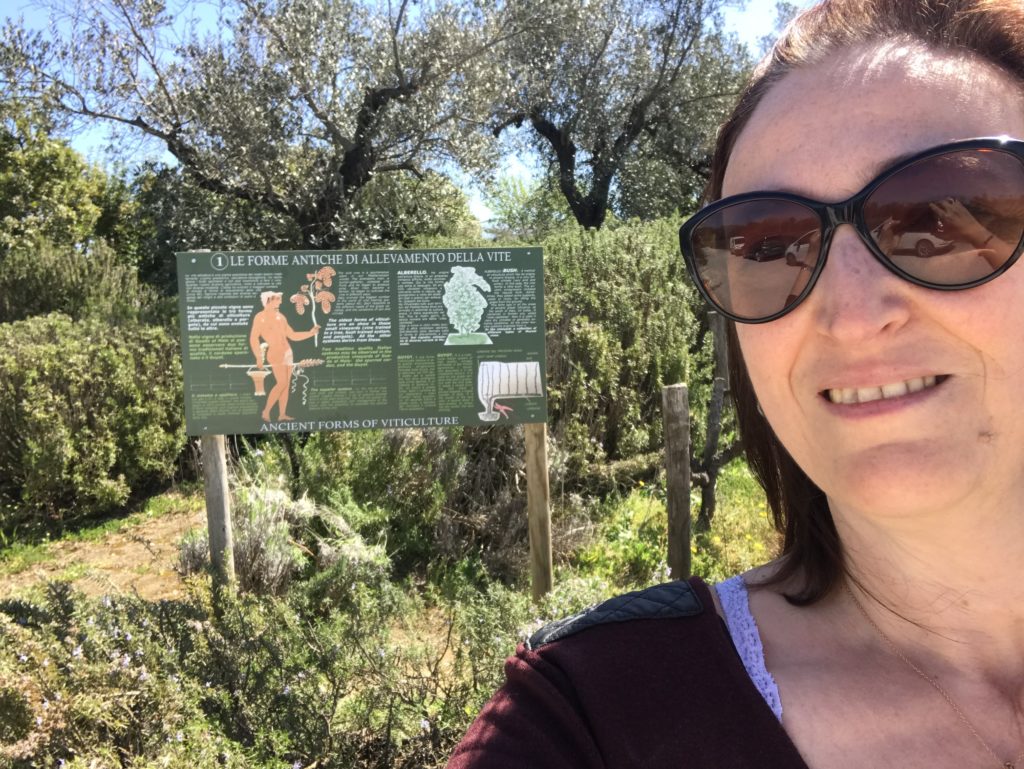
Happy Easter
Dear friends, happy Easter to all!
We wish you the best, even if at this moment it is really difficult to find words of hope, with so many deaths and suffering people, struggling economy, politicians who give us only empty words, …
Yet, Albert Camus wrote that hope (alone) equals resignation. And to live is not to resign oneself.
As you, in general we always show our happy and optimistic face, but our work is already made of thorns and roses.
We work with nature, that can fill us with satisfaction and joy, but sometimes it gives us terrible blows: the drought, the frost, a bad year, ... Furthermore, we have to fight with a suffocating bureaucracy, the importer that suddenly leaves us, the tractor or the bottling machine that breaks suddenly (a tad more than petty cash!), ...
That's why we are used, as you, to being strong against the life's obstacles, to reinventing ourselves, to work as much, as and more than before. This virus is one of the worst blows for all of us, but it doesn't scare us: if it not will take down us, it will make us even stronger.
So, we wish you to have strength. Let's stand strong, for us and for our loved ones, for the less fortunate, for those who cannot really make it alone.
Everything will be fine, but only if we work hard for it.
... and don't forget to drink an excellent wine, the best remedy for the spirit!
Annalisa and Michele Scienza
photo: Katrin Pfeifer
Rute, new vintage 2017
I had to write the data sheet of the new vintage of our Rute Bolgheri Rosso, 2017. I thought about what Bolgheri is for us: it is our home simply. So, I looked for what we (Michele, me and our children) mostly love of our living here, and I described it like this, in few lines:
"Bolgheri was a very difficult, harsh,
and waste land for centuries.
Today it is a Mediterranean garden,
with a still somewhat wild beauty.
For us, it is our home,
which has the scent of the hill paths
in the scrub, of the salty sea smell
in the sand dunes,
which has the sound of the waves of the sea,
of the cackles of the boys
who are bathing in the ford*, …
Rute is this Bolgheri, familiar to us,
that we look for in the earth and
in the stones of our vineyards,
in our craftsmanship."
What do you say?
*Guado al Melo means “ford* at the apple tree”. There is really a ford near our vineyards, where our children and their friends have played.
Viticulture in Rome and the rediscovery of the Genius Loci
The Romans were great winegrowers. At the time of their agricultural acme, they had reached good empirical knowledge of the vineyard practices (with the due limits). Later, it will take centuries to recover these skills. Among these knowledge, the truly disruptive element of Roman viticulture, which will mark the Italian (and European in general) vine-wine culture up to the present day, was the understanding of the inseparable link between wine and territory.
Roman viticulture knowledges were built in centuries, from a primitive viticulture of the origins to what is considered the apex, the second part of the first century BC. In this period Columella lived, who is considered the first agronomist in history. His work "De Re Rustica" is so precise and detailed that it is considered the first real agricultural treatise ever. The agrarian authors after him will essentially resume its contents and not for a short time: Columella will remain as the main reference for agriculture at least until the end of the eighteenth century.
[one_third][info_box title="The choice of soil, climate and varieties according to the ancient Romans" image="" animate=""]Let's see what the agrarian Latin authors wrote about wine and territory, especially Columella.
Columella writes numerous reflections on the choice of the place of the vineyard, in relation to the soil and climate, and the consequent choice of the most suitable varieties. Not all of his considerations are correct, in light of our knowledge, although many are so (albeit generic). What is relevant is that the Romans understood the importance of these relationships more than two thousand years ago.
Columella writes that the best soil should not be too clayey and not too light (today we would say medium-textured), but get closer to the latter. It must not be too poor and not too fertile, but better similar to the second. The steep terrain is not the better, not even the extreme plain. The better is a more or less inclined plane (to drain the water). It is necessary to investigate the type of land, even underground, and not only look at the surface. The best choice, however, is to experiment with the different types of soil, to understand the different production responses.
In general, however, if the soil is suitable for giving pleasant and precious wine, it is better to plant varieties that are not too productive, but not too little either. If, on the other hand, the soil is not so good, it is better to plant a very fertile variety, to have a good yield in quantity.
Nel piano si ha vino più in abbondanza, nelle colline quello più gradevole. Le vigne inclinate verso il nord sono più fertili, ma quelle verso il sud danno il vino dal gusto migliore. Nei luoghi freddi è meglio avere l’esposizione a sud, in quelli tiepidi è meglio l’est, purché in entrambi i casi non siano esposti a venti provenienti da quelle direzioni.
We know the names of many Roman varieties, in fact they have been listed in several ancient texts. It is really impossible to connect them to modern ones. The names changed even at that times. Varieties that are listed by Cato are no longer named by Columella and Pliny, who write 200 years later. Even these two authors, who are contemporary, sometimes list different names. Anyway, I don't write the varieties, also because they can be found everywhere. It seems to me more interesting the part where Columella explains the choice of vines in relation to the territories.
He writes that, when you have to make a vineyard, you must be personally informed about the best vines to plant and do not entrust the purchase of the cuttings (viviradicem) to others. Better still is the internal nursery (vitiarium). It must not be placed in a soil of worse quality than that of the vineyard.
The farmer must understand that the varieties of vines that resist fog are suitable for the plains, instead those that tolerate drought and winds are more suitable for the hill. So, in the fertile soil, the not very vigorous vine will be planted, in the poor soil the most vigorous vine, in the dense soil the strong vine that produces many canes. The vines that produce large and soft berries are not suitable in moist soil. Those with small and hard grapes are better. Different varieties can grow in well-drained soil.
The winegrower, however, must not only to pay attention to the soil but also to the climate. Where there is colder and fog, the early vines are better, the fruits of which ripen earlier or those that have robust and hard grapes. Where there is a lot of wind and storm, robust vines with hard berries will also be planted here. Where it is very hot, the most tender varieties and that have the most compact bunches are the best. In the most placid and serene places, you can put all sorts of vines, but the early season ones are the better.
The wise winemaker in addition to the best vines, should always plant different varieties, because each can respond differently to the adversities of each vintage.
From Columella description, we can also understand that the common practice at the time was the field-blend vineyard, i.e. with multiple varieties mixed together, as remained in Italy (and other European territories) for centuries to come. According to Columella, however, it is better to arrange the varieties separately. He lists the advantages of this choice. Not all of them bloom and mature at the same time. It is not easy to collect together grapes with different maturity: if you wait for the later grapes, the first ones are eaten by birds and damaged by winds and rains. The separation also allows the vintner to know how to prune each of them, because at that time there isn't the leaves to make the typology understand. In addition, the winegrowers can choose to plant each species in the part of the vineyard best suited to its characteristics, for the soil or with the right exposure. However, Columella admits that it is often difficult to implement this principle, also because most of the winegrowers cannot distinguish the different varieties. However, if not possible otherwise, Columella writes that at the least it is better to plant together those varieties that have similar taste and similar maturity. We can find identical considerations to Columella's ones in numerous texts of the agronomists of the nineteenth century. As Columella, also they tried to ferry the viticulture of their times towards more rational forms!
The vineyard with more varieties is called by Plinius vitis conseminea, conseminales vinea by Columella.
[/info_box][/one_third]

In his and in other Latin texts, it is underlined and examined how each soil and climate require the choice of the most suitable grape varieties, the different choices of work approach and the production of different types of wine. This, linked to the fact that the Romans first identified wine with the place of origin and the year of production, makes us understand that they were the first to conceive that fundamental concept that we commonly call today "terroir".
The Romans had not given a name for this concept, just as it will not be done long in Italy and in the rest of Europe. Yet, it has been a tradition for millennia.
This concept was examined in depth in more recent times, within that long process of transformation of the twentieth century wine sector, that is the basis of the birth of modern wine. In particular, this argument was mostly discussed after the Second World War.
In this period many scholars and experts began to reflect deeply on the concept of wine and territory, as a basic element of wine European culture.
Its definition is not simple, as it is made up of many factors. The first, the most obvious one, is certainly the territorial one in the strict sense, linked to the geographical characteristic, therefore soil and climate. In relation to these pedo-climatic differences, there are also the different answers that each grape variety can give in a different territory or micro-territory. Furthermore, the annual variations of these elements, linked to the vintage, must be considered. However, not only the "natural" elements intervene. A territory is also linked to the local traditions, their transformations over time, the transformation of the landscape by the man, the history, the local wine culture, the production choices, etc.
The scholars understood necessary to find a name to express this so complex concept. The word "territory" is limiting, too common, and therefore possible cause of misunderstanding. The easiest mistake, which many persons still make today, is to reduce it to the pedo-climatic characteristics only. Thus, two terms were born: Genius Loci and terroir.
They are different? No, they express more or less the same concept, but they are born in two different cultural spheres.
The Genius Loci
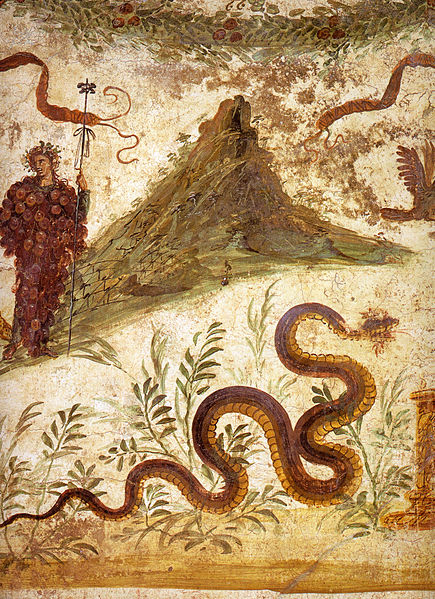
In modern times, the Latin locution Genius Loci was first introduced in architecture, inserted in the historical reflection on the concept of place. From here it was transferred to the concept of wine territory.
What does mean Genius Loci?
In ancient Roman times, the Genius (from the verb gignere = to create, to generate), was a tutelary spirit, a benevolent god who watched over every person. More or less, the same concept was present in Greek culture, where it was called daimon. It was not only proper of the individual, but also of the community: there were also a Genius of the family, of the Province, of the State, of various associations, etc. The concept was also extended to places, with the name Genius Loci, the genius of the place (locus). It was a benevolent caretaker who watches over it and the people who lived there or even a sort of personification of the place. According to Servius:
"nullus locus sine Genio est" (no place is without a genius).

Virgil, in the Aeneid, describes it (him or her, the Genius may be masculine or feminine) as a big and slimy snake that crawls out of the depths of the earth (book V, 84-75). It was often depicted as a snake, an animal considered a symbol of luck. Its image on the walls of a building was the expression of the desire to put it under the protection of the Genius Loci. Often it is depicted as a snake wrapping himself around an altar, where it goes up to devour the offerings that people have been made to him.
To have its benevolence, it is necessary to respect its place, to invoke its protection and to offer it perfumes, flowers, fruits, focaccias and wine. Then, the Genius would have been benevolent, it would have revealed himself/herself filling the place with sacredness and lucky. On the other hand, if the person had been hostile to the place, devastating it or exhausting its resources, then the genius would have been antagonized. It would have denied itself, it would have emptied the place of its presence, thus causing misfortune.
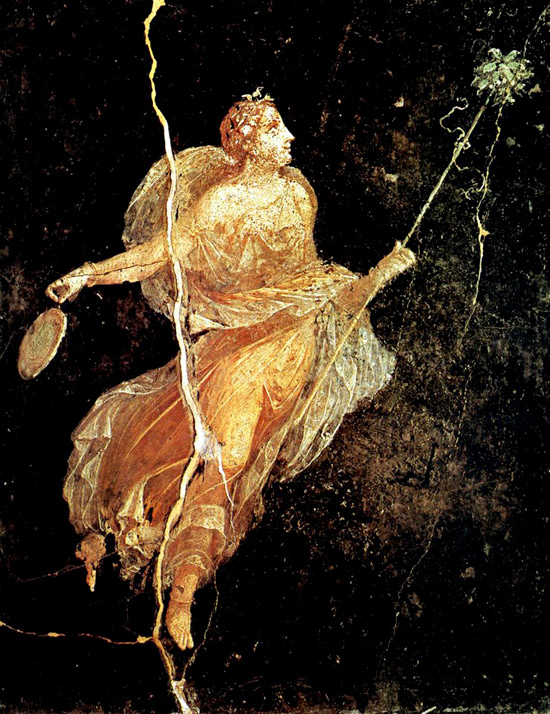
Sometimes, the Genius is represented as a human figure, surrounded by symbols of plants and animals typical of the place. The more common picture of the Genius was a winged person, from which the depictions of the Christian angels are derived.
These beliefs will however be assimilated into Christianity in the figures of the Guardian Angels and Patron Saints.
The architects Aldo Rossi, in the late 1960s and, above all, the Norwegian Christian Norberg-Schulz, a decade later, were the first to introduce the figure of the Genius Loci in the modern debate on the meaning of "place". The Latin locution Genius Loci thus began to be used to define the complex multiplicity of those elements that constitute the deepest identity of a place. They include all its intrinsic characteristics, made up of geographical and structural, natural and artificial elements, but also by immaterial and changeable elements, such as historical and cultural stratifications, the very way in which the observer perceives it, its character, the colors, the variations of the light, etc.
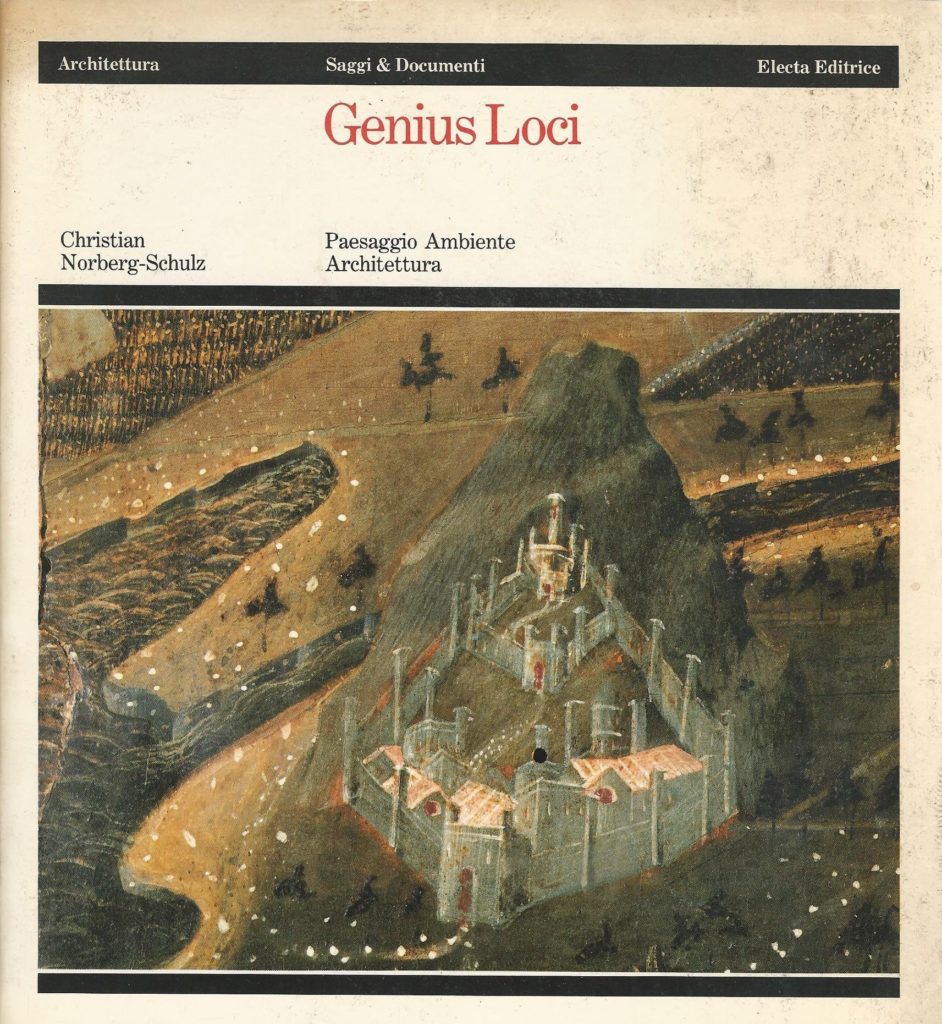
Few years later, prof. Attilio Scienza, taking inspiration from the architectural debate, proposed the use of the figure Genius Loci in the wine sector, to powerfully recall that link between wine, territory and culture, inherited from the Romans.
The birth of the "terroir"
At about the same time, this reflection was also maturing in France, starting from the same cultural background: all European wine territories are heirs of Roman viticulture.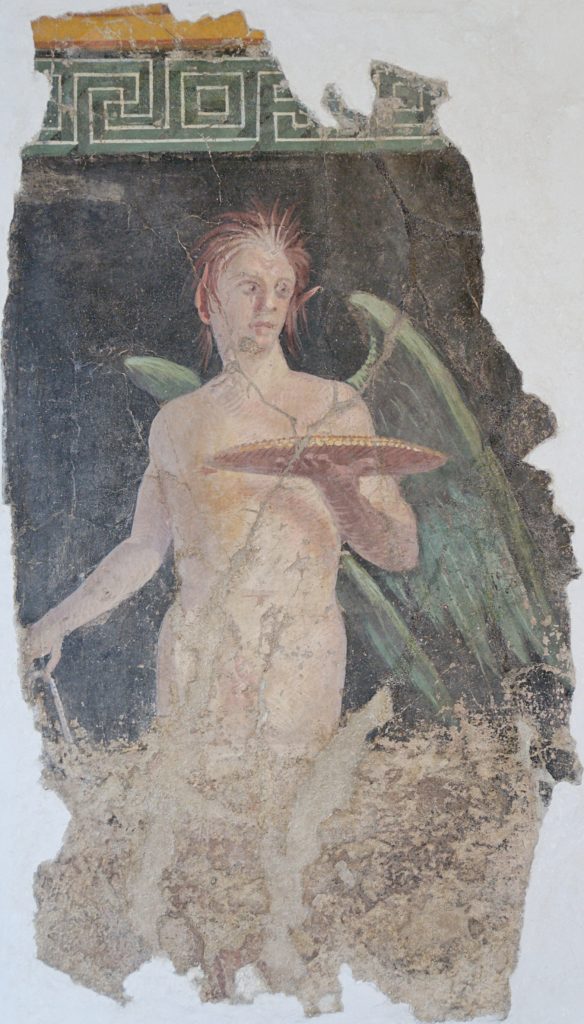
The French scholars made this concept explicit with the term terroir, which began to be used with this meaning more or less from the mid-1900s. Until then, this word was an archaic synonym of soil or territory, not commonly used in modern French. It was an archaism used mostly in agriculture. Oddly, in the XVIII-XIX century the word "terroir" has been derogatory. The "goût de terroir" (terroir aroma) indicated a negative aroma of the wine. "On dit que le vin a un goût de terroir, quand il a quelque qualité désagréable qui vient par la nature de la terre où la vigne est plantée". "It is said that the wine has the taste of the terroir when it has some unpleasant quality that comes from the type of land where the vine was planted". (Louis Liger, “Dictionnaire pratique du bon ménager de campagne et de ville”. Ribou, Paris, 2 t., 449 & 407 p.).
In the 70s-80s, prof. Attilio Scienza committed himself to spreading the concept of viticultural territory as Genius Loci, with a view to highlighting its productive and cultural importance, but also to underline our "birthright", as Italians, of a cultural heritage born in Italy, using a Latin name.
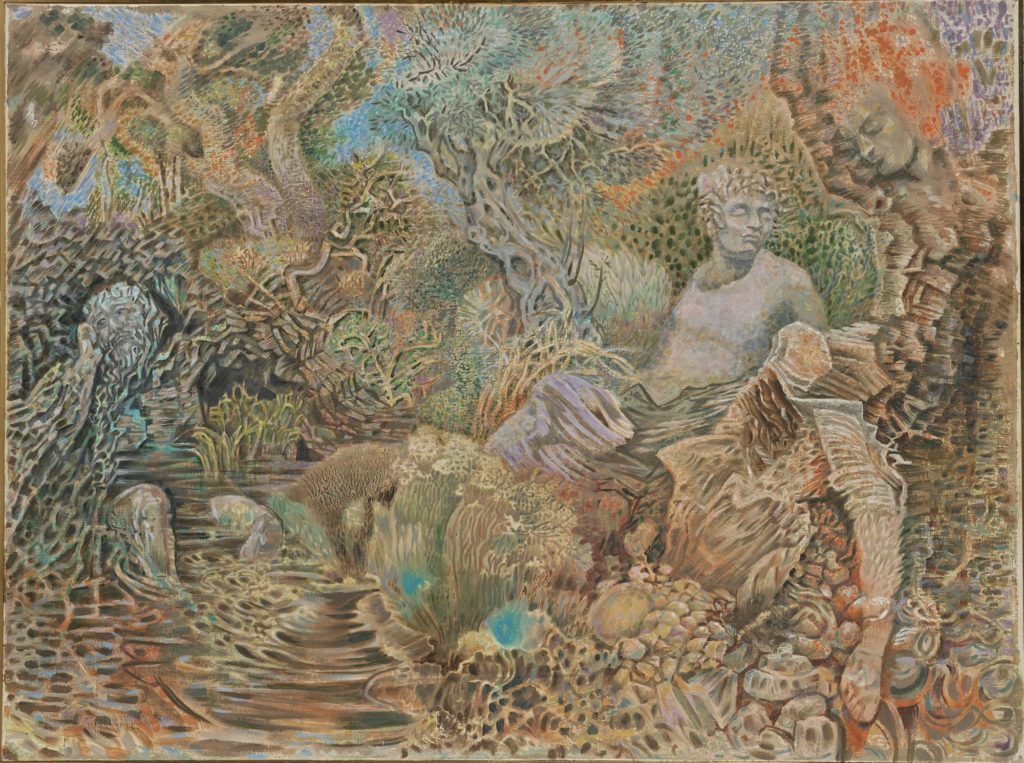
Unfortunately, the world of Italian wine did not understand the centrality of this aspect, as well as the great communication on Italian wine in the world that would have derived from it. Later, when Italian wine-producers began to understand the importance of narrating their traditional relationship between wine and territory, they had to accept the use of the French word “terroir”, which in the meantime had emerged in the world. In fact, our neighbors (unlike us) had understood the importance of this concept first. Then, the word "terroir" was amplified and consolidated universally by Anglo-Saxon wine writers. Today, sometimes, the French claim to have also invented it! Sic transit gloria mundi (as Latins said)
I can't hide being biased. My Latin soul makes me love the term Genius Loci more, also because it seems to me that it explores greater depths! It is so fascinating the image of a genius who gives us favors or misfortune as much as we love and respect our land!
However, beyond primogeniture and words, the fact remains that nothing like the concept of Genius Loci (or terroir) is able to represent the truest soul of artisan wine, from over two thousand years. There are people who say it is something impalpable, difficult to explain in detail or to understand rationally while tasting a wine. On the other hand, it is its nature: in part it is explained by science, but it also has something elusive, complex, easier to understand only with the intuitive side of the mind. Anyway, when I'm doing my work of winemaker, however, I always realize that nothing is more real and alive in our wines than it.
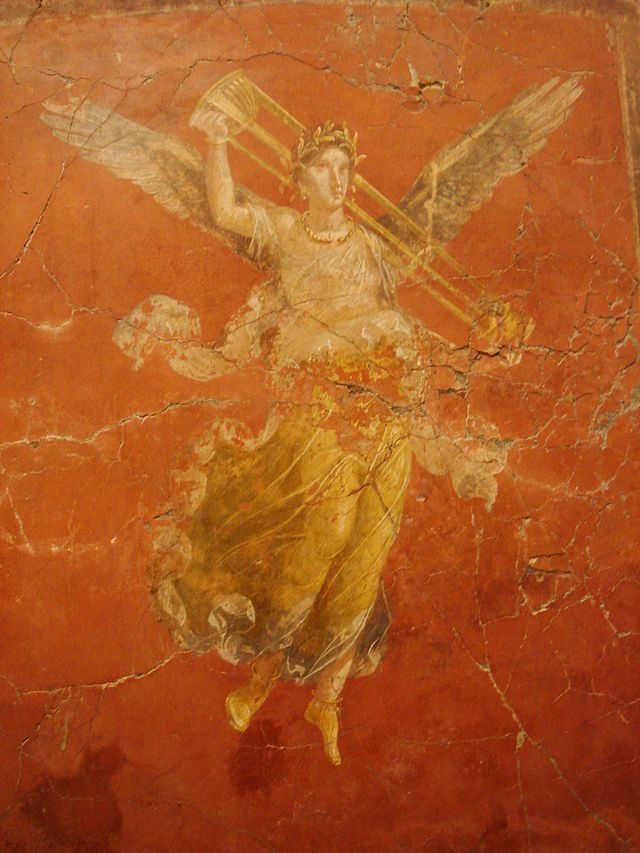
The images without caption are mosaics and frescoes from the Roman era.
Bibliography:
Columella, “De re rustica” , 65 d.C.
Giangirolamo Pagani, 1794, Rustici Latini Volgarizzati, Lucio Giunio Moderato Columella, ed. Vittorio Curti Venezia.
Attilio Scienza et al., 2010, Atti del Convegno “Origini della viticoltura”.
Luigi Manzi, 1883, “La viticoltura e l’enologia presso i Romani”.
Dalmasso e Marescalchi, 1931-1933-1937, “Storia della vite e del vino in Italia”.
Emilio Sereni, 1961, “Storia del paesaggio agrario italiano”,
Marcella Peticca, "Genius Loci: perdita e riscoperta del luogo", 2015, Università di Bologna.
P. Prévost, P. Morlon, J. Salette, "Le Mots de l'Agronomie", 2017, https://mots-agronomie.inra.fr/index.php/Terroir
https://www.romanoimpero.com
We are closed
As known, we are in an emergency Corona virus. So we adjust to the rules and we are closed. if you want our wines, we ship them your home. Write me at info@guadoalmelo.it for info.
We are closed at least until April 3 (inclusive), then we'll see.
The vineyard balance always stars with a good pruning
In these days we are doing the winter pruning in the vineyard, which is the most important of all the works to direct the vines to a harmonious balance. I will try to make you understand broadly how and why we do this work.
First of all, I would like to emphasize that nothing must be improvised in the winegrower's work: we rely on a thousand-years peasant knowledge, then deepened by the studies on the physiology of the vine and its relations with the environment around it. Only a good knowledge allows to respect its balance and intervene in a respectful but useful way.
It is important not to make mistakes in the pruning, otherwise we will not be able to produce great terroir-expressive wines. Making a mistake (or making a bad pruning due to lack of skill or lack of competence) has the result of limiting the expression of the full potential of the vineyard and / or damaging it to such an extent as to shorten its life.
[one_third][info_box title="What happens if the vine is not pruned??" image="" animate=""]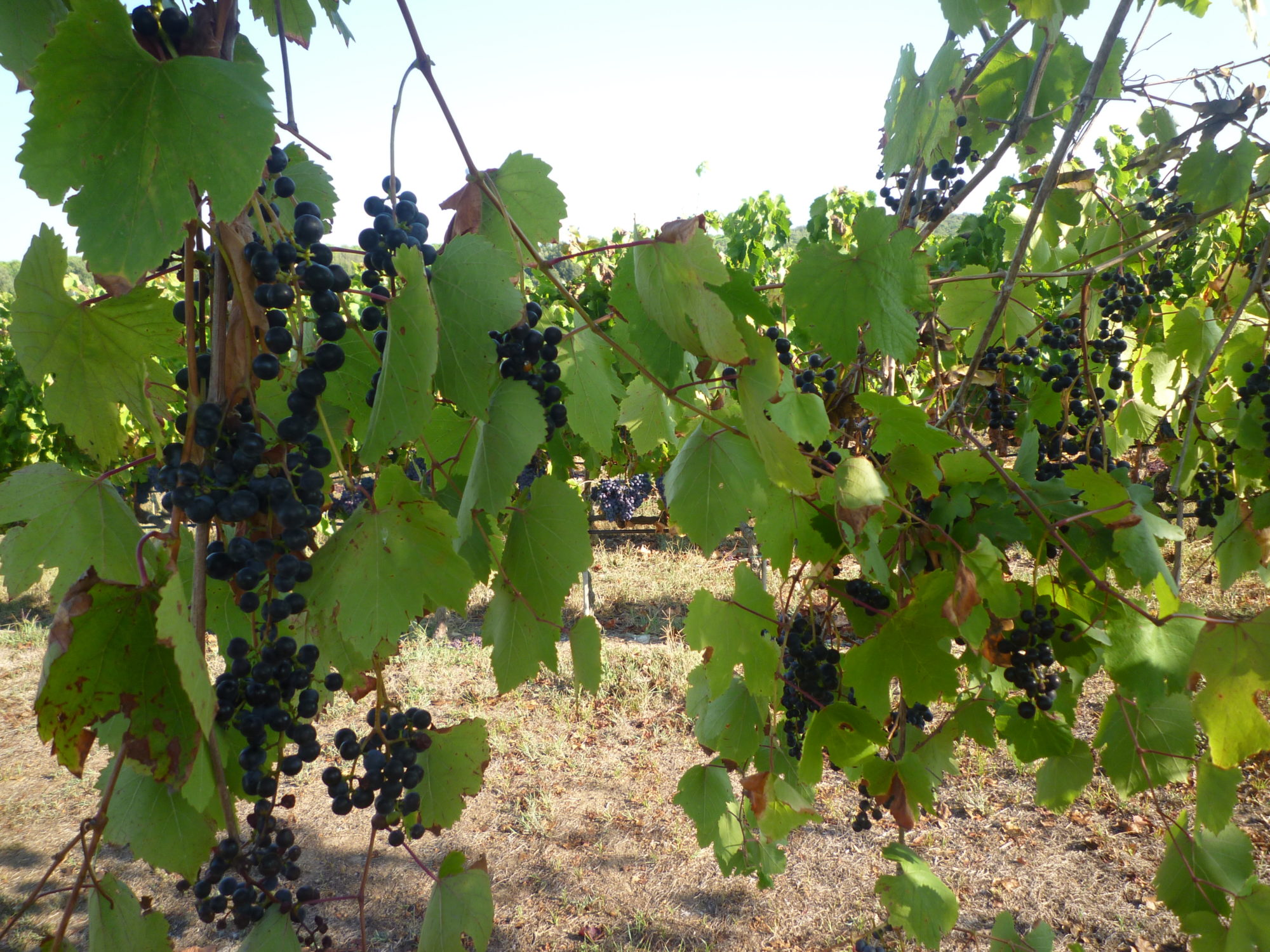
If you do not prune, as happens to wild vines in nature or as it was done in the forms of primitive viticulture, the plant tends to grow a lot and produce many bunches. They are small, not very sweet and not very balanced. It is a grape that is good for feeding wild animals or for making a rudimentary wine.
However, the first winegrowers began to understand with the experience that, by pruning, they managed to produce a better, sweeter grape, and they were able to produce a much more interesting wine. From then on, this practice was no longer abandoned but refined, to the point of becoming almost an art.
The unpruned vine also has a significant production alternation. It means that a year there is an abundant production, the following year instead there will be very little grapes or practically nothing, and so on (beyond the normal fluctuations of the year production, linked to the seasonal trend).[/info_box][/one_third] In practice, when the vine is on dormancy, we cut the branches of the past year, leaving a certain number of buds. This number is carefully evaluated, because it determines the production of the following year. The number and distribution of the buds also define the living space of the plant, that is what is called the vine training system. It is important because it determines the balance between all the parts of the vine (trunk, roots and canopy), in relation to the environment in which it lives.
The cut should be evaluated vine by vine, vineyard by vineyard. It can only be done by hand, by expert people. No choice is random in the good management of the winegrower: if you have the patience to go through with this post, you will understand it.
However, it is not the only work that acts on the overall balance. So, it must be done with an overview, starting with the birth of the vineyard itself, its story over time and already thinking about the subsequent works. Everything must be integrated in the vineyard management.
When pruning:
Pruning is done when the vine is in the winter dormancy phase.
The time of pruning affects that of the spring budding. The sooner you prune and the sooner the vine will sprout (and vice versa). Generally, we winegrowers want to prevent an earlier budding, because there is often a great risk of bad weather at the beginning of spring. There could be frost or hailstorm, which could damage the shoots. For this reason, generally, we prune as far forward as possible. However, it depends a lot on climate: the risk is maximum in northern Italy, minimum in the south (with all the possible intermediate variables). The big risk for our territory is the frost due by the north or north-east winds.
It must also be taken into account, especially for those who are in colder climates, that some varieties bear winter frost less well if they have already been pruned. In this case, it would be better to wait until the coldest period has passed.
Finally, the winemakers have to deal with their own forces and the size of their vineyards, to calculate the exact times. Pruning must be finished, in any case, before the "vine weeping", i.e. the emergence of droplets from the cutting points of the wood. It is the signal of the restart of the sap circulation in the plant, the first sign of the forthcoming development of the shoots.

The tools of the pruner.
In the past, the winegrowers used different cutting tools for each region of Italy. The billhook was mainly used in the north. In the center and in the south, different shapes of "pennato" were prevalent (in the drawing: it is similar to a billhook, but with the addition of a second blade. This pruning knife shape dates back to the Roman period). These tools were difficult to wield: it was easy to injury yourself, to injure the plant too much (with the entry of diseases and pests) and it takes strength. In the nineteenth century, the pruning shears (or secateurs) began to be used and the work started to be a little easier. Today we still use them, sometimes electric or pneumatic ones, to reduce fatigue and hand usury. The saw is used only for cuts of particularly large branches, or parts of the trunk.

Pre-pruning is often done for sustainability reasons (as we also do it). It is a very coarse cut of the branches, made with the pre-pruned machine. Then, the pruners will make the handcrafting precise cut. Pre-pruning eliminates the waste of time and the effort to untangle the long branches, wrapped around the wires and between them. Speed is important because, as written, the working time frame is often not very wide.
What do we do with the canes?
As tradition, we break up the branches cut in the vineyard and use them to make compost, useful for recovering organic substance. Someone burn them, but it is not environmentally friendly and it is also a waste. The vegetable compost, which we also do with all the other plant remains (stalks, grass, etc.), contributes to enriching the soil above all with nitrogen, calcium and potassium. The high biodiversity index of our vineyards favors the mineralization of the organic substance and the correct distribution of these nutrients.
Let's go into detail:
A very delicate and complicated balance

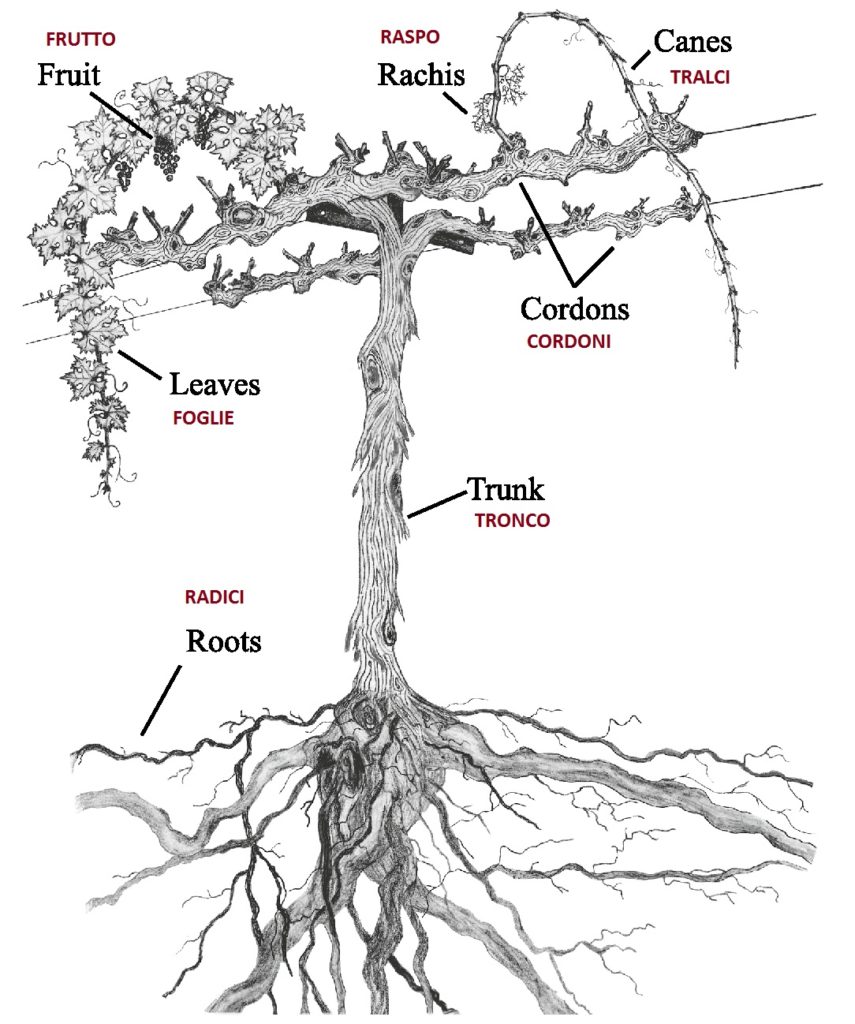
The vine directs its energy to different purposes: the growth of all its parts (woody and green), the formation and development of the bunches, the accumulation of sugars and other organic compounds in the grapes, the storage of reserve substances. All these functions are fundamental for an optimal vine balance (and the vineyard as a whole) so that it grows well, gives good grape and has a long life.
Pruning (with other subsequent works) acts on the regulation of the vigor of the vine, directing its energy first of all to the production of balanced grapes, but it is always necessary preserving a harmonious development of the plant.
The pruning is heavily conditioned by the territory (climate and soil), variety, rootstock, etc. A well-knowledge of these all elements are indispensable to do the optimal choices. Depending on the different conditions, it may sometimes be necessary to stimulate the vigor of the plant, sometimes it is better to limit it.
A too vigorous vine tends to grow a lot in all its parts, producing a lot of grapes, but they will be low-quality. Even a too weak vine will not produce the best wine it could express. It lacks energy and cannot accumulate all the necessary organic compounds in the bunches. Furthermore, it would not feel good in general: it would not be able to carry out the vegetative renewal, to deposit the reserve substances in the perennial organs. This would compromise the balance of the plant, including the optimal work of the roots, with important repercussions on the present and future life of the vine.
In both cases, there would be produced poor quality grapes (for opposite reasons), which will ripen badly. It is not just an unbalanced accumulation of sugars (too many or too few). It will also be a grape that will produce a wine with an unbalanced acidity, which could maintain herbaceous characters, which would not be able to develop aromatic complexity, etc.
[info_box title="Life cycle and buds" image="" animate=""]The vine life is a circle: it sleeps in winter, wakes up in spring, sprouts, grows, bears fruit and goes back to sleep. However, it is not a closed cycle: each year it is closely connected to the previous one. The buds that will sprout next spring were formed the year before. They are called dormant or latent buds.
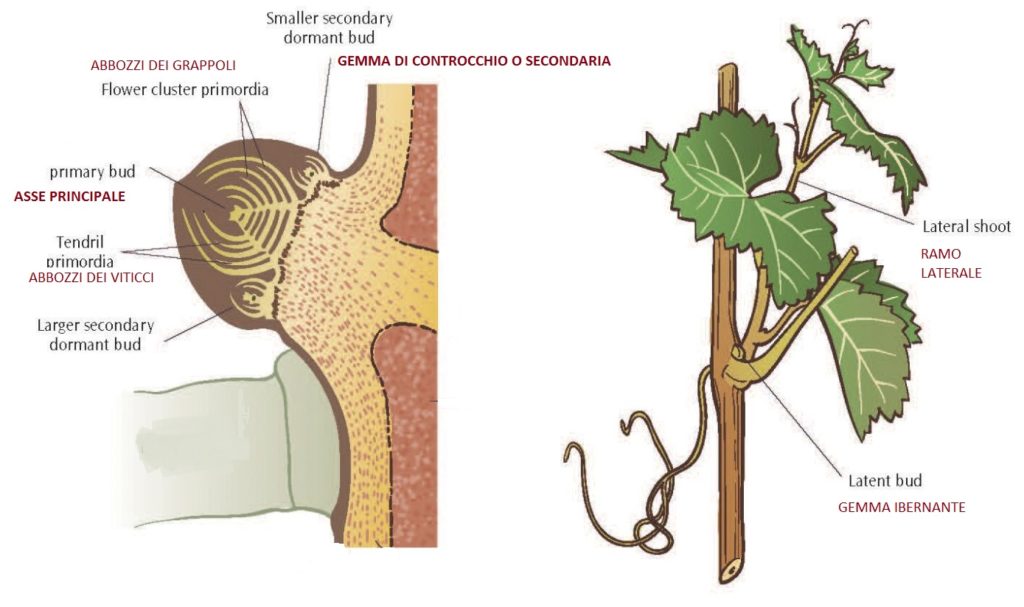
The dormant buds wake up in the spring, sprout and form new canes. Leaves, clusters, tendrils and new buds are born on the internodes of the canes. There are two kinds of buds: the latent and the lateral one. The latter is active in the same vintage in which they are born: it will develop the lateral shoot, during the spring and summer. For now, however, it doesn't interest us.
If we slice a dormant bud in its birth year and look at it under a microscope, we see that inside there is the primordia of the future cane, on which there are the primordia of the future bunches. Their number indicates the fertility of the bud.
So, do you understand why the more or less good performance of the previous year also affects the production of the next one? Fertility depends on many factors, such as the variety, the vigor of the plant or of the single cane (it grows with the growth of vigor but the two extremes instead, too much or too low, both reduce fertility), etc.
From this microscopic observation, we can also see that there is not only one future cane in the bud. In the center there is one, the largest, called primary bud. There are two other (or one) smaller ones nearby. They are called secondary buds. They are reserves: if the primary bud dies, the secondary ones develop, which are generally not much fertile.
Not all dormant buds, left with pruning, will develop. Some die. Others can remain latent. They are incorporated in the growing wood and can develop even after several years. These secret survival reserves are awakened by particular events, difficult for the vine life (blows, frost, drastic pruning, etc.). When they wake up, they form low, sterile branches, called suckers. In general, the vintners eliminate them with the green pruning. Sometimes they come in handy, because these low canes can be used to reform structural parts of a plant that have been damaged by trauma or pests.[/info_box]
The number of the buds
The number of the buds per vine changes the flow of vigor of the plant.
How many buds to leave with pruning depends on many factors. In general, too high a number of buds would cause an excess of grapes produced. Too low would induce too vigorous growth of the green parts, subtracting energy from the ripening of the bunches. However, it depends a lot on each particular situation: variety, rootstock, climate, soil, density of the vines, previous production, etc.
The best way to understand the optimal number depends only by experience and knowledge. It is necessary to live your own vineyard, make small tests and accurate observations, carried out over the years, which make us understand if we are working well or not.
The vine balance must be as continuous as possible. Excessively drastic changes, even if corrective, can sometimes be more harmful than useful. They alter too sharply a now set balance. For this reason, it is important to evaluate certain changes in an integrated way, considering all the year works in the vineyard.
Short or long pruning?
Another key element of pruning is whether it is done in a long or short way. This depends on the fact that the buds do not always have the same fertility along the cane. It has been known since Roman period, as wrote by Columella. It depends on the climate but also on the varieties.
Why the climate?
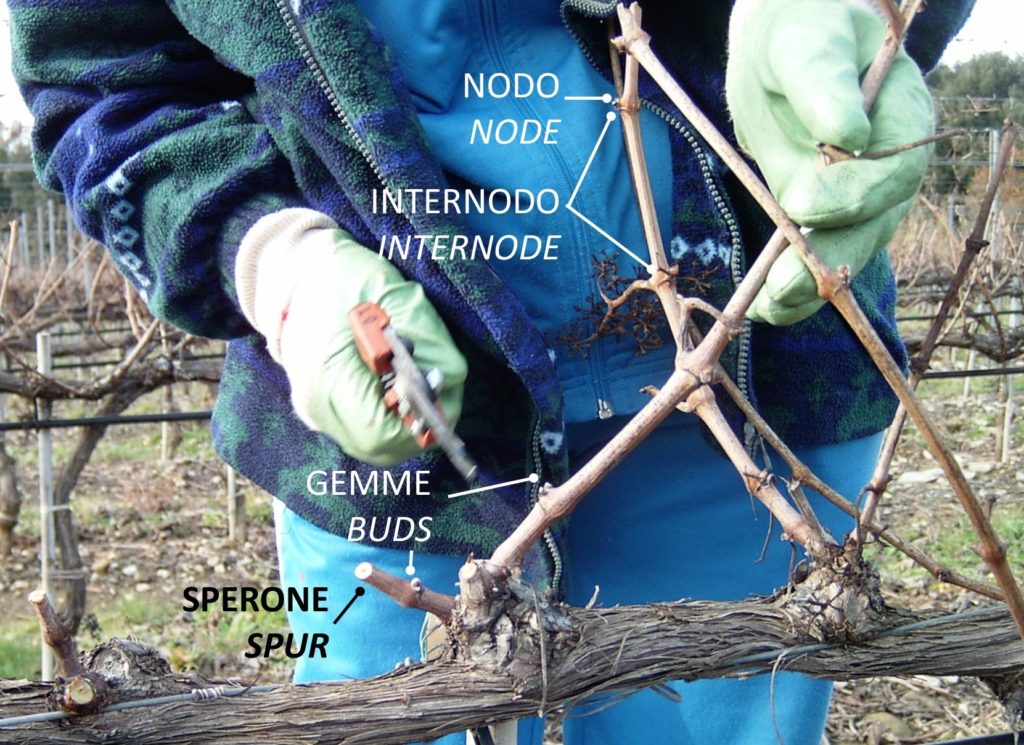
In colder climates, the buds on the first internodes are not complete. They do not form the primordia of the bunches (in scientific terms, they do not well differentiate). They will therefore be little (or not at all) fertile. This happens because they are the first to develop, in early spring. In these climates, this is an unfavorable moment: there are difficult environmental conditions and the plant is weak. The same happens in summer, for the buds of the last internodes. The most fruitful are those that arise in the best moment of life of the plant. They are located in the intermediate part of the cane.
In the warmer territories, as in our case, this usually does not happen. The climate is good from the start, so the buds of the first internodes are also fertile. In this case, it is always better to prune short. A long pruning leave too many fertile buds and too much production would occur.
Some varieties behave differently, regardless of the climate.
Where possible, the winegrowers usually prefer short pruning, which generally gives a better balance between leaves and bunches, with better ripening. In this case, cutting the cane, a short stump remains, called spur.
Long pruning is instead done more frequently in the north Italy, in cooler climates, or it is necessary for some varieties. When we cut, a longer piece of cane remains, with more internodes.
There is also mixed pruning system. In this case, we cut some short and other long canes. It is necessary for certain forms of grapevine training system, when we need to have fruiting branches and to renew the woody parts.
I continue to write "in general" because these aspects are very variable and only experience and knowledge of one's situation lead to the best choice.
Grapevine training system.
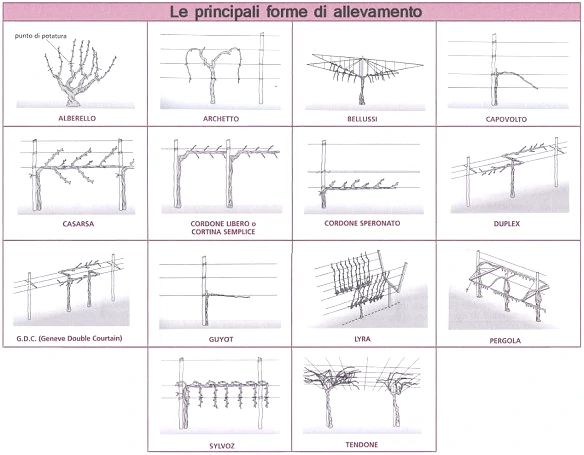
So far, I have described the production pruning. It changes also according to the form of vine growing.
In the first years of life of a vineyard, pruning does not have productive purposes but serves to make the small vine grow well and to take it to the shape of the chosen training system.
How do you choose the training system? It depends on the territory (over all, the climate) and the varieties. In Italy there are many traditional training systems. Each choice is not accidental.
A substantial difference is the height of the trunk of the vine. This element greatly changes the balance of the plant. Inside the trunk, there are vases that carry what is absorbed by the roots (water and mineral salts) and, vice versa, what produced by the leaves (organic substances and energy). The longer the trunk, more energy is lost only for these transfers, subtracting it from the rest. However, there are also different needs, which can make more or less useful to have the trunk higher or lower. For example, where the vigor is not a problem, but there are risks of humidity and frost, it may be more useful to have the trunk high, to distance the bunches from the ground.
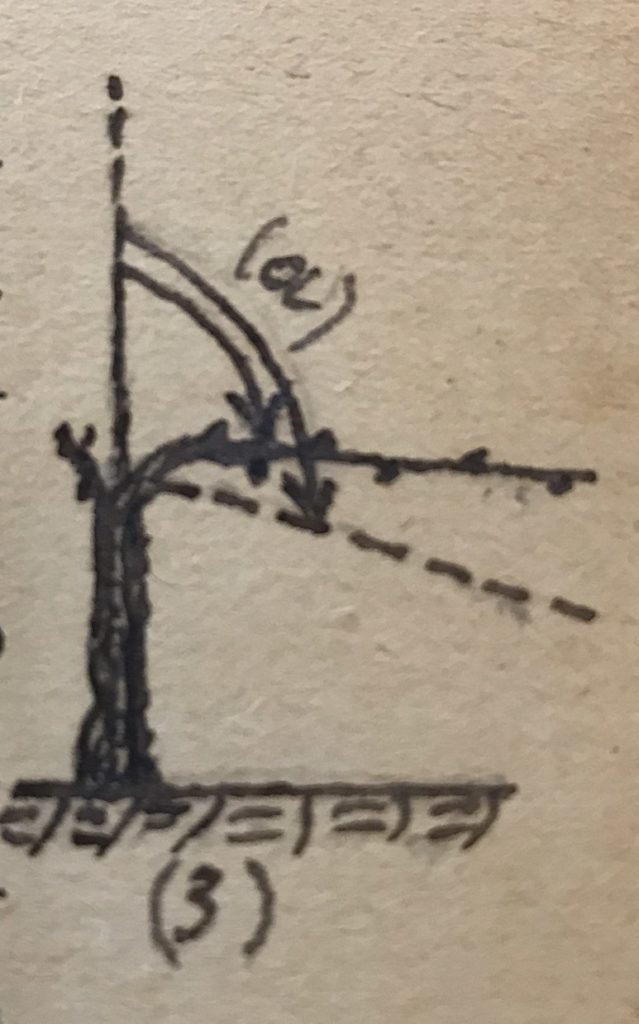
The training system and pruning also affect the arrangement of the canopy. If you notice, there are vineyards with vertical canes, in others they are more or less inclined. Sometimes, they are drooping. This orientation is not accidental. The vegetation activity, the vigor of a cane, is favored by the vertical position. This is generally preferred where there are limiting environmental conditions for the vine. The more the branch is bent with respect to the vertical, the more it loses its vigor. So, it is often found in the territories where you want to counteract too high a vigor. It is a phenomenon that also depends on the complex internal transport of the plant.
There are also training systems where the branches are more or less bundled together, willing to make circles, pergolas, etc. In general, the canes that are too united and overlapped favor the stagnation of humidity, the diseases, limit the absorption of sunlight by the leaves, etc. All these choices depend on the particular situation of the vineyard. For example, in very dry climates, overlapping limits water loss, reducing the transpiration. Where there is little sun, in humid climates, it is better instead to arrange branches and leaves so that they take maximum solar energy, without too many overlaps that favor damp (and therefore diseases and rots). The variables are many.
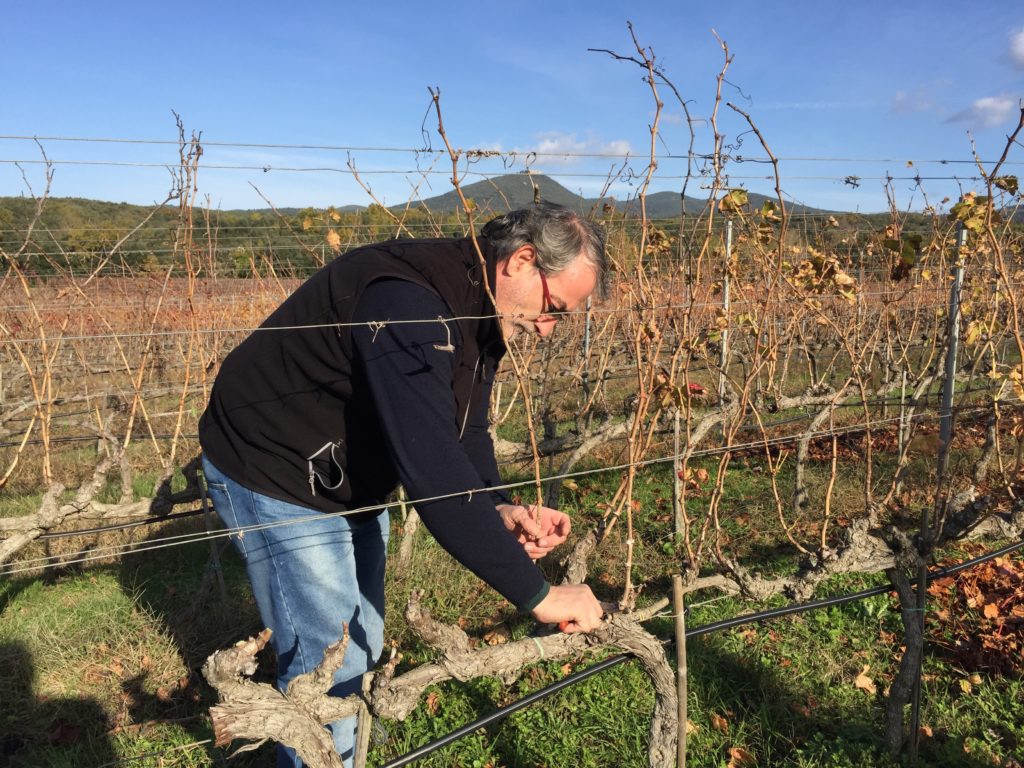
Our training systems and their pruning.
Our climate is mild-Mediterranean, hot and arid in summer, a little rainier in winter and spring. Our alluvial soils are over all lean and well-drained. In this condition, the best grapevine training systems are the low ones, subjected to short pruning, sometimes long (for some varieties), with vertical canopy. We have the Guyot and the spurred cordon.
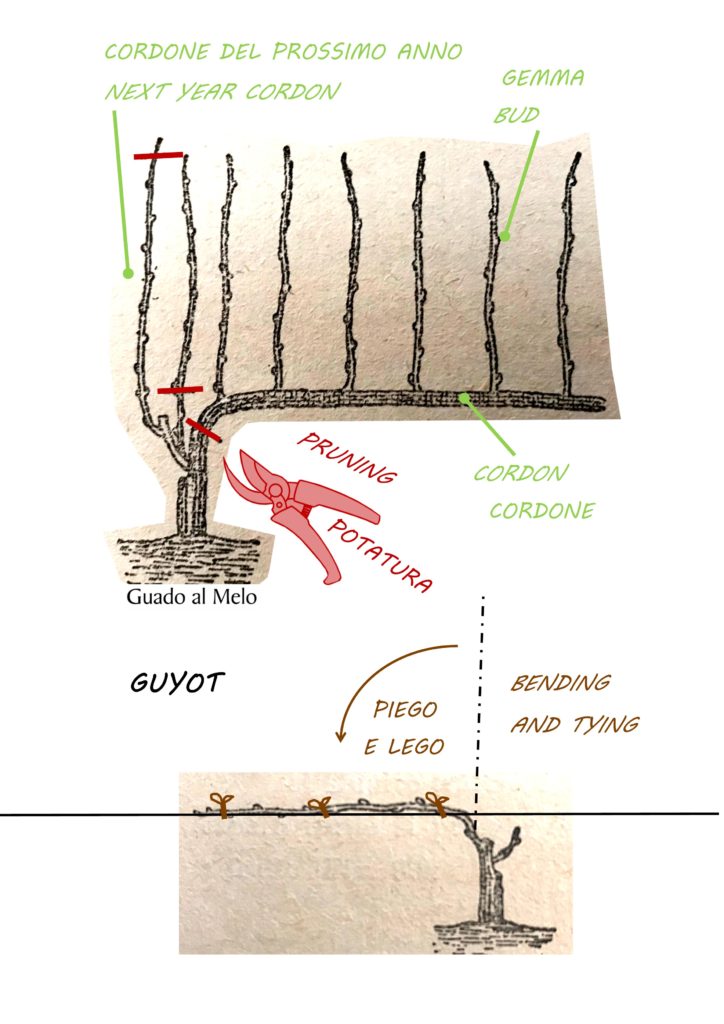 Guyot: it is a very ancient traditional Italian system. It was incorrectly attributed to a French agronomist, Jules Guyot, who described it and spread it in his country in the 19th century. It is a low-production and a high-quality form. It is found in many parts of Italy, from Sicily to Piedmont. It is a mixed pruning system. It is perfect for those varieties that are more fertile in distal buds. It isn't an expanded form, suitable for not very fertile and drought soils, where the vine generally has a limited development. In the pruning, we cut a long cane, from which the future fruit-bearing canes will develop. A second cane is pruned at spur, which will serve for the next year.
Guyot: it is a very ancient traditional Italian system. It was incorrectly attributed to a French agronomist, Jules Guyot, who described it and spread it in his country in the 19th century. It is a low-production and a high-quality form. It is found in many parts of Italy, from Sicily to Piedmont. It is a mixed pruning system. It is perfect for those varieties that are more fertile in distal buds. It isn't an expanded form, suitable for not very fertile and drought soils, where the vine generally has a limited development. In the pruning, we cut a long cane, from which the future fruit-bearing canes will develop. A second cane is pruned at spur, which will serve for the next year.
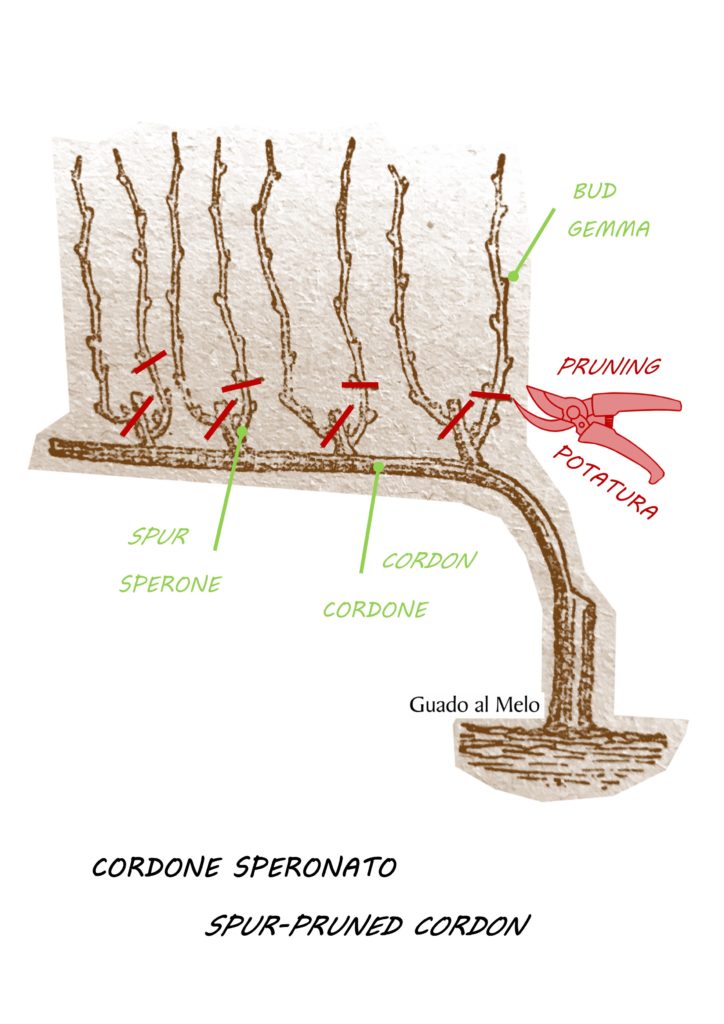 Spurred cordon: it is also traditional and it derives from Guyot. In this case, however, there is only the short pruning. It is suitable for low or medium fertility soils, even dry, and for those varieties that have good fertility on the proximal buds (the first ones). It is frequent in Tuscany and other Italian central regions. During the first years of the vineyard, the best cane is placed horizontally and it becomes a structural element of the plant. The gems on the underside are eliminated. In spring, fruiting canes will form from the upper buds. The following year, each cane will be cut into a spur, forming the cordon. Each subsequent year, it will be cut with short pruning. This system has been successful and has spread due to the excellent quality management of the vineyard, but also for simple and fast pruning.
Spurred cordon: it is also traditional and it derives from Guyot. In this case, however, there is only the short pruning. It is suitable for low or medium fertility soils, even dry, and for those varieties that have good fertility on the proximal buds (the first ones). It is frequent in Tuscany and other Italian central regions. During the first years of the vineyard, the best cane is placed horizontally and it becomes a structural element of the plant. The gems on the underside are eliminated. In spring, fruiting canes will form from the upper buds. The following year, each cane will be cut into a spur, forming the cordon. Each subsequent year, it will be cut with short pruning. This system has been successful and has spread due to the excellent quality management of the vineyard, but also for simple and fast pruning.

In our historic vineyards we also have:
Head-trained system (In Italian, “alberello”): it is traditional in Italy in the places of ancient Greek or Phoenician culture. It is one of the oldest forms. It is suitable for extremely dry, poorly fertile, or windy or very cold soils, where it is convenient to have a contained vegetation that remains close to the ground. It is at the lowest point of the productivity scale, with the highest sugar levels. It is found in Valle d'Aosta (which is semi-arid) and Sicily, for opposite climatic reasons. Pruning can be very short, as we do (the Greek system, the vites capitatae described by Columella), short or even long or mixed, depending on the territories and varieties.
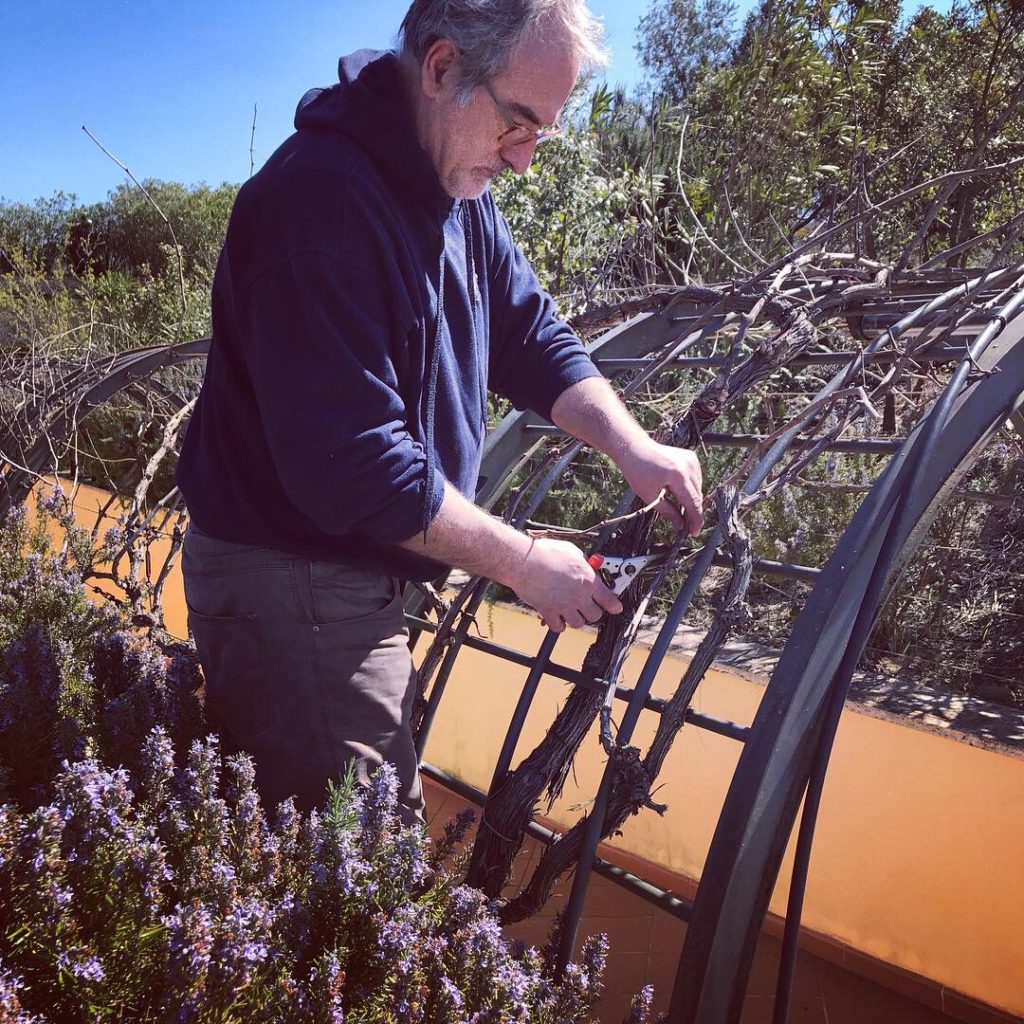
The pergola: the oldest representation is in the Egyptian tombs, where it is represented in the shape of a tunnel, as we have reproduced it at Guado al Melo. In Roman times, horizontal pergolas (called jugatio compluviata) were created to cover avenues and terraces, described by both Columella and Varro. Many variations developed, some more suitable for table grapes, others for wine production. It is a high-vine shape, with the branches well distributed on a more or less inclined surface, to capture the sun's rays to the maximum, avoid stagnation of humidity, but do not give excessive vigor. In Italy, for wine production, it is widely used in mountain areas, such as Trentino. Pruning can be of different types, depending on the territories and varieties.
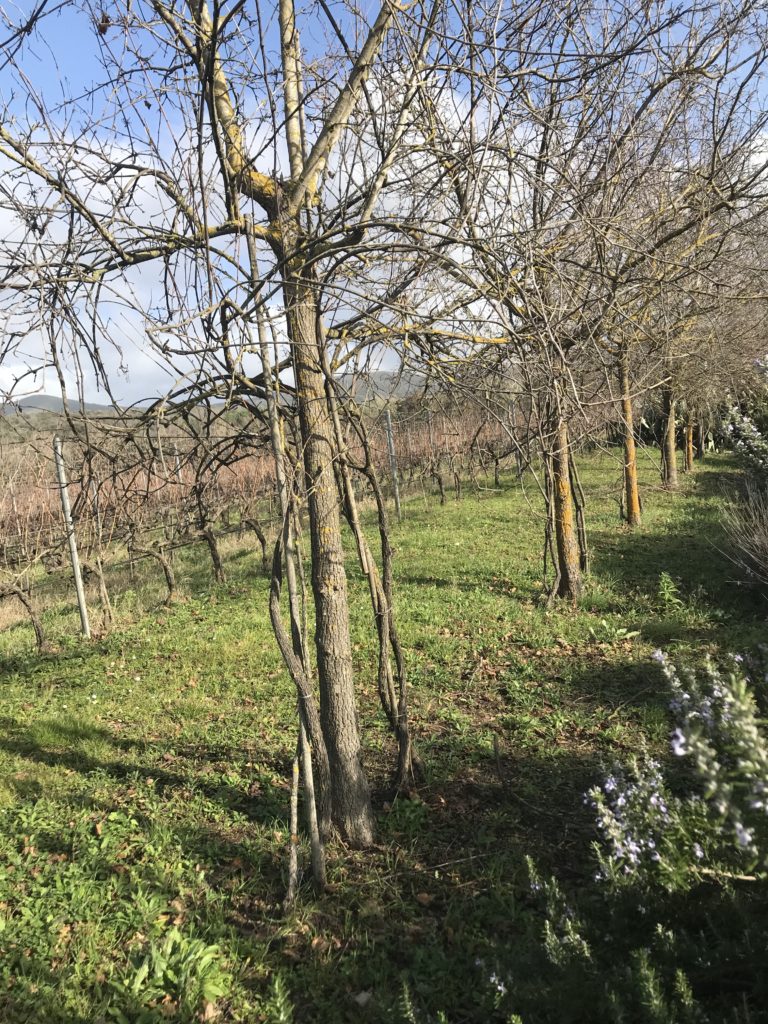
The trained-to-a-tree system or married vine: one of the oldest forms ever, that of our primeval tradition. I have already talked about it at length (here, here and here). It was not pruned at all, in the primitive viticulture. Later and until the twentieth century, it was subjected to long and rare pruning (every two years or even three). It was the system that guaranteed the most longevity of the vine, which frequently became over hundred years old (before phylloxera arrived from America, to complicate the life of the winemakers).
At Vinexpo Paris, with the TreBicchieri WorldTour
We’ll be in Paris Vinexpo, on 11th February with the TreBicchieri World Tour of Gambero Rosso.
There will be, overall, the tastings of the prizewinning Criseo Bolgheri DOC Bianco 2017, and other our great red wines.
Vinexpo Paris, Porte de Versailles
Pav. 7.2
Tuesday 11th February , h. 2.00-6.00 PM
Ancient Rome: a lost in translation vineyard
"Where could we better start if not from the vine, compared to which Italy has such an undisputed supremacy, that it gives the impression of having overcome, with this single resource, the wealth of every other country, ...?" Pliny
In addition to Pliny, Horace also says that the Romans considered viticulture as one of the nation's greatest economic resources. Cato places it in first place among the more profitability crops. We are not surprised: Italy is a great land for the viticulture and has a great production still today.
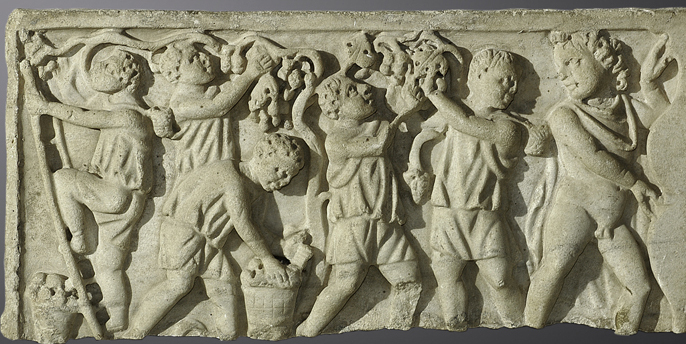
You will think: what can be said of Roman viticulture that has not already been already said and repeated?
In truth, Roman viticulture has often been misrepresented due to linguistic and cultural misunderstandings, although it has been well described by Latin authors (our sources: see here) and examined far and wide by scholars of all centuries. This fact has often prevented from understanding its original and absolutely distinctive trait: the cultivation of the vine "married" to the tree (or vine training system to a tree) of Etruscan origin, a form that will remain in Italy until the first half of the twentieth century. This cultivation system was also present in other ancient civilasations but in Italy it has played a particularly important and lasting role for millennia.
Viticulture in Rome, as for almost all Italic peoples, is very ancient. Ever since man stepped our lands, he has always collected wild grapes in our Mediterranean woods. In Rome, the transition to advanced viticulture seems to have occurred due to Etruscan influence. I have already written in more detail here on the origins of viticulture in Italy.
The original Roman viticulture was therefore the same as for the Etruscans, a training system based on the natural way of wild-vine growth. In the woods, in fact, it uses trees as a support to reach the light. In Etruria maples were mainly used, in Rome mainly elms. In Latin, this cultivation system was called arbustum vitatum (vine trained-system to a tree or alberata), with the vitatum often omitted. More poetically, the term vitis maritae was also used, "married vine" (vine married to a tree). I have already described these aspects in more detail here.
If we want to imagine the classic agricultural landscape of the Roman era, we must think of a countryside with vines married to trees, arranged in rows or quincunx (like the number 5 on a dice), with intermediate strips of wheat (or other crops). There were also the olive trees.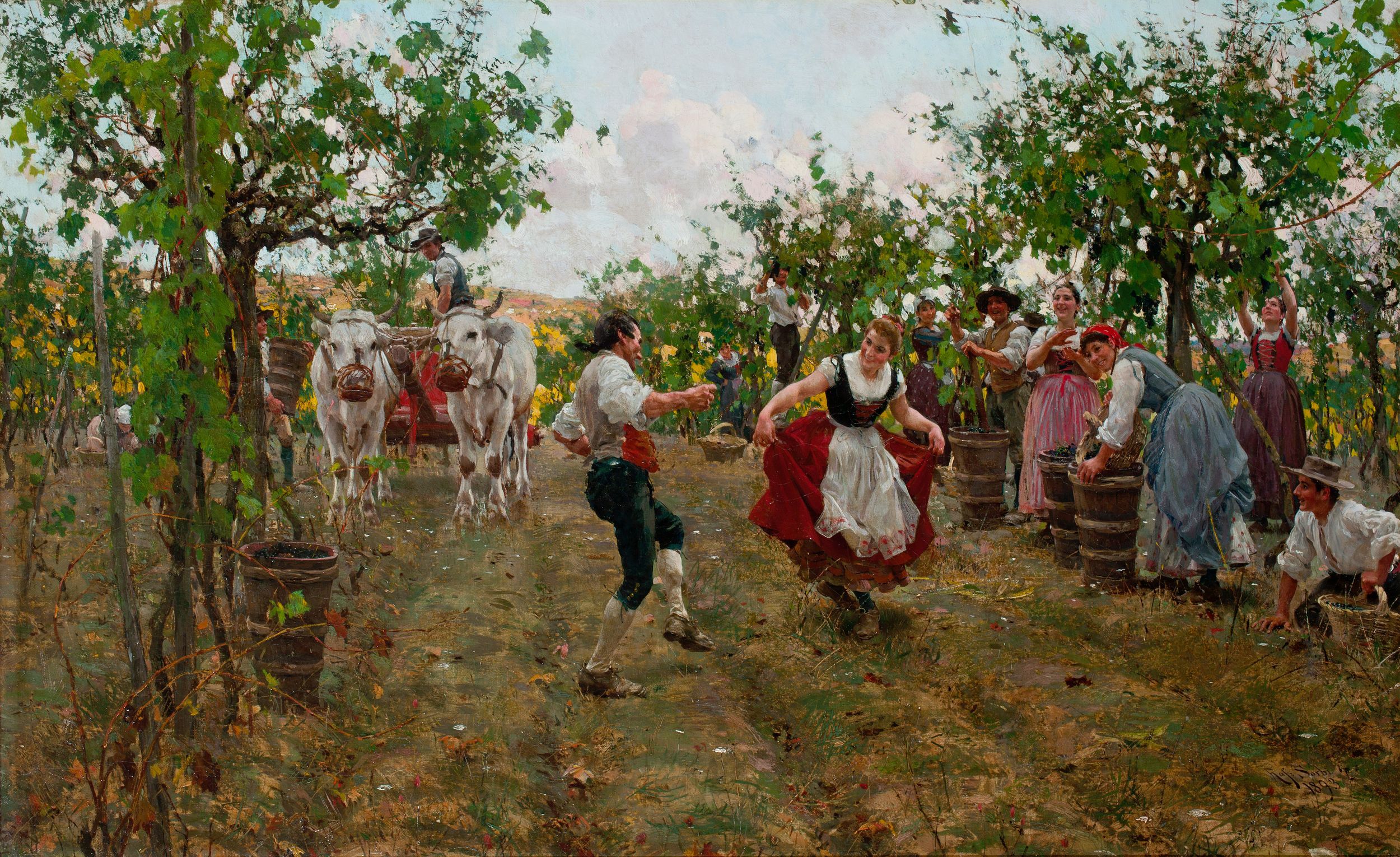
This agricultural world is not so distant from us, even if forgotten today. Still at the beginning of the twentieth century, Chianti wine was produced by a very similar model of viticulture, well represented in this work by Raffaello Sorbi (1893): vineyards with "married vines" (system called "testucchio" in Tuscany, at the time), alternated with strips of wheat (or other crops), managed by farmers in sharecropping. The oxen with the muzzle were also identical (Pliny also recommends it, you will see).
Rome will incorporate the Greek viticulture training-system only later: the low vine cultivation system, without support or with a "dead" support (the pole), then carrying on both.
Lost in translation.
I refer to the title of a well-known film from several years ago, "Lost in translation", which gives a good idea of what happened with the viticulture of ancient Rome, often misrepresented due to translation and cultural problems.

Unfortunately, it is also our fault. Modern Italy wine world has not paid much attention to its immense historical and cultural heritage, often with a superficial approch. Often the narration of the history of wine (including ours) in the modern era has been left to foreign authors, unrelated to our culture, who did not have sufficient instruments to understand it.
Roman viticulture has therefore often been identified only with the Greek vine-training system, the low vineyard. Scholars or popularisers, unrelated to Italian culture and / or without in-depth agricultural skills, did not even know the existence of the "married" vine. Others have considered it absolutely secondary, a primitive form of little interest, soon supplanted by Greek vine training-system, considered more advanced. Whenever the term vinea (vineyard) was found in the Latin authors, it was assumed that it referred to the low vineyard. Hugh Johnson, for example, cites the existence of the "married" vine, but he writes that "the ancient authors never talk about it" (!).
The Latin term specific to the alberata or "married" vine, arbustum, has been widely misunderstood. English authors often have translated it as a plantation of trees or woods or grove, so French ones, as Apollinaire (bouquet of arbre), and various German writers (Jungholz). They did not notice the absurdity to translate Varro's works, for example, writing that a "grove" produces certain quantities of wine and wheat!
Latin poets wrote about the "married" vine, too, never about the low vineyard. Catullus was the first who describes the vine and the elm as wife and husband (in the Carmina). In the Augustan era, this system is often cited by Virgil and Horace. The one who talks about it most is Ovid, who frequently uses the "married" vine as a metaphor for love in Amores, Fasti, Heroides, Tristia and Metamorphoses, in the Vertumnus and Pomona's tale (see here).
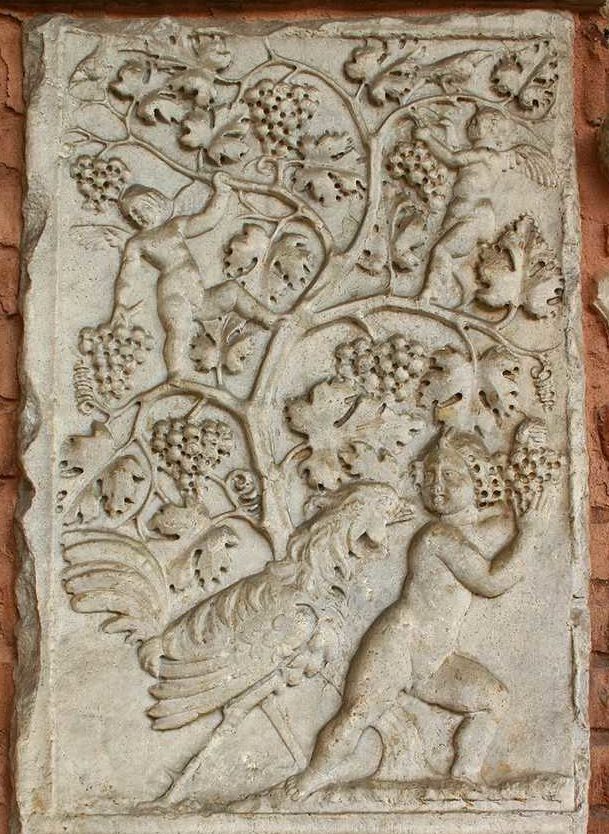
As previously mentioned on the origin of viticulture in Italy (here), there have been several multidisciplinary studies (between archeology, linguistics and viticulture) in recent decades that have tried to shed more light on our viticultural origins. Above all it the work of Paolo Bracali (University of Perugia) has clarified the meaning of the Latin terms related to the vine and their change during the long Roman history.
Vinea or arbustum?
Cato, the first of the agrarian Latin authors, is quite clear when he writes that to make a good vineyard it is necessary "that the trees are well married to the vines and that they are in sufficient numbers". The Roman vineyard, from its origins and still in Cato's time, was made only with vines married to trees. He indicates it with the generic term vinea (vineyard) or, when he wants to underline the form of cultivation, the more specific word arbustum.
[one_third][info_box title="" image="" animate=""]*Cicero tells the story of Attus Navius, a young pig guardian with divinatory skills. One day he lost a sow in a vineyard and he vowed to Jupiter, if he found it again, to offer him the largest bunch. So, it happened and, to fulfill the vow, he divided the vineyard into different parts and interpreted the flight of birds for each one, according to the divinatory Etruscan uses. In doing so, he found a cluster of incredible size and beauty to be given to the god. The young man then became the official augur of the first Etruscan king of Rome, Tarquinius Priscus.
This myth is considered at the origins of the Roman rite of the auspicatio vindemiae. Before the harvest, Flamen Dialis, the high priest of Jupiter, offered the god a bunch chosen from a public vineyard. The rite served to ensure a good harvest and was the official start at the time of the harvest. So, the period of this rite varied every year. [/info_box][/one_third]Until the late Republican era, therefore, whenever the word vinea is found, it refers only to the vine planted with trees, the traditional form of Roman viticulture. Many of these authors do not explain how the vineyard is made, they have no agronomic intent, but we can also notice it from some details. Cicero, for example, tells a myth in which a boy brings pigs into a vineyard *. It can only be a vineyard made with "married vines", since it is practically impossible to think to graze pigs in a low vineyard with ripe grape (they would have eaten it!).
Phaedrus, who translates and readapts Aesop's fables in the first century BC, uses the term vinea alta (tall vineyard) in the famous history of the fox that cannot reach the grapes. A change is beginning. He still uses the word vinea in the ancient way, but he feels the need to add the alta (tall) adjective. Maybe, is he afraid of not being understood?
In fact, Rome had now annexed several territories that had been Greek colonies, in the south of Italy, where the vines were cultivated low, without a support or sometimes supported by a stake. This other cultivation system also became part of Roman culture. The need not to confuse them led to a linguistic change that seems to be fixed in the last decades of the first century BC.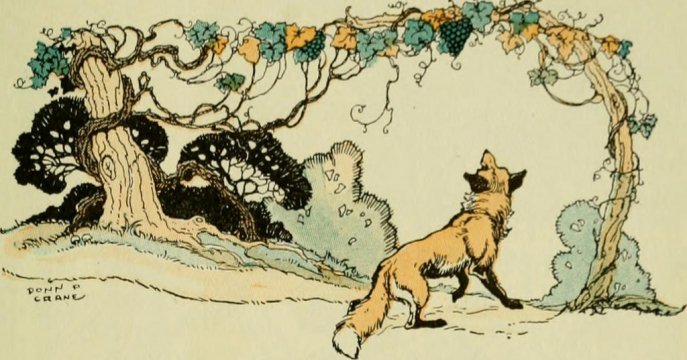
Varro seems to be the first to use two distinct names to indicate the two cultivation systems. From then on, in Latin texts, the word arbustum remained to indicate the "married" vine system, while vinea became the preferential term for the Greek low vineyard. The vinetum (vineyard) included both, as well as sometimes vinea (... just to not make it too easy ...).
So, you understand the difficulty? It was easy for inexperienced translators (on viticultural aspects) to get lost, especially by mistaking the arbustum for a grove, not even realizing that they were talking about a vineyard.
Today in Italian, vinetum is become vigneto, vinea is become vigna. They are synonyms, both of them means "vineyard" (in general). The arbustum vitatum is become vite alberata. But this vine-training system disappeared almost completely in Italy in the mid of twentieth century and today very few Italian people remember it.
Tall or low vineyard?
From the late Republican Era and especially in the Imperial Epoc, therefore, both forms of viticulture were present.
In many texts of wine history there is a schematic subdivision according to which the low vineyard was typical of the large slave villae (the big estates) with an intensive and higher quality production. The arbustum is relegated to more primitive or less specialized contexts. In truth, this interpretation seems to reflect a twentieth-century concept of viticulture rather than an understanding of the historical epoch.
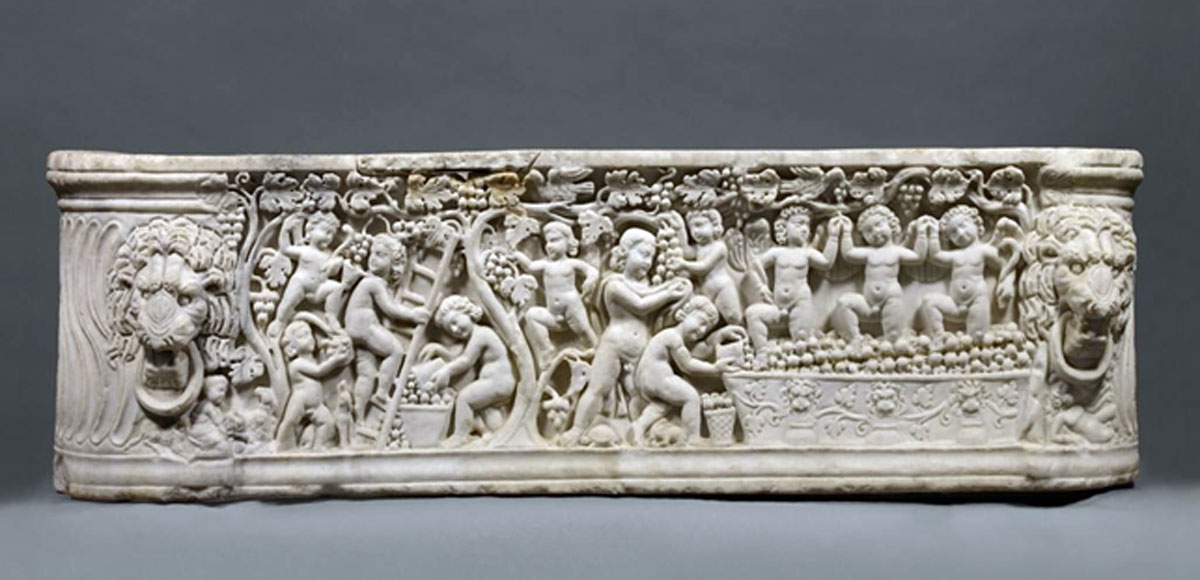
The studies of the last decades, in fact, have led to reconsider this model. The concept of specialization and intensive cultivation in Roman times was different from the modern one. Promiscuous agriculture was prevalent even in large villae. Furthermore, the presence of one or another form of viticulture seems to respond more to the cultural tradition of the place than to the estate dimension or the quality of the wine (with due exceptions), as witnessed by Virgil, Pliny the Elder and many other authors.
For example, Pliny the Younger (nephew of the other Pliny) had large properties in the upper Tiber valley, which earned him huge profits thanks to the sale of wine in Rome. Pliny says that his farmers used to cultivate "below and above", where "above" means the "married" vine and "below" cereals, in line with the oldest local tradition. Pliny, telling of his activity as a lawyer, uses this agricultural metaphor that testifies to promiscuous agriculture: "As in agriculture I do not cultivate only the low vineyard (vinea), but also the tall one (arbustum), and not only the "married" vines (arbustum) but also the fields and in the same fields I not only sow spelled or wheat, but also barley, fava beans and other legumes, so in the discussion of a lawsuit, I broadly use different topics as if I were sowing, to harvest what will be born ".
There could therefore be been some variability in the vineyard choices. However, the prevalence of local tradition is also demonstrated by the fact that the most ancient wine-growing cultural frontiers remained more or less the same, in Italy, from ancient times until the twentieth century, as emphasized by most of the Italian agricultural historians. Generally speaking, the "married" vine remained predominant in central and northern Italy, where the Etruscan tradition had arrived in the past, including neighboring peoples influenced by them. The low vine remained prevalent in southern Italy, where there was the ancient Greek viticultural culture. (see here)
In modern interpretation, the "married" vine has often been linked to the production of a poor-quality wine. The Romans, however, didn't think so. Pliny the Elder testifies that the most renowned wines of his time, the famous wines from Campania, capable of very long aging, derived precisely from "married" vines.
 He is an advocate of the "married" vine compared to the low vine, as well as Columella. The Latin authors list a series of advantages, the same cited by Italian authors till the beginning of the twentieth century. Numerous subsequent Italian historical and literary sources, from the Edict of Rothari (645 AD) to the nineteenth-century works, indicate the "married" vine as the most suitable for the economy of the farm and the interests of the owner.
He is an advocate of the "married" vine compared to the low vine, as well as Columella. The Latin authors list a series of advantages, the same cited by Italian authors till the beginning of the twentieth century. Numerous subsequent Italian historical and literary sources, from the Edict of Rothari (645 AD) to the nineteenth-century works, indicate the "married" vine as the most suitable for the economy of the farm and the interests of the owner.
The grapes, kept away from the ground, were more protected from frost and humidity. The branches of the tree protect (in part) grapes from other adversities, such as hail. Furthermore, it was considered a considerable advantage to be able to exploit the same plot of land for multiple uses. The cultivation of wheat, or other crops, is easy between the rows of the tall vineyard. Animals can be grazed there for most of the year, without risks for grapes or sprouts (unless there were other crops in the middle to protect). At the time, it was common for the owner to rent the pasture also to external shepherds. In the low vineyard the pasture was possible only during the period of vine rest. In addition, the "married" vine had no need of fences and hedges, being the grape more protected even from wild animals. Only large livestock is dangerous for tall vineyards. In fact, Pliny recommends putting muzzles to oxen when plowing the soil.
When Cato makes his famous ranking of economically most interesting crops, he reminds us that the "married" vine gives double profitability. In fact, he puts it in first place as grape production, but it also returns to the eighth place thanks to the support trees: the leaves as fodder, the pruning of the branches like firewood, the fruits in case of utilize of fruit trees (Cato often mentions the use of the fig tree). This passage was one of the most misrepresented: the vinea in the first place was interpreted as a low vine and the arbustum, in the eighth place, as a grove.
There are not only advantages. The Romans themselves recognized the difficulty of the vineyard works. Pliny tells that, at the origins, King Numa Pompilius introduced the obligation of pruning vines, but the Romans did not want to climb trees, even very tall, for fear of falling. Since then, the use of guaranteeing the funeral expenses to the vintners was introduced in the employment contract. Aside from the myths, Columella cites the Saserna family, owners in the Cisalpine Gaul, who found this system too expensive.
In the following centuries (especially in the nineteenth century) the dispute, that will divide the experts between detractors and supporters, will continue. Several negative aspects have been recognized such as the shading of the vines, the competition between the two species (in not sufficiently fertile soils) with the production of poor body wines, the slowness to achieve an optimal grape production, pruning and higher harvesting costs, the impossibility of even a minimal mechanization, ... The plant disease called graphiosis contributed to abandon this traditional form in the 20s of the twentieth century, causing the death of most of the elms. Simply, there wasn't more space for the "married" vine in the modern specialized viticulture. The peasant ancient world was already sunset.
 Finally, I would like to remind you that the Roman era, especially in the Imperial phase, was characterized by a very hot climatic period. Today, with the changes in the climate going on, we have already realized that we need to review the production balance of just twenty-thirty years ago. We cannot exclude a priori that a high-producing viticultural form, if well managed and in the appropriate climate and soil, cannot however produce good quality wines. We must remember that Columella testifies how, at the acme of their viticulture, the Romans had a clear understanding of the concept of the link between productive balance and wine quality. This aspect will be "rediscovered" only several centuries later.
Finally, I would like to remind you that the Roman era, especially in the Imperial phase, was characterized by a very hot climatic period. Today, with the changes in the climate going on, we have already realized that we need to review the production balance of just twenty-thirty years ago. We cannot exclude a priori that a high-producing viticultural form, if well managed and in the appropriate climate and soil, cannot however produce good quality wines. We must remember that Columella testifies how, at the acme of their viticulture, the Romans had a clear understanding of the concept of the link between productive balance and wine quality. This aspect will be "rediscovered" only several centuries later.
The "married" vine around Europe (and more).
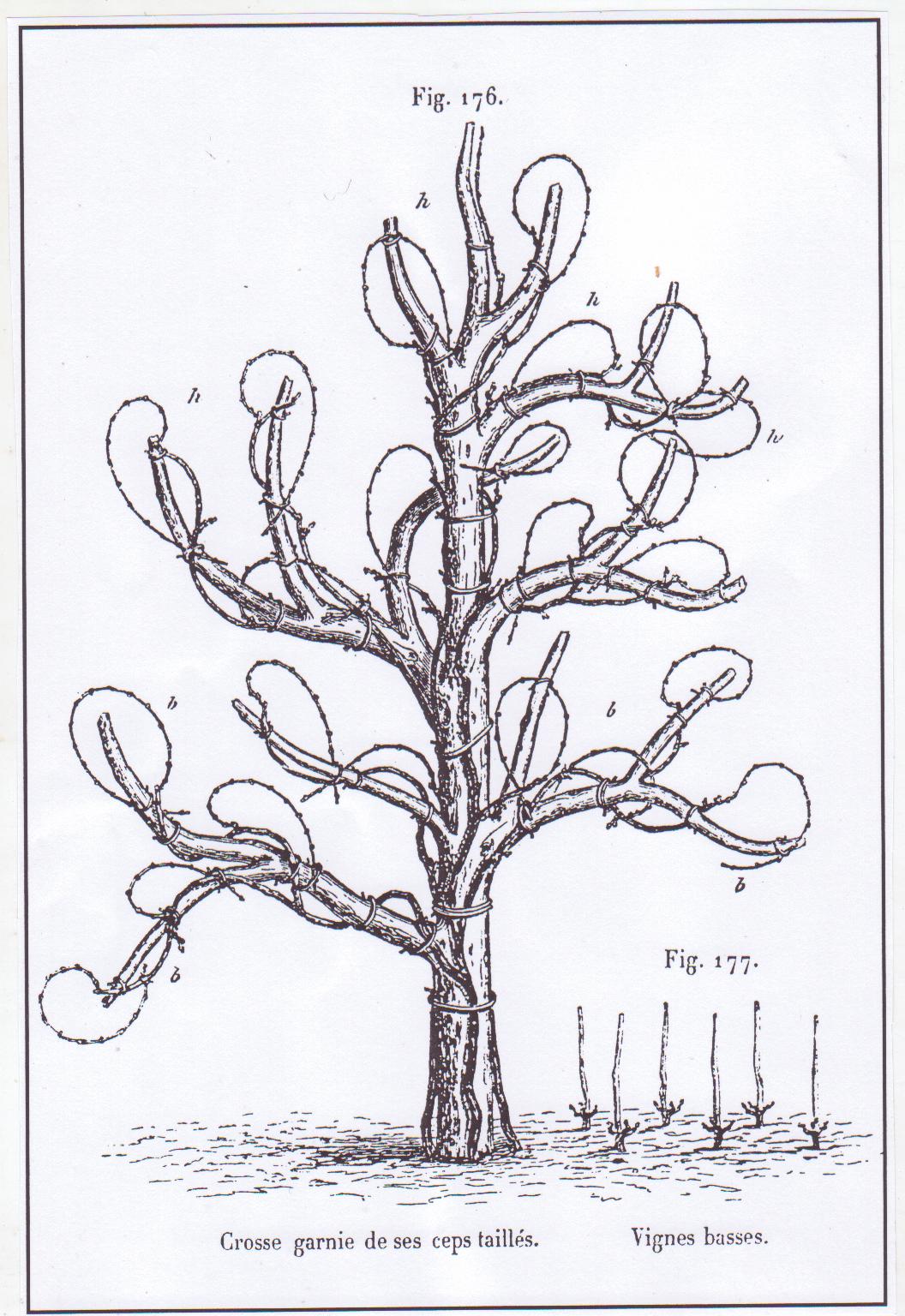
I have already written about the long "career" of the vine married to the tree in Italy (here). One of the great contribution of Rome was to have spread viticulture in other parts of Europe, through its legionnaires. It was taken for granted that it was only the low vineyard. In reality they also spread the "married" one. In fact, there is a trace of it in the viticultural history of other European territories.
I also remember that other systems of tall vine growing, with poles or pergolas, were always spread by the Romans. They are still present in many parts of Europe.

There are several traces of the ancient "married" vine tradition in France. The tall vineyards (in general) are called hautains. The "married" vine was present in the Middle Ages in numerous territories, for example in Picardy or in Provence (on walnut trees). In the 14th century, there are documents demonstrating its spread to Avignon. Olivier de Serres in "Le théâtre d’agriculture et mesnage des champs" still testifies to its presence in the seventeenth century, especially in Brie, Champagne, Burgundy, Berry, Dauphiné (on cherry trees), Savoy and in the Rhone valley. Until the beginning of the twentieth century, they could still be found mainly in Haute-Savoie and in the area of the western Basque Pyrenees. It disappeared completely after the phylloxera crisis.
In north-western Portugal, the tradition of the tall vineyard still remains, with poles but sometimes still the real "married" vines, with the name of viña de enforcato, in the production area of the vinho verde.

In Spain the "married" vine has not left traces in the viticultural tradition, although we know that it was brought there by the Romans. In particular, there is direct evidence from Columella, who introduced it in its properties in Baetica. Today, there are only other forms of tall vineyards in Galicia and the Basque country.
The very ancient cultural imprint has remained at least in a widespread proverb, which says: "no se le pueden pedir peras al elmo", "you cannot ask the elm for pears", also quoted by Cervantes in Don Quixote. In Portugal there is a very similar one: "Não pode o ulmeiro dar peras", "the elm cannot give pears". Both of these proverbs have the meaning of asking for something that is impossible, but most Spaniards and Portuguese do not know why they're speaking on elms and pears. The proverbs origin most likely is found in the Sententiae of Publius Syrus (1st century BC), who writes: "Pirum, non ulmum accedas, si cupias pira", "you should go to a pear-tree for pears, not to an elm". The ancient Romans understood it easier: the elm was the favorite "husband" of the vine, so he certainly could not give pears but grapes.
If the Spaniards abandoned the "married" vine in their motherland, they took it to the New World during the Conquista (the Spanish colonization of the Americas) with other forms of tall vine-training systems. They needed wine for Mass, so they planted vineyards wherever they went. They also had succeeded in Bolivia, in the Cinti valley, at an altitude of 1900-2550 meters above sea level, where it was really difficult for growing vines. Yet they solved the problem by "dusting off" ancient Roman knowledge, with vines married to indigenous trees, even very tall ones, the only way to preserve shoots and grapes in that so difficult climate.
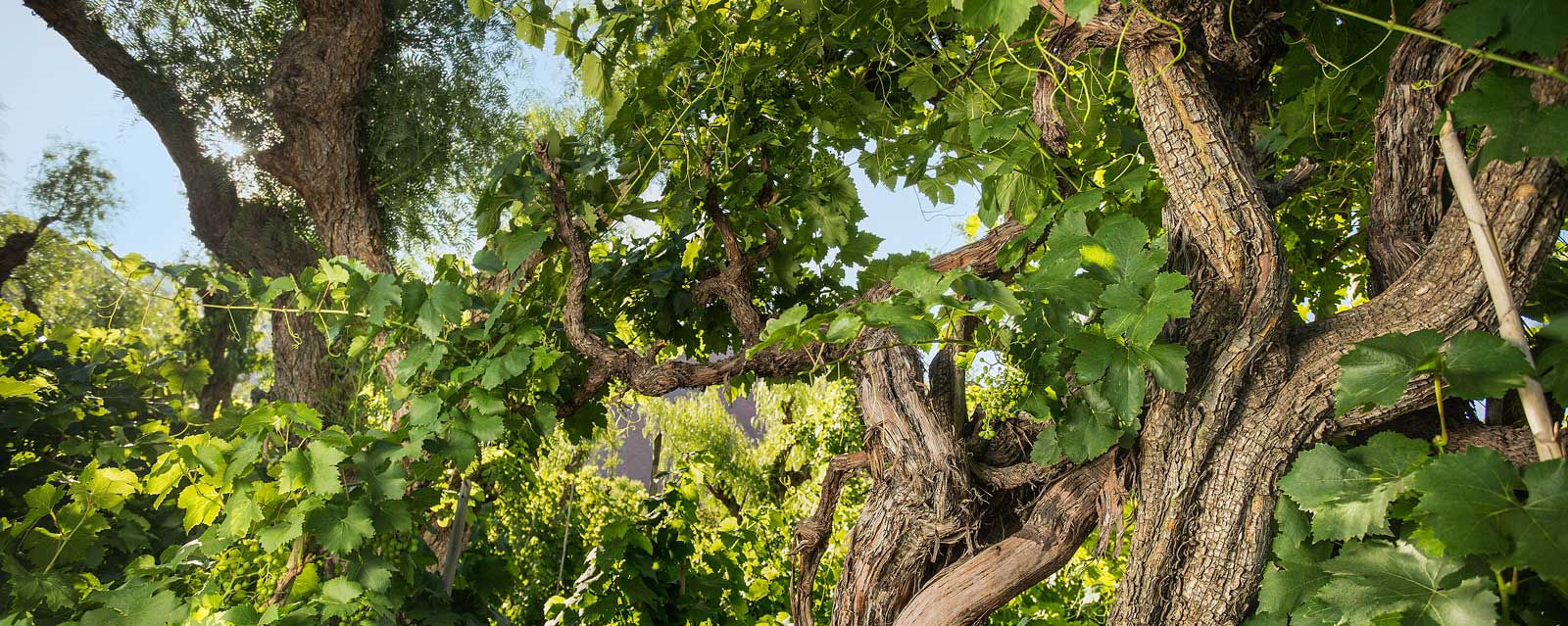
If you want to see a "married" vine, come at Guado al Melo estate and visit our little ancient vineyards.
(...continued..)
Bibliography:
Paolo Braconi, "Vinea nostra. La via romana alla viticoltura".
Paolo Braconi, "Catone e la viticoltura intensiva".
Paolo Braconi, "In vineis arbustisque. Il concetto di vigneto in epoca Romana.
Paolo Braconi, "L'albero della vite: riflessioni su un matrimonio interrotto".
P. Fuentes-Utrilla et al., "The historical relationship of elms and vines", Invest. Agrar.: Sist. Recur For (2004) 13 (1), 7-15
Attilio Scienza, "Quando le cattedrali erano bianche", Quaderni monotematici della rivista mantovagricoltura, il Grappello Ruberti nella storia della viticoltura mantovana.
Attilio Scienza et al., Atti del Convegno "Origini della viticoltura", 2010.
Luigi Manzi "La viticoltura e l'enologia presso i Romani", 1883.
Dalmasso e Marescalchi, “Storia della vite e del vino in Italia", 1931-1933-1937.
Emilio Sereni, "Storia del paesaggio agrario italiano", 1961.
Enrico Guagnini, "Il vino nella storia", 1981.
Hugh Johnson, “The Story of Wine”, 1991.
Valerio Merlo, "Contadini perfetti e cittadini agricoltori nel pensiero antico", Alce Nero.
Roger Dion, "Histoire de la vigne et du vin en France, des origines au XIX siècle", Parigi, 1959.
https://fr.wikipedia.org/wiki/Hautain
Guado al Melo News 2019
As our tradition, we remember the 2019 (that is ending) with a small publication, with 3 languages (Italian, English and German).
It starts with the harvest, the crucial year moment for us, but then traces the main events and some news for the new year.
This year's quote is from Edoardo Hughes Galeano, Uruguayan journalist and writer, one of the major personalities of contemporary Latin American culture, who died in 2015. We liked it because it underlines, with subtle irony, that it is essentially the function of wine, since time immemorial: giving joy to our days, making us forget the worries of life, as well as love.
Here you can also find it in pdf format.
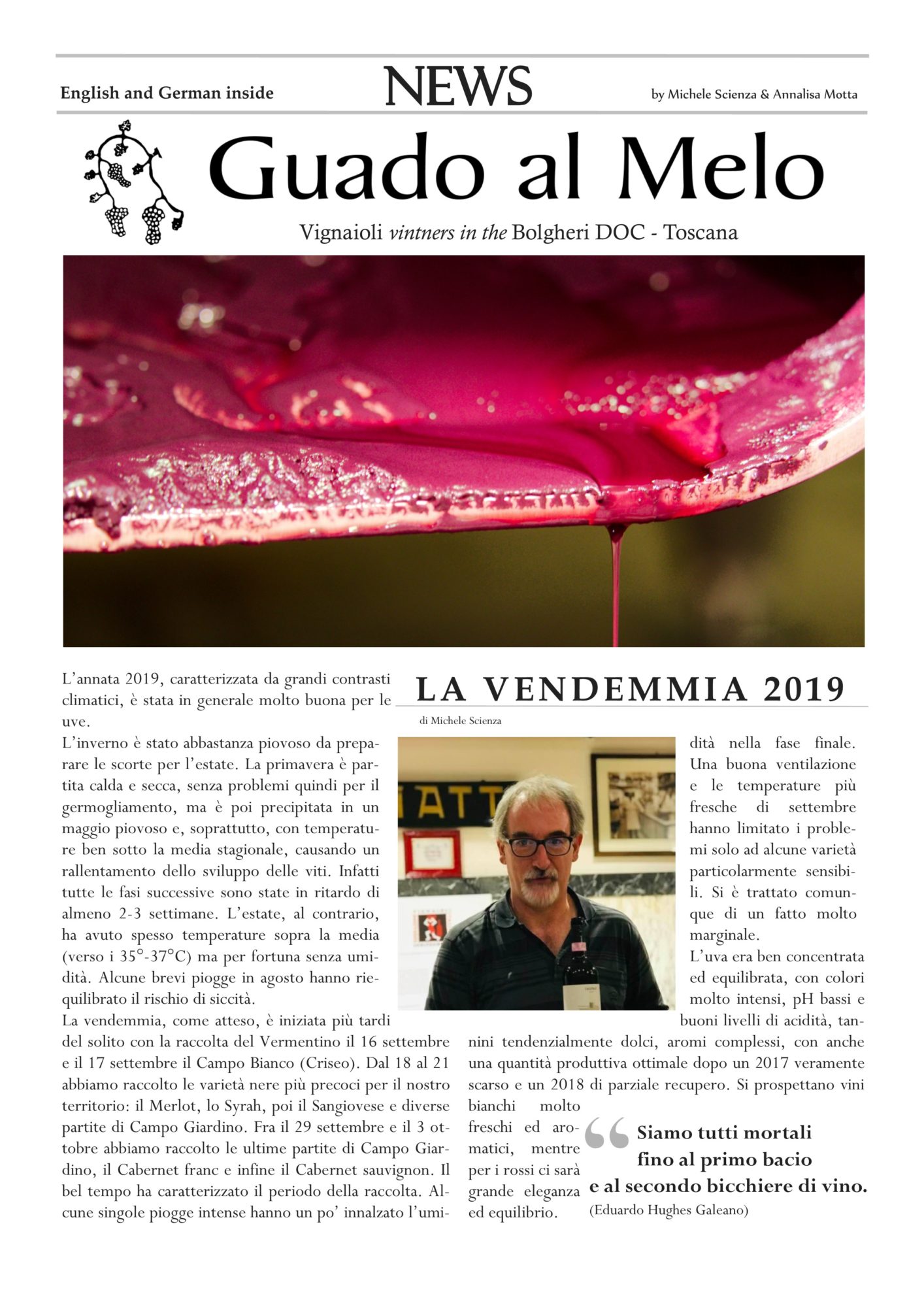
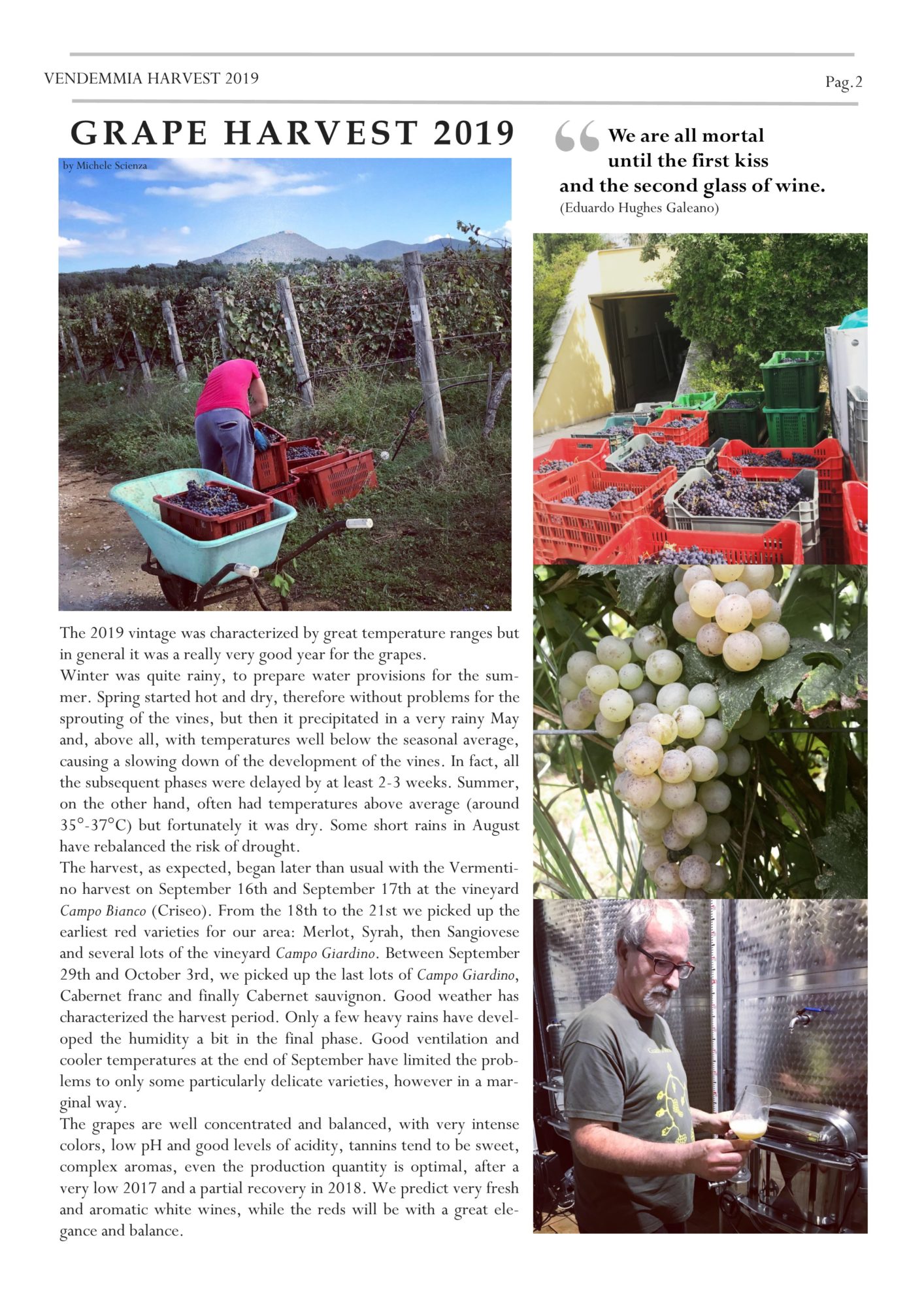
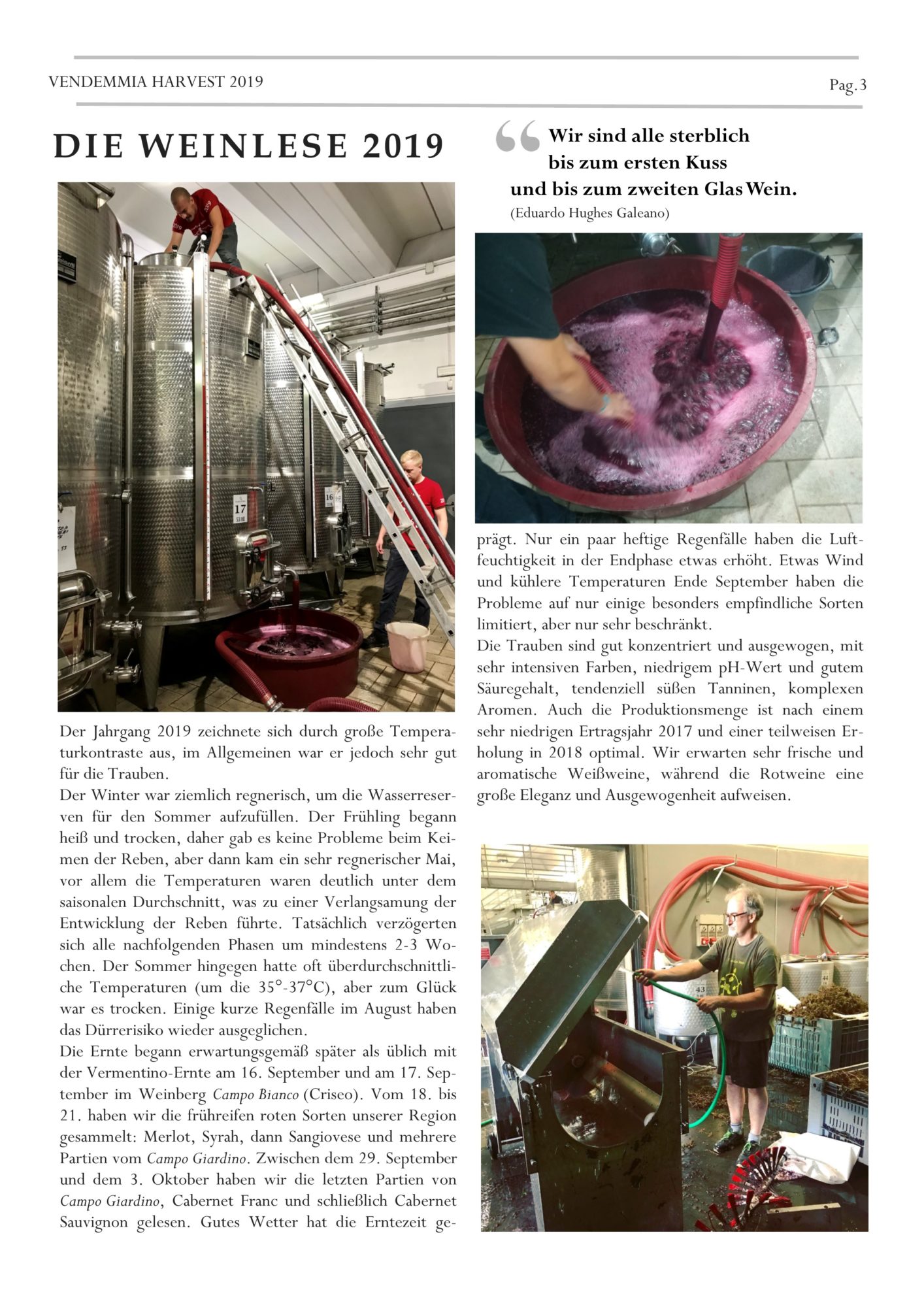

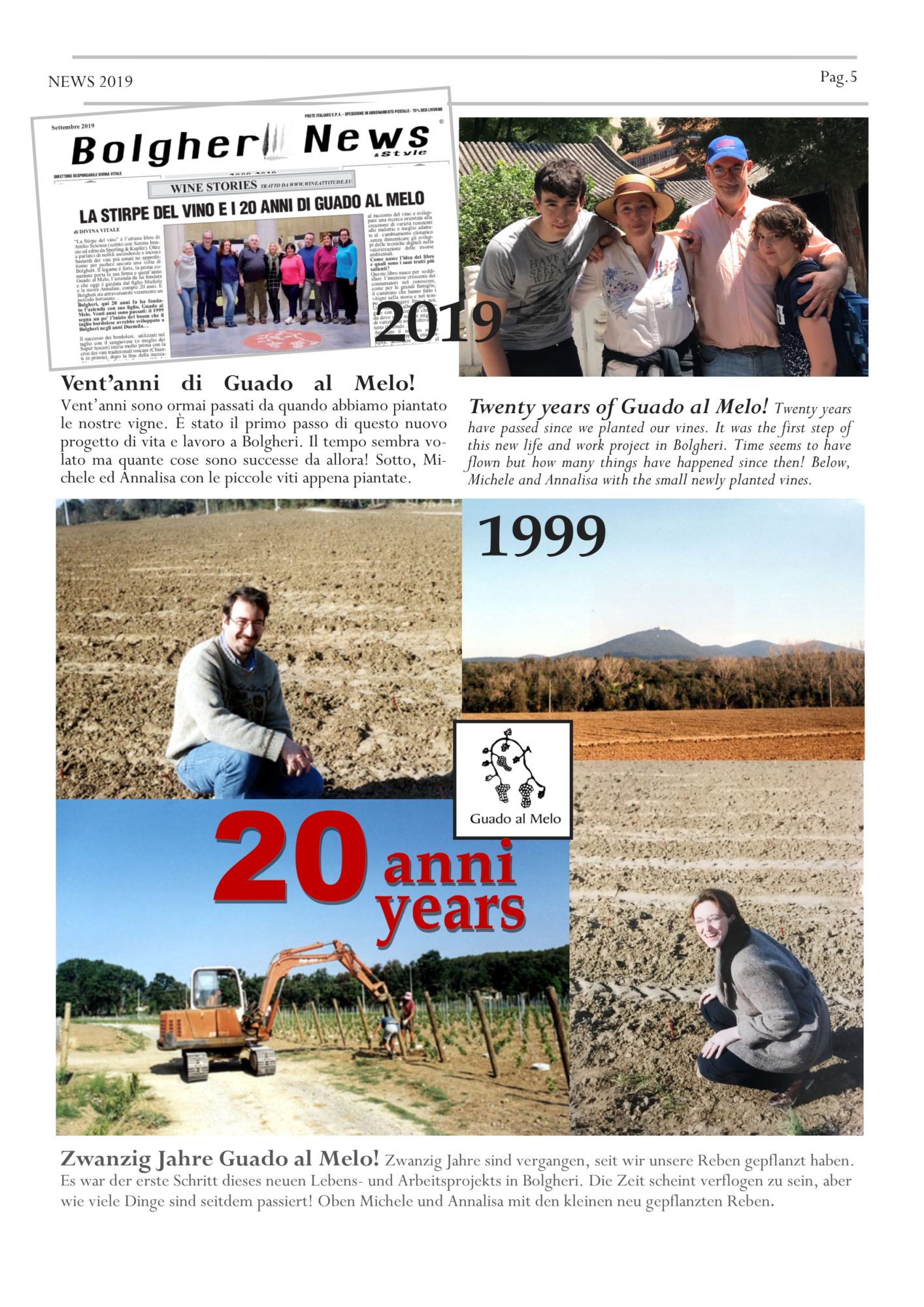
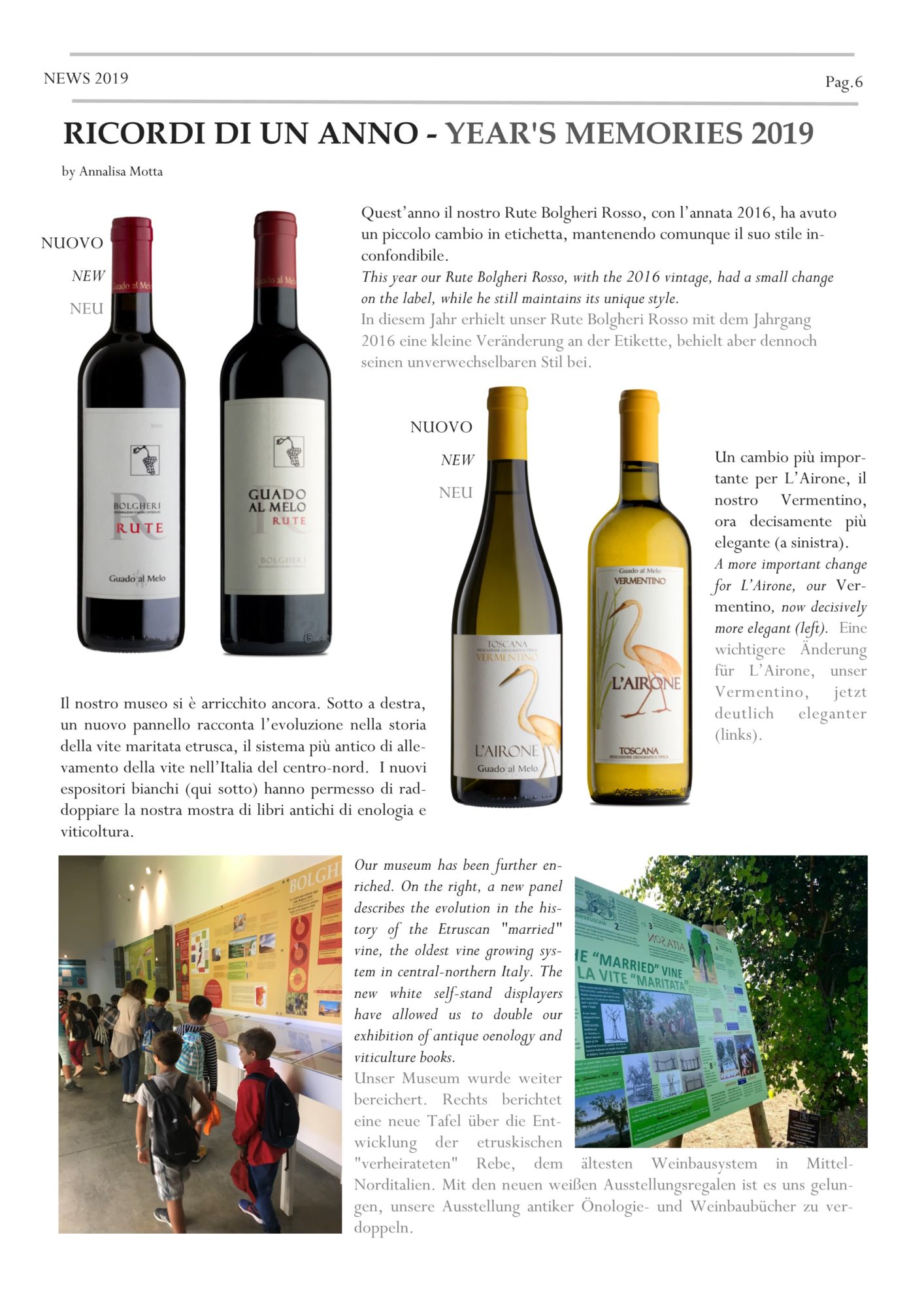
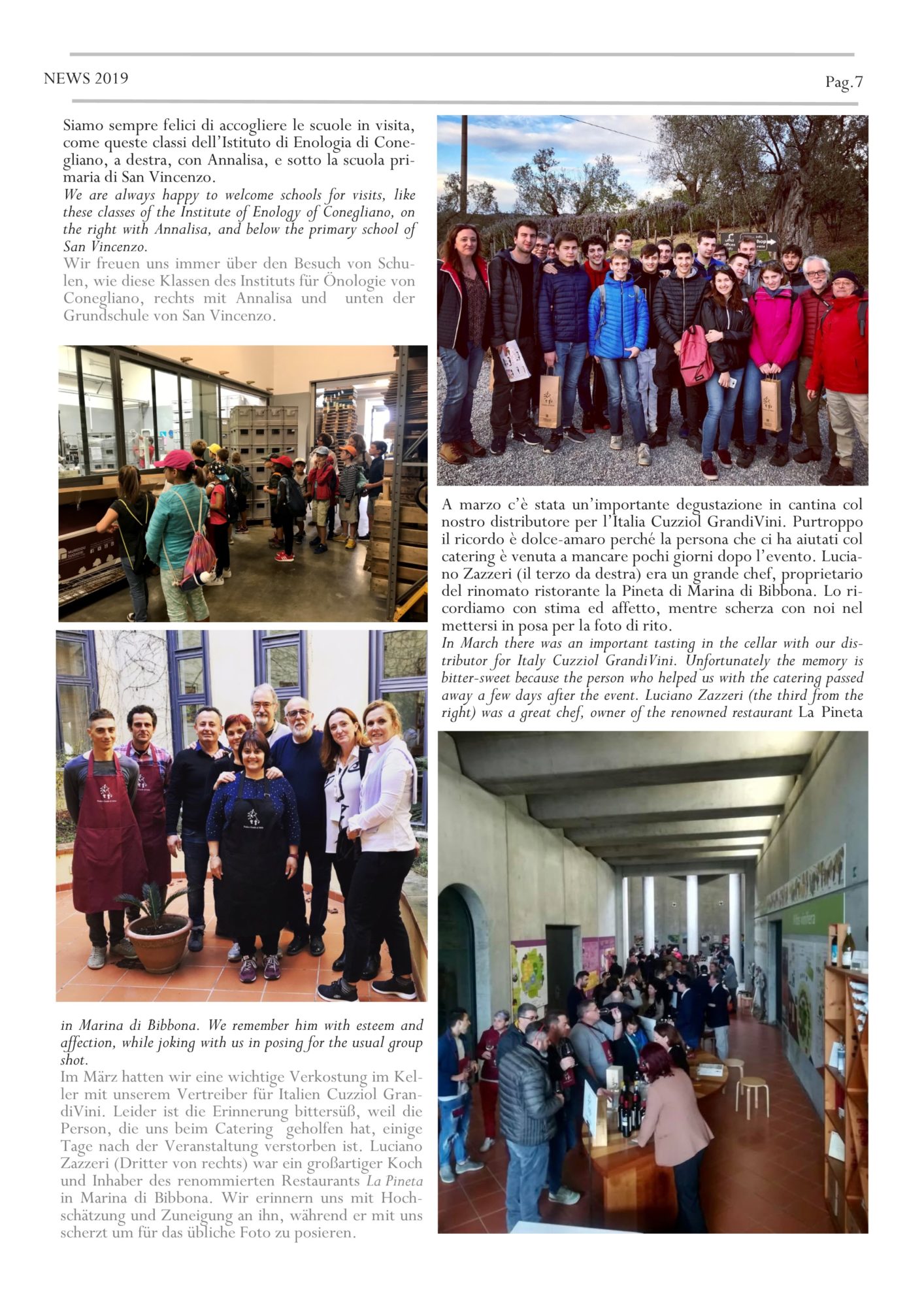
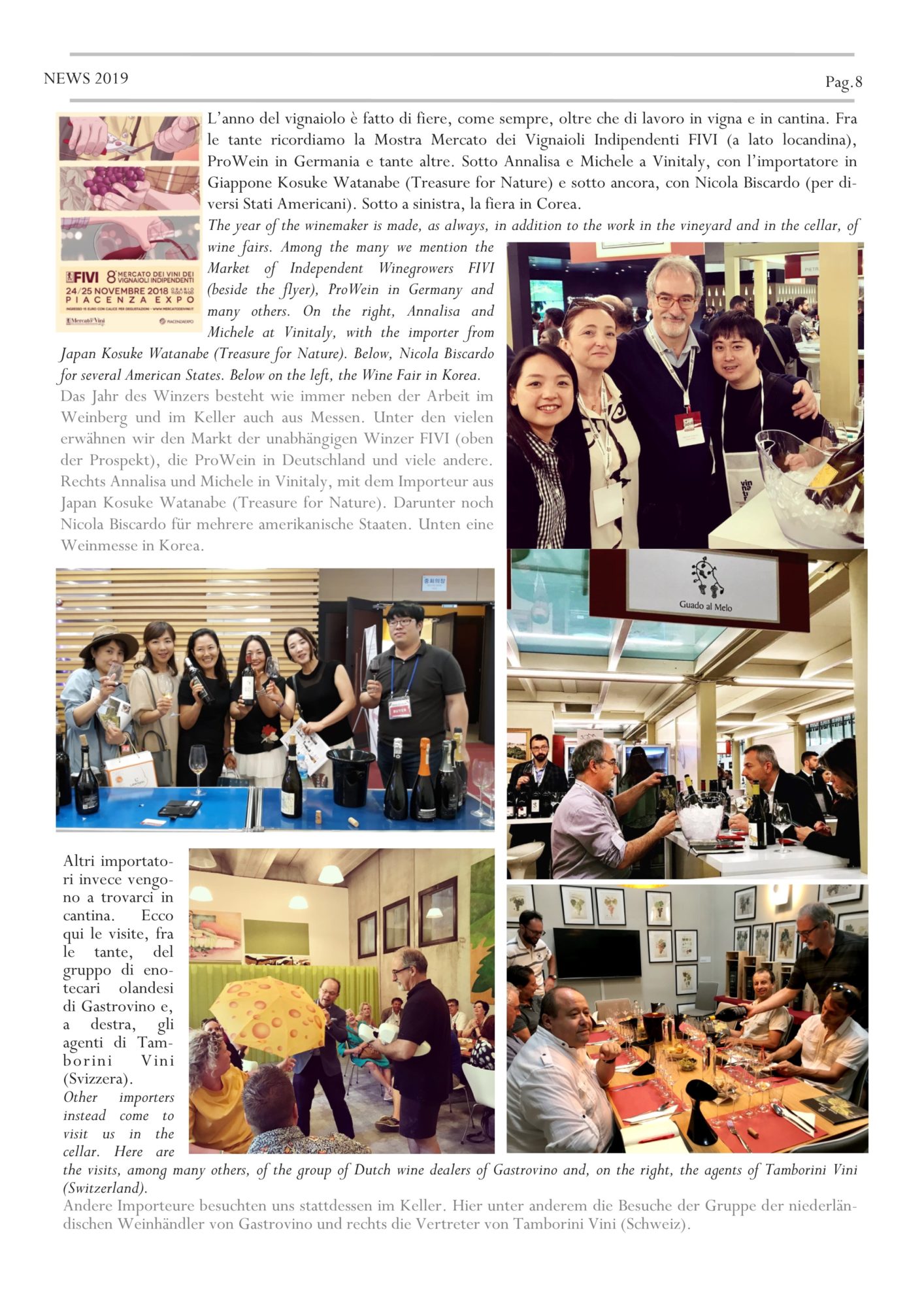
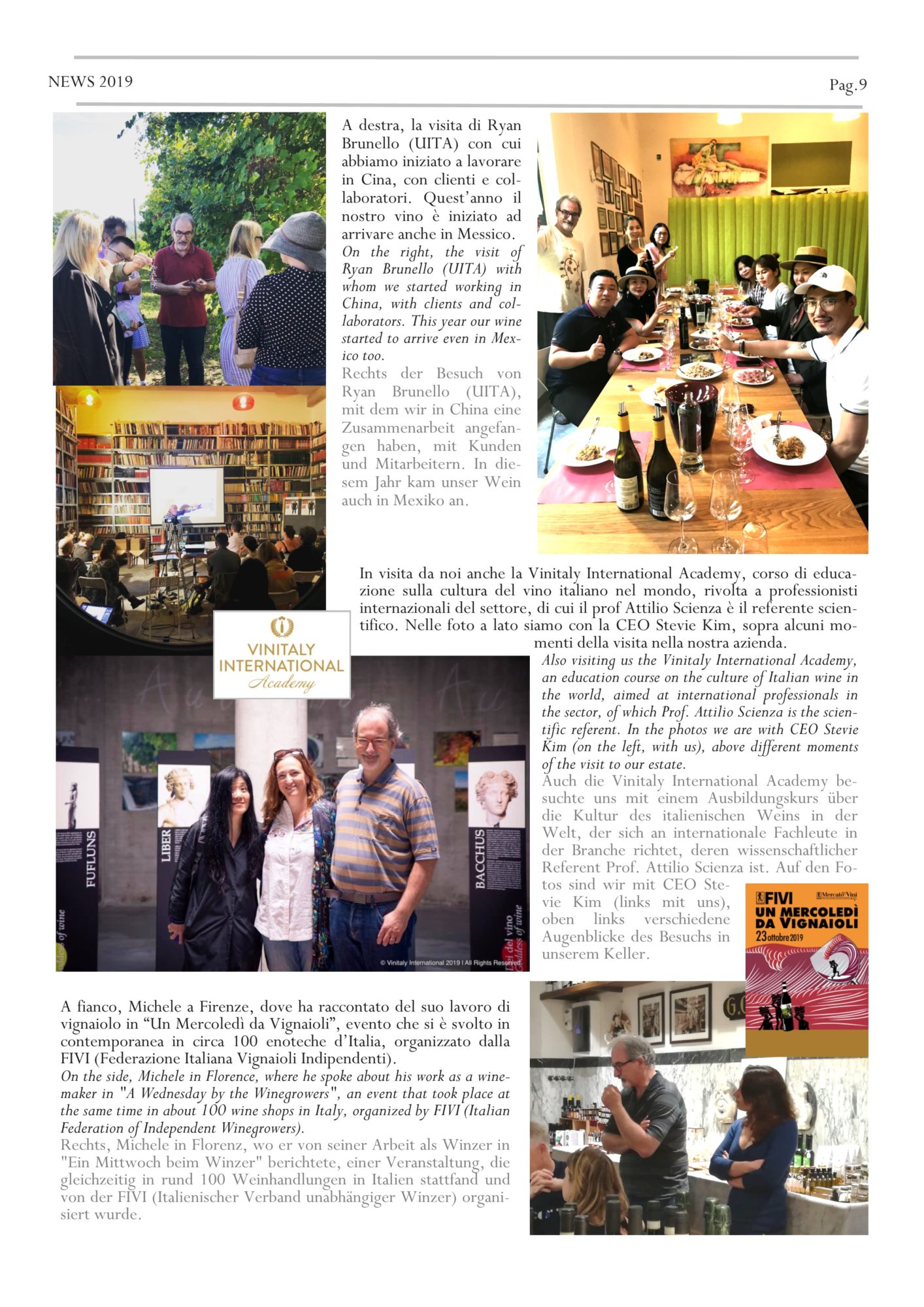
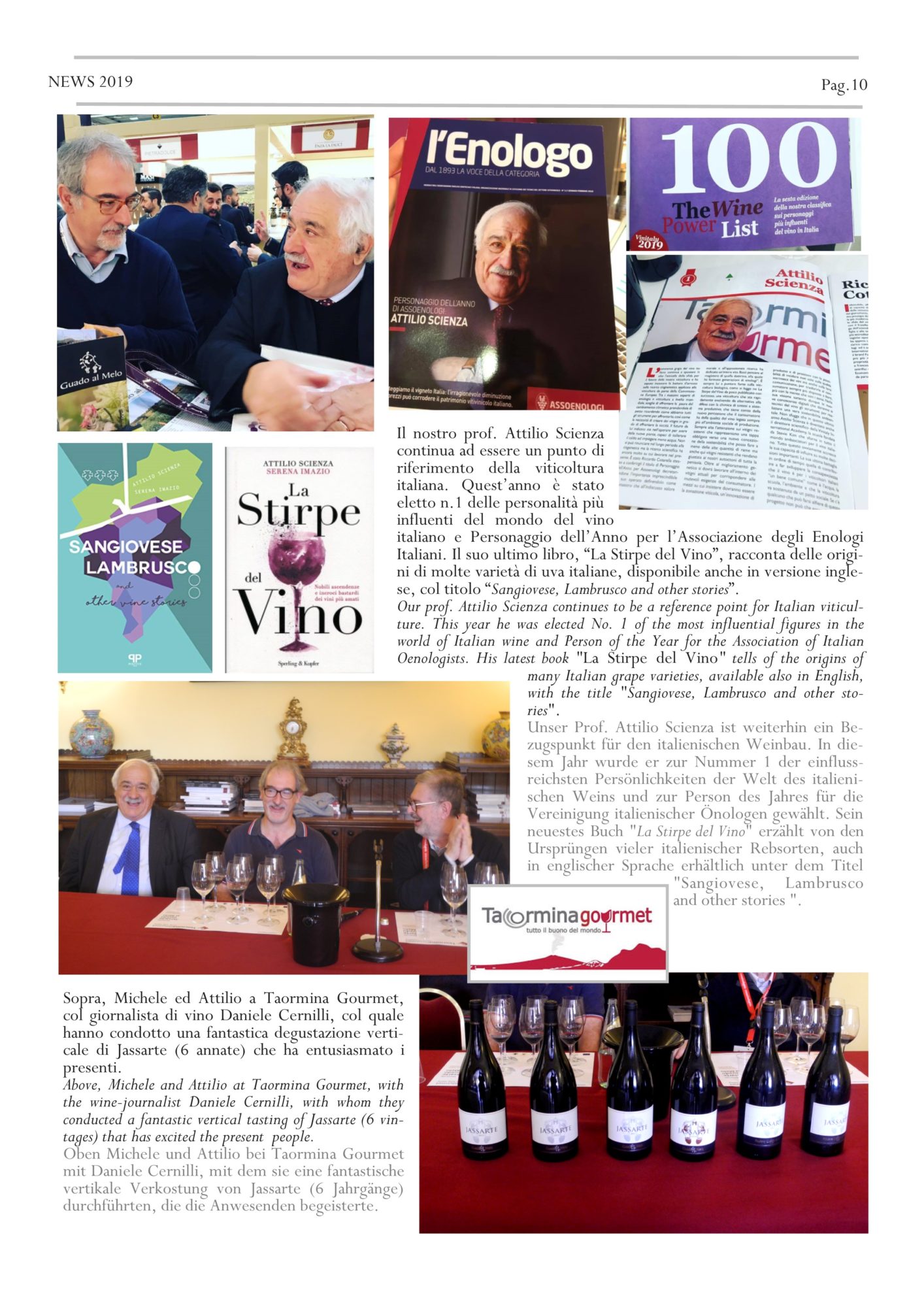

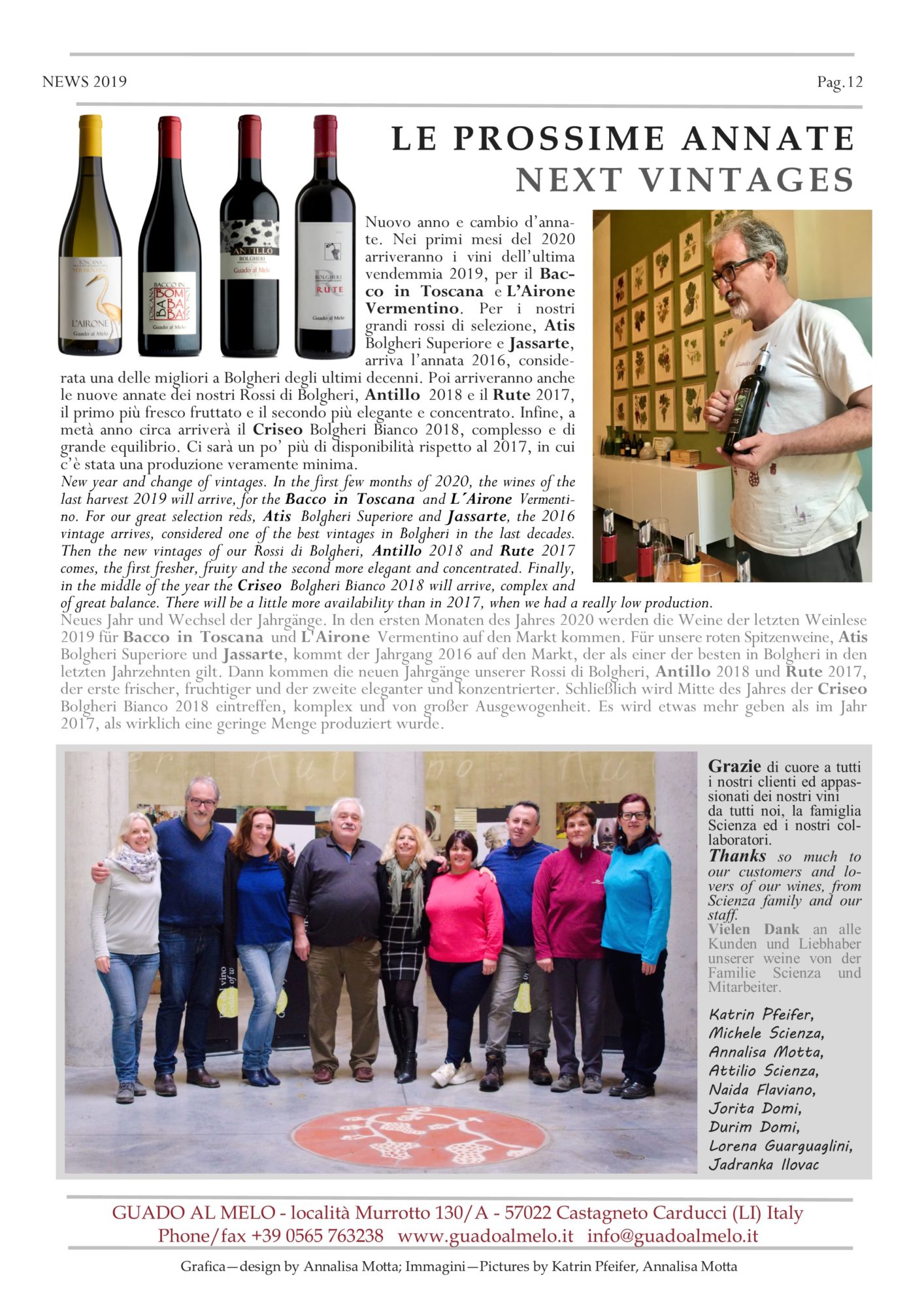
The taste of wine in ancient Roman times
So far, I have spoken about the Roman era in our territory (here and here), about its wine production and European trade.
But, how was this wine?
How can we imagine the taste of Roman wines today?
First of all, let us remember that the Roman period was very long and with great changes. The wines of archaic Rome were certainly very similar to those of ancient Greece and the Etruscans. In those remote eras, limited production techniques produced wines with a "difficult" taste, the consumption of which always required the addition of spices, aromas, honey and so on (see here).
In Rome, however, there was a remarkable agronomic and technical evolution over the centuries, reaching a very different production situation, which we will try to understand.
[one_third][info_box title="The Rural Latin writers" image="" animate=""]
There are five fundamental works to learn about Ancient Roman viticulture and wine production, whose authors were called in the past the Rustici Latini (rustic, or rural, because they wrote about agriculture). These are Cato, Varro, Columella, Pliny and Palladius, which I will often quote in my next posts about Roman wine production.
Each of their works "photographs" a different historical moment in the long evolution of Roman agriculture (about thirteen centuries, for the Western Empire). Understanding a culture, an era, cannot be separated from its becoming, as rightly always Emilio Sereni pointed out: the agricultural landscape is not static but extremely subjected to a perennial historical elaboration.
Less specific aids, more sporadic but no less interesting, come from other non-sectoral authors. These are historians, geographers, poets, etc., such as Strabo, Galen, Cicero, Virgil, Horace and many others.
Unfortunately, we also know that only a minimal part of ancient literature has arrived. For example, Varro, in the introduction to his De re rustica, lists fifty agronomic works in Greek to which he refers, now lost.
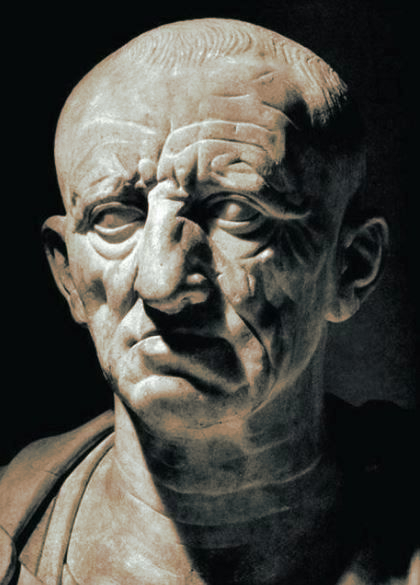 THE MANAGER: Cato (Marcus Porcius Cato, known as Censorius, the Censor, Tusculum 234- Rome 149 BC), military and politician, wrote his work De agri cultura (or De re rustica) in the Republican era, published in 160 BC. This is an unstructured series of practical advice addressed to the pater familias, the agricultural owner, above all to push him to move from an ancient and subsistence agriculture to the more profitable one, with economic purposes. We are at the dawn of the then nascent Roman villa, the great farms of the times. Cato wants to re-propose ancient values. His model of the true "civis Romanus" (the Roman citizen) is the "vir bonus colendi peritus", the honest and good farmer, who takes the sword in times of need. The style is meager, a Latin with much archaisms.
THE MANAGER: Cato (Marcus Porcius Cato, known as Censorius, the Censor, Tusculum 234- Rome 149 BC), military and politician, wrote his work De agri cultura (or De re rustica) in the Republican era, published in 160 BC. This is an unstructured series of practical advice addressed to the pater familias, the agricultural owner, above all to push him to move from an ancient and subsistence agriculture to the more profitable one, with economic purposes. We are at the dawn of the then nascent Roman villa, the great farms of the times. Cato wants to re-propose ancient values. His model of the true "civis Romanus" (the Roman citizen) is the "vir bonus colendi peritus", the honest and good farmer, who takes the sword in times of need. The style is meager, a Latin with much archaisms.
 THE INTELLECTUAL: About 120 years later, we have the testimony of Varro, Marcus Terentius Varro, a politician and a scholar (Rieti, 116 BC - Rome, 27 BC). He published his work De re rustica in 32 BC. It is a time of crisis for agriculture, which follows the period of civil wars. At its time the agricultural villa has now evolved towards ever larger estates, to the detriment of small farmers. It has also become a place of pleasure, of refined leisure and rest for the rich owners. The work is in the form of a dialogue between the same author, his wife and friends. The recipients are certainly not the small farmers but the large landowners, with many lands and vast herds, lovers of profit and luxury. He encourages the recovery of the fathers' values, the mos maiorum. With noble nostalgia, he also aestheticizes an idealized country life, simpler and more fulfilling than the city one, full of vice and corruption.
THE INTELLECTUAL: About 120 years later, we have the testimony of Varro, Marcus Terentius Varro, a politician and a scholar (Rieti, 116 BC - Rome, 27 BC). He published his work De re rustica in 32 BC. It is a time of crisis for agriculture, which follows the period of civil wars. At its time the agricultural villa has now evolved towards ever larger estates, to the detriment of small farmers. It has also become a place of pleasure, of refined leisure and rest for the rich owners. The work is in the form of a dialogue between the same author, his wife and friends. The recipients are certainly not the small farmers but the large landowners, with many lands and vast herds, lovers of profit and luxury. He encourages the recovery of the fathers' values, the mos maiorum. With noble nostalgia, he also aestheticizes an idealized country life, simpler and more fulfilling than the city one, full of vice and corruption.
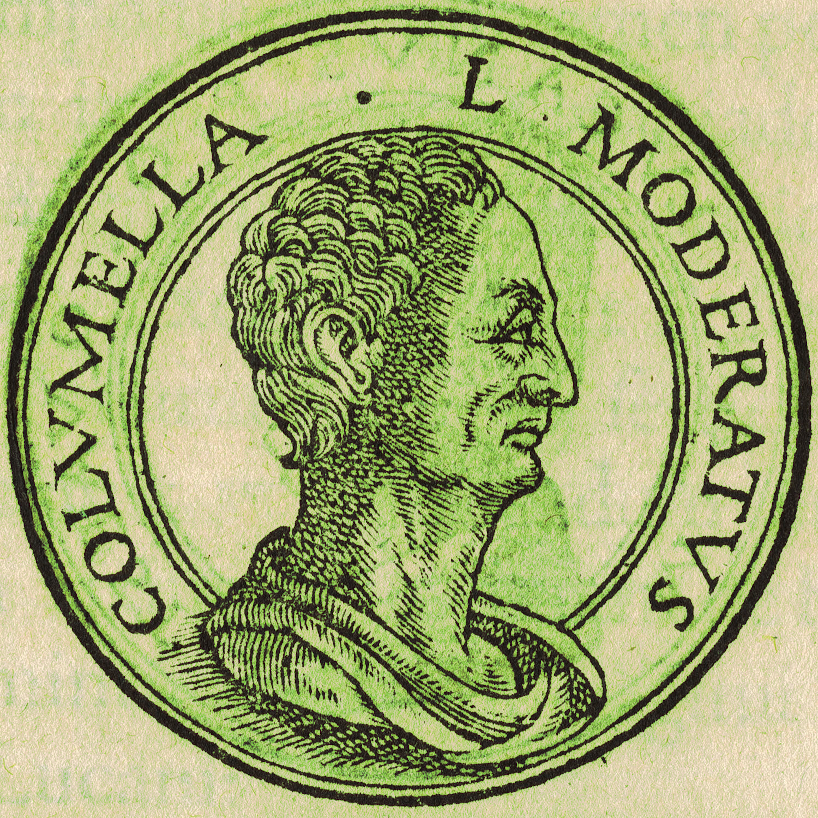 THE AGRONOMIST: we make a jump of about 90 years and we come to the treatise De re rustica by Columella (Lucius Iunius Moderatus Columella, Cadiz 4 d.C. - 70 AD), military tribune and then farmer in his properties in Lazio. It was published between 60 and 65 AD, in Imperial Times. It is considered the first true agronomic treatise in history because its accuracy and completeness . Unlike all the others, it emerges that the writer really took care of the management and works of a farm. We can find the apex of the evolution of Roman agricultural techniques in this work, that has remained unsurpassed for centuries. It is incredibly detailed and precise for viticultural practices. It includes more fragmentary suggestions for the wine-making parts. According to Columella, the farmer must personally take care of the management of his company, adequately training himself by valid texts. Given the mentality of the time, it is striking his exhortation to treat slaves with humanity and familiarity, consulting them also in work choices.
THE AGRONOMIST: we make a jump of about 90 years and we come to the treatise De re rustica by Columella (Lucius Iunius Moderatus Columella, Cadiz 4 d.C. - 70 AD), military tribune and then farmer in his properties in Lazio. It was published between 60 and 65 AD, in Imperial Times. It is considered the first true agronomic treatise in history because its accuracy and completeness . Unlike all the others, it emerges that the writer really took care of the management and works of a farm. We can find the apex of the evolution of Roman agricultural techniques in this work, that has remained unsurpassed for centuries. It is incredibly detailed and precise for viticultural practices. It includes more fragmentary suggestions for the wine-making parts. According to Columella, the farmer must personally take care of the management of his company, adequately training himself by valid texts. Given the mentality of the time, it is striking his exhortation to treat slaves with humanity and familiarity, consulting them also in work choices.
 THE ENCYCLOPEDIC: contemporary of Columella, Pliny (Pliny the Elder, Gaius Plinius Secundus, Como 23- Stabia 79 AD) gave a remarkable contribution with his masterpiece Naturalis Historia, written in 73 AD. It is a general and very vast compendium on the knowledge of the epoch that ranges from geography, to anthropology, to botany, etc. Sometimes, however, he let himself get carried away by the taste of fantastic and emphasis. Pliny died in one of the greatest catastrophes recorded in history, the eruption of Vesuvius in 79. Driven by his scientific curiosity to observe the phenomenon, he died from poisonous fumes. His work is important for wine history because it provides various indications on the viticulture and wine production of his era, the list of many varieties of grapes and wines, as well as on the diffusion of viticulture in Europe.
THE ENCYCLOPEDIC: contemporary of Columella, Pliny (Pliny the Elder, Gaius Plinius Secundus, Como 23- Stabia 79 AD) gave a remarkable contribution with his masterpiece Naturalis Historia, written in 73 AD. It is a general and very vast compendium on the knowledge of the epoch that ranges from geography, to anthropology, to botany, etc. Sometimes, however, he let himself get carried away by the taste of fantastic and emphasis. Pliny died in one of the greatest catastrophes recorded in history, the eruption of Vesuvius in 79. Driven by his scientific curiosity to observe the phenomenon, he died from poisonous fumes. His work is important for wine history because it provides various indications on the viticulture and wine production of his era, the list of many varieties of grapes and wines, as well as on the diffusion of viticulture in Europe.
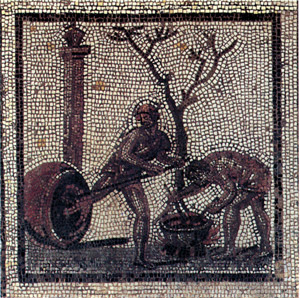 THE COUNTRY GENTLEMAN: we make a leap of about two hundred years and we arrive at the last great author of agriculture of the Latin era, in the Late Empire (IV century AD), the Palladius (Rutilius Taurus Aemilianus Palladius). He was a rich and noble landowner, author of Opus agriculturae or De re rustica, which is a sort of rural calendar, in which he explains the agricultural work for the different periods of the year. In reality it does not make technical evolutions that go beyond Columella. However, his historical testimony is very interesting, as well as from a linguistic point of view, with a Latin mixed with vernacular words.
THE COUNTRY GENTLEMAN: we make a leap of about two hundred years and we arrive at the last great author of agriculture of the Latin era, in the Late Empire (IV century AD), the Palladius (Rutilius Taurus Aemilianus Palladius). He was a rich and noble landowner, author of Opus agriculturae or De re rustica, which is a sort of rural calendar, in which he explains the agricultural work for the different periods of the year. In reality it does not make technical evolutions that go beyond Columella. However, his historical testimony is very interesting, as well as from a linguistic point of view, with a Latin mixed with vernacular words.
There are other classical authors, such as Cassianus Bassus (the Geoponics, 6th century AD) from the Eastern Roman Empire. They are considered less interesting because they have no original contributions. Their works are often collection of quotes from the previous authors. After Palladio, in the West, there was a void of about eight centuries, up to the first and only medieval agronomic text considered significant, written in 1304 by the Bolognese Pietro De’ Crescenzi (he draws a lot from the Rural Latin authors too).
Columella's work, however, will remain the reference agricultural text for the West at least until the 18th century.
[/info_box][/one_third]
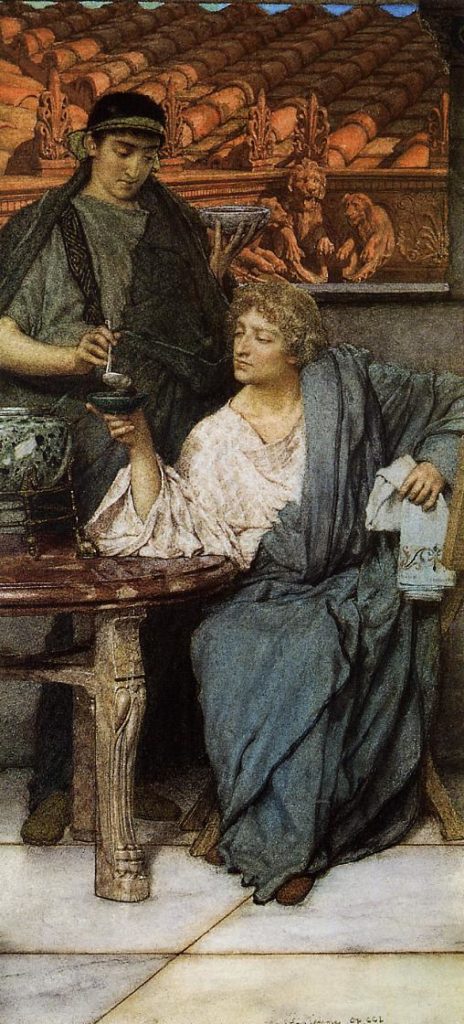
Unlike the Etruscans, we have many direct testimonies of this era (see the box on the side). We can therefore say that we know a lot about the wines of Rome, but also that we do not know everything. In fact, these writings are incredibly detailed in some respects (see for example Columella, with his long and meticulous descriptions about vines propagation) but also incredibly incomplete on others, especially about cellar practices. About the description of grapes and wines, we have just lists or fleeting suggestions.
Several Roman authors insert here and there the praise of a fine wine or the contempt for a bad one, with adjectives that can resemble those we use today, without never giving us an exhaustive description. Depending on the case, the taste of the wine is defined austerum (austere), dulce (sweet), tenue (light), pretiosum (used for velvety, soft wines), solidum or consistens (full-bodied, structured ones), ardens, indomitus or generosus (for wines with important alcoholic gradations), fragrans (fragrant). There are also adjectives as suave (semi-sweet, drinkable), vetulus (old), fumosus (with a smoky taste). The sparkling wines are saliens, titillans, spumans, spumescens, made such by the presence of the bullulae, the bubbles (in late Latin). There is no lack of criticism for a wine that is fugens (weak), asperum (acetic), acerbum, agre or acutum (too acid), vapidum (that has lost its characteristics), faeculentum (turbid), sordidum (of very poor quality), etc. Of course, there were also expert tasters at the time, called haustores.
However, we thinks often about Roman wines as strange concoctions, added with incredible things. Are we really sure?
According to Plinio, the great wines are recognized precisely from the fact of being good by themself. It is therefore a sin to spoil them by adding more. Conversely, if the place produces weak wine or if the vines are young, he advises to intervene by different practices to improve the taste and prolong the wine life.
Columella also clearly says that wines from the best grapes and from the best territories do not need any particular cellar intervention. It seems to feel a today's artisan winemaker:
"We will consider excellent any quality of wine that can age without any addition, without mixing any substances which can altered its natural flavor. In fact, the best things are those that can be appreciated for their intrinsic characteristics”.
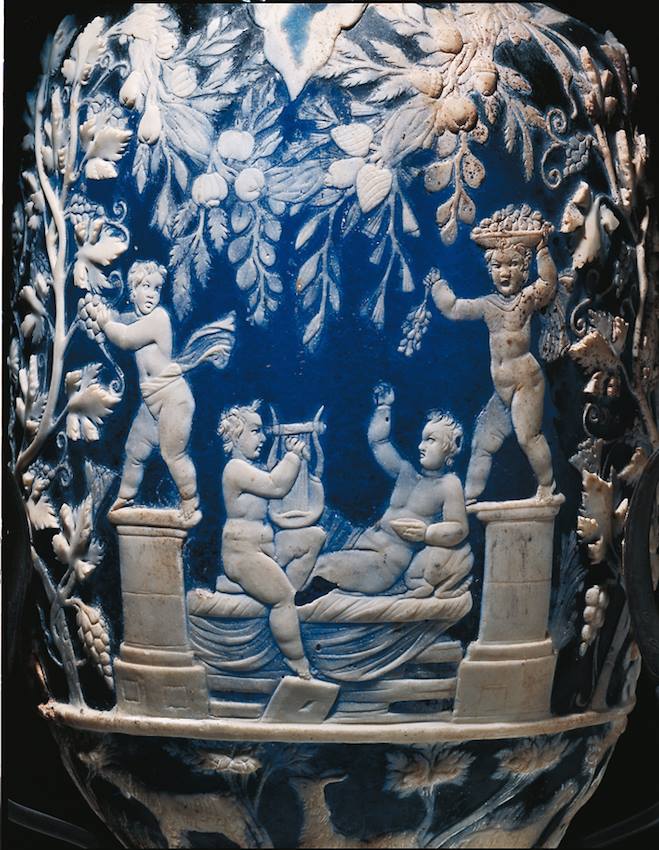
Columella, however, gives us a "prank": he does not explain us, in detail, the winemaking practices for the great wines, those that did not need any addition. Especially, macerations are a great mystery. From the other authors we can expect it, but not from him.
Perhaps he is like a great cook, who does not think of writing all the passages of his recipes because he takes him readers' knowledge for granted. Or, perhaps, he is more thorough in describing viticulture because he knows it better, while about winemaking he reports (more briefly) the experience of others. Or, simply, he does not attach importance to these steps. We will never know. Like Pliny, he lingers long on the advice for handling and the additions to the less valuable wines.
However, all ancient texts reveal two distinct types of wines, common to all eras: those of high value and those of low level.
The high quality and high price wines are described as very pleasant and refined, capable of very long aging.
They are produced mainly from the estates of Roman patrician families, located outside Rome or, above all, in the area of North Campania. This is a typical element of the wine production of all times, including ours: the best wines are not only the good ones, but those that are produced by wineries or production areas that manage to impose themselves for reasons of power and wealth, besides geographical ones. It cannot be denied that in the past often the best production techniques were exclusive to those who had a higher education and the possibility of buying the best technologies of the time, thanks to their social position. Today the greater economic capacities essentially allow a much more effective marketing, precluded to the smallest winemakers.
The largest production, on the other hand, involved modest wines of low value and cost. They were not only simpler in taste, as happens today for cheaper wines. They were wines that underwent numerous manipulations and corrections in the cellar. Their not excellent taste was often covered with addition of aromas, spices, honey or cooked must, as in the Roman archaic era.
 Starting from these incomplete sources, wine historians have made various hypotheses over time on how the best Roman wines could be. The Italian specialist Antonio Saltini examidem them. In 1839, Giorgio Gallesio assumed that luxury Roman wines were all liqueur wines, as the actual Tuscan "Vin santo", but there is no direct evidence in this sense.
Starting from these incomplete sources, wine historians have made various hypotheses over time on how the best Roman wines could be. The Italian specialist Antonio Saltini examidem them. In 1839, Giorgio Gallesio assumed that luxury Roman wines were all liqueur wines, as the actual Tuscan "Vin santo", but there is no direct evidence in this sense.
Hugh Johnson wrote ("The story of wine", 1989) that Roman fine wines were all white and sweet, because no author describes the maceration phase. They sometimes claim to remove the skins quite quickly after grapes squeezing.
His hypothesis, however, goes against the evidence that Latin texts speak widely of wines of many colors, even more than today. The reds are distinct in: sanguineum (blood color), purpureum (purple), niger or ater (black or dark). Then there are: album (white), fulvum (orange or amber?), pallidum (Galen describes it as a in-between white and orange), rubellum (rosé?). We must remember that, in any case, too long periods of maceration are not needed to extract color.
Some descriptions of the wines already mentioned above do not play in favor of this thesis. For example, Horace, in ode XXVII book I, uses the expression severi falerni, which gives more the idea of an austere rather than sweet Falerno wine.
Moreover, the long aging of a wine with a sugary residue is much less easy than for a dry one, especially without our modern technical competences, unless it is a mutated wine (a technique with which fermentation is blocked with the addition of alcohol, which acts as a preservative thanks to the fact that it prevents the development of any micro-organism; it is typical of the production of sweet aging wines such as Marsala, Porto, Madera or different Muscat from southern France). However, this practice was unknown to the Romans, as far as we know; it was introduced only from the 13th century.
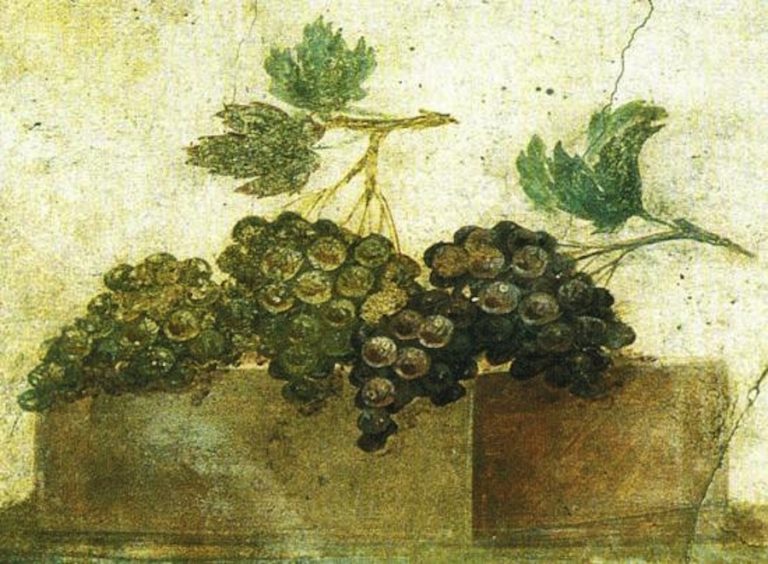
Tim Unwin wrote in his "Wine and the Vine: An Historical Geography of Viticulture and the Wine Trade" (1993) that the best wines of Rome were suitable for very long aging because they were subjected to very long macerations at high temperatures, so as to extract all the color and tannin possible from the skins. These hypotheses are not supported by the sources, as already explained above. Furthermore, this production system would lead to other inconveniences that are not really of high quality. However, the acid component of the wine is much more important for a long aging than tannin. Acidity depends above all on the compositional balance of the grapes.
Antonio Saltini is more in agreement with Dalmasso and Marescalchi ("History of the vine and wine in Italy", 1931-1933-1937), which argued that it is very difficult for us to imagine wines that have undergone smoking in the apotheca and the decades-long aging times ( sometime also centenarians), which Latin authors often boast of the most prestigious wines, or with the "strange" additions made to less valuable wines (such as sea water or other).
I think, however, that many questions remain unanswered. Does the passage in the heat of the apotheca change the taste of the wine or it serve only to heat the amphorae? Are true these incredibly long aging times or only hyperboles to praise a wine?
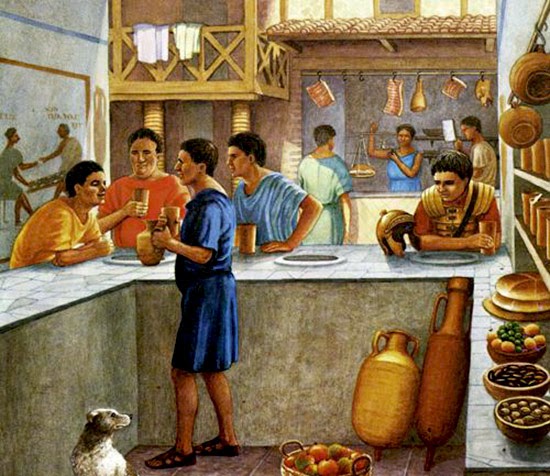 Furthermore, some of the Roman winemaking additions are not so strange as we can think. For example, in all texts about Roman wines we can find their use of pitched amphorae or addition of pitch to the wine. Written like this, out of ignorance, I immediately think of pitch as a derivative of tar. It is very difficult for me to think of drinking anything that has this flavor or was been in contact with it. However, I tried to go deeper (thanks to Luigi Manzi "Viticulture and enology among the Romans", 1883 and the modern archeologists analysis of these compounds) and found that in ancient times the term also has another meaning, today in disuse or little known. In fact, the pitch is nothing but resins of some trees. We will see these aspects in more detail later, as I will explain to you that other strange additions actually are close to some wine adulteration of even more recent eras.
Furthermore, some of the Roman winemaking additions are not so strange as we can think. For example, in all texts about Roman wines we can find their use of pitched amphorae or addition of pitch to the wine. Written like this, out of ignorance, I immediately think of pitch as a derivative of tar. It is very difficult for me to think of drinking anything that has this flavor or was been in contact with it. However, I tried to go deeper (thanks to Luigi Manzi "Viticulture and enology among the Romans", 1883 and the modern archeologists analysis of these compounds) and found that in ancient times the term also has another meaning, today in disuse or little known. In fact, the pitch is nothing but resins of some trees. We will see these aspects in more detail later, as I will explain to you that other strange additions actually are close to some wine adulteration of even more recent eras.
If the taste of these wines remains for us a great unfathomable mystery, as well as some aspects of their winemaking, we can say however with Manzi (Luigi Manzi "Viticulture and enology among the Romans", 1883), which they undoubtedly achieved high production levels, with meticulous care of works, both in the vineyard and in the cellar.
Saltini disagrees with Manzi, but I think that a nineteenth-century scholar can better understand Roman viticultural techniques than we can do, with our prejudices. They were more like those of his time that ours. For example, Columella recommends making wine, for great wines, only healthy and well-grown grapes. They already knew very well the importance of temperature during winemaking, moving the amphorae to heat or cold, depending on the winemaking stage or wine typology. They already produced sparkling wines, they already had an awareness of the need for hygiene and cleanliness, etc. Of course, however, they lacked all that knowledge about microbiological aspects, the discovery of which will be a break for the birth of modern wine in the nineteenth century.
 Putting all these elements together, what can we think about the best Roman wines?
Putting all these elements together, what can we think about the best Roman wines?
I think we can dare to approach them to the luxury wines of more recent times, which had a fairly similar level of knowledge and technical development in the vineyard and in the cellar. The Roman best wines may therefore not be so different from the best wines produced between the seventeenth and early nineteenth centuries.
We know that history often repeats itself. The great viticulture and winemaking knowledges of the Romans will be almost completely lost in the Middle Ages, although partly preserved in the libraries of the monasteries. Many of these techniques will then be "rediscovered" in the following centuries, especially from the seventeenth century onwards. The very important leap in knowledge and technology towards the modern wine production will start only in the second part of the nineteenth century.
We can imagine the very small category of luxury wines of these eras as the result of a very accurate production in the vineyard and good winemaking techniques, although still very limited. These wines were characterized by good aromas, body, probably excellent acidity, which made them suitable for long aging. The long aging was possible thanks to the containers (amphorae) well protected from gas exchange thanks to the internal coatings with resins, which also covered the cork stopper. This aging capacity will be re-proposed only from the 17th century onwards, with the introduction of glass bottles closed by cork, which use will be diffusely only since the nineteenth century.
Most likely, they had more or less strong oxidative notes and a more or less intense acetic flavor, as was common in all wines not so long ago. For Roman wines, we must add some more unknown aromas to us, such as the resin flavors (more or less intensely) released by the coating of the containers, perhaps some smoky aromas. These tastes are not familiar for us, but perhaps acceptable for an ancient palate accustomed to them.
This little game is over, in the next post I will tell, in broad terms, the viticulture and the Roman enology.
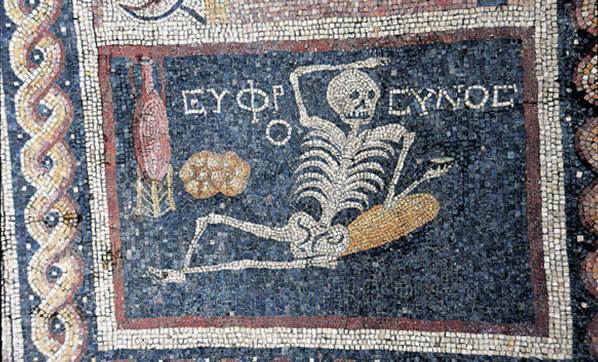
Bibliography
Columella, "De re rustica" , 65 d.C.
Luigi Manzi "La viticoltura e l'enologia presso i Romani", 1883
Dalmasso e Marescalchi, “Storia della vite e del vino in Italia", 1931-1933-1937
Emilio Sereni, "Storia del paesaggio agrario italiano", 1961
Enrico Guagnini, "Il vino nella storia", 1981
Hugh Johnson, "The story of wine", 1989
Tim Unwin, "Wine and the Vine: An Historical Geography of Viticulture and the Wine Trade" (1993)
Antonio Saltini, "Storia delle pratiche di cantina, Enologia antica, enologia moderna, un solo vino o bevande incomparabili?", Rivista di Storia dell'Agricoltura a. XXXVIII, n. 1, giugno 1998
Bolgheri and the Roman times (2): the Bolgheri "villa"
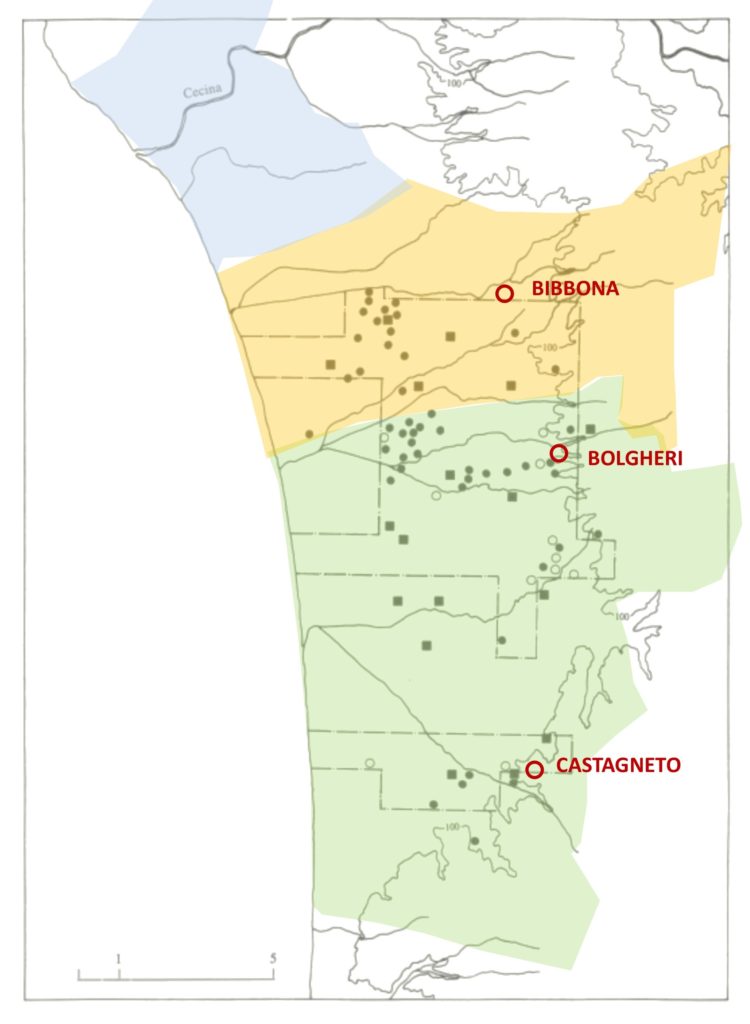
In the first part I told about the mutations of our territory in Roman times compared to the Etruscan one, but also about how culture and social base have not changed so much.
Let ‘us now know better the local villae and how the ancient era ended in our territory.
(Remember: in Latin, "villa" is the singular, "villae" the plural).
The peculiarities of the "Bolgheri villa"
Many villae were born in the ager Volaterranus (the countryside of Volterra). They were the big farms of the time, that produced above all wine, olive oil and wheat. Only in the area closest to us, as many as 19 were found, born between the II century BC and the first half of the first century AC. They survived almost until the end of the ancient era.
As can be seen from the map (the villae are represented by little squares), they developed mainly in the intermediate flat areas, far from the marshy coast, (more or less) along the line of what was to be the ancient Aurelian Way. Other villae are in the highest plain and on the first hills (on the right in the map). They are the same areas as today's farms and wineries. However, let's not take it for granted: between the prosperous Roman era and the actual situation there have been many centuries in which the territory was decidedly different.
The more classical Roman villae in the center or south of Italy, overall those in Campania (properties of the patrician families of Rome) were very rich and profitable farms. They were very specialized and based on slave’s work. They also had a relatively short life. They became larger and larger estates, with the concentration of Rome's wealth in fewer and fewer hands. However, the enlargement made less convenient to invest in specialized agriculture. They were also thrown into crisis by the competition of extra-Italian colonies: they did not hold at the lowest price of wheat, olive oil and wine from Africa, Spain and Gaul. Many of these farms disappeared by the end of the second century AD. Others were converted in an extensive production of wheat or, above all, to grazing and breeding, with the degradation of the agricultural landscape.
The villae of our area instead were not very specialized, economically more modest, but much more durable. They have in fact survived for a very long time, generally up to the IV-V century AD, in one case even up to the VI. It was probably their local economy that made them longer-lived, less subject to external competition.
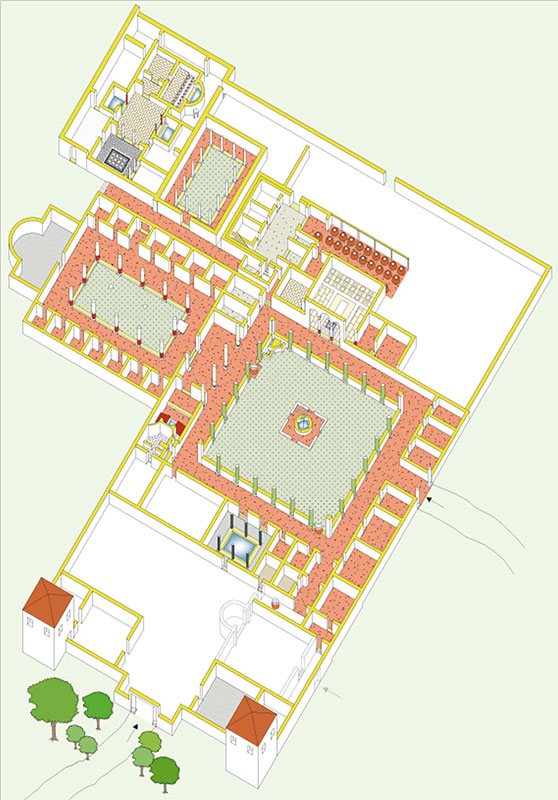
The remains of the local villae occupy surfaces ranging from 2.000 to 10.000 square meters. We do not know the dimension of their agricultural lands. I remember that the villa building included several parts, more or less large, with different names according to their function. The villa urbana was not in the city, but it was the master's house part; the villa rustica instead included the part with workers' quarters, stables and tool deposit. The part called fructuaria comprised the warehouses of agricultural products, the cellars, the granaries and the barns.
Unfortunately, there is little or nothing left of the numerous villae nearly Bolgheri. Not so far, the San Vincenzino Villa is one of the few preserved, which has been the subject of excavations and in-depth studies. It is located at north of Bolgheri, near the mouth of the Cecina river (today Marina di Cecina). It was owned by the already mentioned Caecinae family. Here there is the reconstruction of its planimetry. In the upper part of it you can also see the cellar, with the buried dolii (the wine-making amphoras). Below is there are a 3D reconstruction and a video that allows you to explore it. 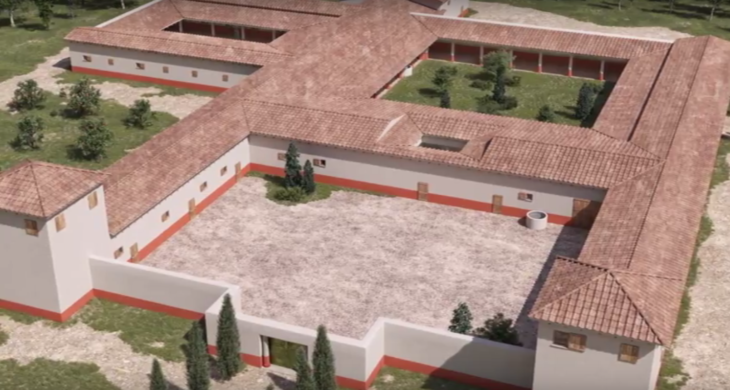
The remains of the villae of the ager Volaterraneus include building material (bricks, roof tiles, stones, etc.), dolii and amphoras of different types. Unlike the villae of other areas, which over time also became refined dwellings (for the villa urbana), here it is rare to find luxurious decorative parts. Perhaps they were less used as residences, more dedicated to strictly agricultural purposes.
The decoration was found only in very few cases, which occurred however in much later times than elsewhere, only from the second century AD (in other parts this evolution took place already from the end of the I century BC). An important example of embellishment is the Castagneto Carducci Mosaic Villa (see box). Even the San Vincenzino Villa was added of rich decorations only from the end of the second century and, in several phases, up to the fifth. Perhaps there was a late discovery of the pleasures of country life, rather than a disaffection for that of the city. Perhaps it is no coincidence that this new course corresponds to the historical period of the decadence of Volterra.
[three_fifth][info_box title="The Mosaic Villa of Castagneto Carducci" image=" animate=""] 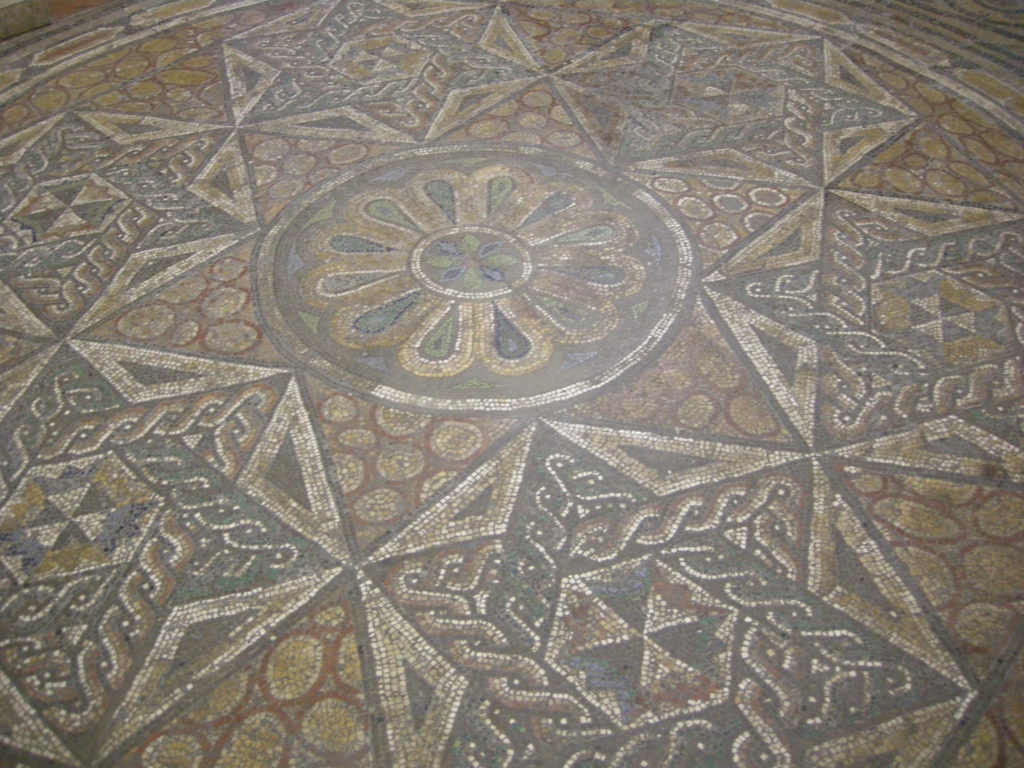
At the foot of our Segalari hill, a little further towards Castagneto, the part of a sumptuous two-story Roman villa was found in the mid-nineteenth century. It was called Mosaic Villa because of the well-preserved mosaic floors. It dates back to the Augustan age (I century AD), while the mosaics were the result of a subsequent restructuring, of the II century AD.
Given the mentality of the time of the discovery, the mosaics were detached and taken to the Guarnacci Museum of Volterra. The remains of the villa were abandoned and have now completely disappeared (perhaps the stones were used for constructive purposes, as probably for the remains of many other local villae). The mosaics can still be seen today in the rooms of the first floor of the museum, even if their history and provenance are not told. At least, however, they were saved.[/info_box][/three_fifth]
Several of the particular characteristics so far listed of the villae of the ager Volaterranus (the scarce economic propensity, the owners of Etruscan descent, the lack of a typical Roman style villa life, the particular relationship with the people of the villages and small settlements, etc. ) have made archaeologists think that, at least in the first centuries, these estates had a different meaning compared to the Roman mentality.
In Roman culture the villa was born as an economic investment devoted to intensive agriculture, as Cato tells in the II century AC. Varo tells us, about 120 years later, that the villa then evolved as a place of intellectual leisure and relaxation for the owners, a refuge from the social and political tensions of city life.
For the local domini (lords), with a Romanized name but perhaps still very tied to the culture of their ancestors, the villa seems at first represent a new prestigious symbol of power and control of the territory, as the great burial mounds of their Etruscan forefathers. The cultural Romanization will be only centuries later.
The local wine trade.
Although they were not very rich and luxurious villae, they produced agricultural products that represented an excellent economic resource for the territory: above all wine, olive oil and cereals. Partly they were consumed locally and partly exported, thanks to good road system (the Aurelian Way) and various ports. They arrived in Volterra mainly by ship, along the Cecina river. For Rome and other destinations, they left from the Vada port and from other smaller ports along the coast.
We are especially interested in wine. Its trade was traced thanks to the recognition of locally produced transport amphorae.
It appears that in the beginning the trade involved the northern area of Etruria. From the first century BC, it expanded: amphorae of wine from the Ager Volaterranus were found on the Ligurian coasts, in those of Mediterranean Gaul, along the river routes of the Rhone and the Rhine. From the III to the VI century AD, the trade returned to being mainly local, but with still finds of local wine amphorae in Rome and in Corsica.

The crisis and the disintegration of our territory.
Already in the third century, there was a general crisis of the Empire that did not however have great repercussions in our territory. Small farms (in fact, several disappeared) suffered the most, minus the villae and the villages that showed mining activities. The real crisis (throughout the Western Roman Empire) began between the fourth and fifth centuries AC, with increasingly important economic and political difficulties.
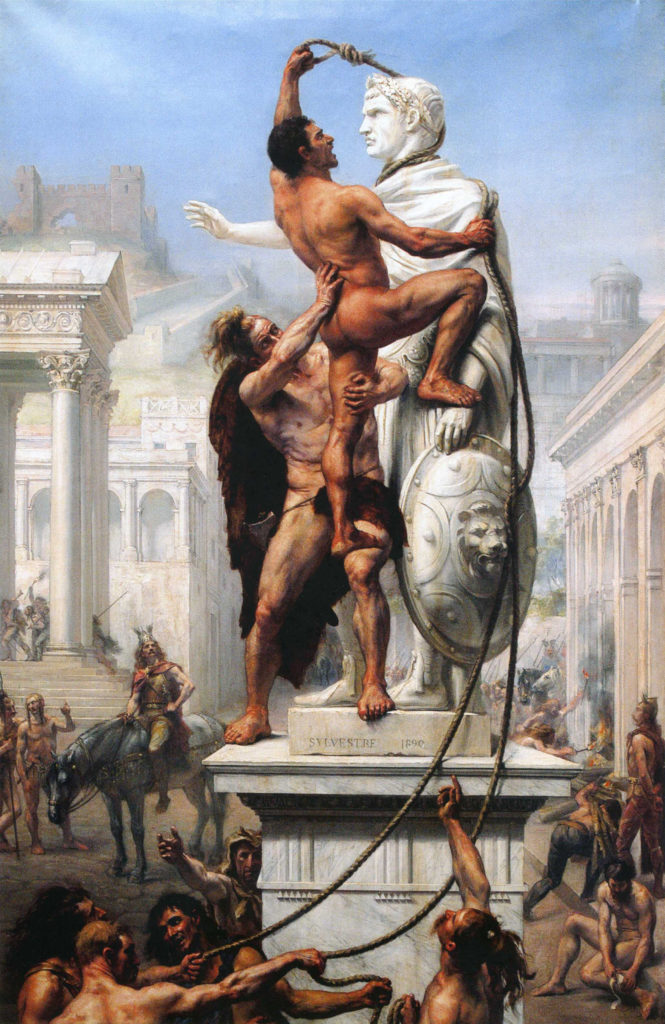
The degradation of the territory spread more and more also due to a progressive depopulation, due to the beginning of barbarian incursions. The first were conducted by the Visigoths (410-412), then by the Vandals. Then the Greek-Gothic war followed, with its destruction, famine and pestilence, ending with the Lombard invasion (end of the 6th century).
The abandonment of the territory led to the gradual came back of coastal wetlands, after millennia of reclamation and care. The swamps will remain for many centuries to come.
The human settlements progressively diminished and the few remaining moved more and more towards the hilly hinterland. On the one hand, the populations escaped the spread of coastal marshes. On the other, they moved away from the Via Aurelia which had now become the gateway to the territory of the raiders.
The Aurelian Way had already been degraded for some time. In the Late Empire many sections of the Roman roads were now impassable, without any maintenance on the part of increasingly weaker administrations. The (aforementioned) Namantianus, at the beginning of the fifth century, tells that he had had to face the journey to Gaul by ship precisely because of the terrible conditions of the Aurelian Way: "I chose the sea because the roads are, in the plains, flooded with rivers and in the hills full of stones. Since the ager Tuscus (the Tuscan countryside) and the Aurelian Way have been taken by storm by the Goths, there is no longer a farm to control the forest, there is no longer a bridge that crosses a river, it is better to rely on my sails and take the road of the sea".
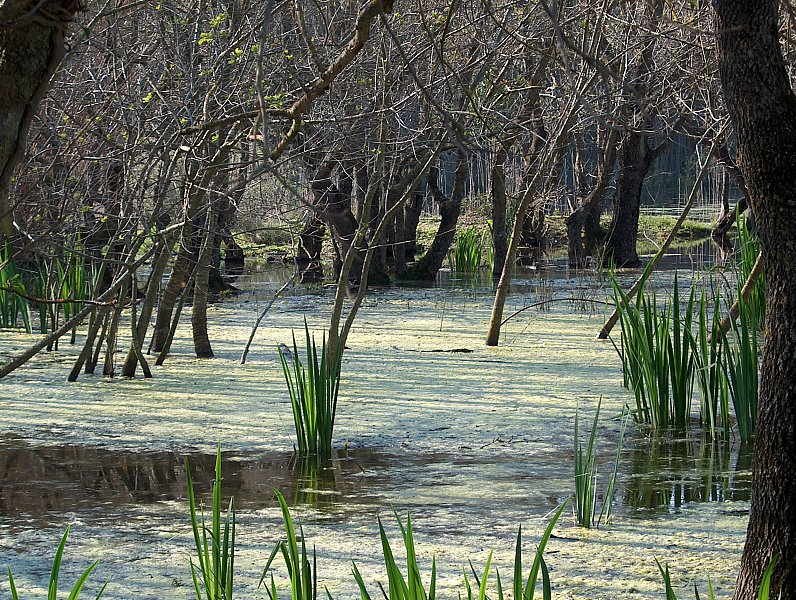 The viability on the lowland was gradually replaced by new inland routes, halfway up the hills or on the ridge, far from the unhealthy air of the marshes, also following the displacement of human settlements. Thus, a new more disorganized road system was born, which responded above all to local needs. This will also be reflected in the birth of the new medieval abbeys, villages and castles, which will take place only in the hill areas. But we will talk later about the Middle Ages.
The viability on the lowland was gradually replaced by new inland routes, halfway up the hills or on the ridge, far from the unhealthy air of the marshes, also following the displacement of human settlements. Thus, a new more disorganized road system was born, which responded above all to local needs. This will also be reflected in the birth of the new medieval abbeys, villages and castles, which will take place only in the hill areas. But we will talk later about the Middle Ages.
The glorious ancient era ended on a territory now almost depopulated and devastated.
In the next posts we will try to better understand how the wines of this era were and how they were produced.
Bibliography:
-"Storia del paesaggio agrario italiano", Emilio Sereni (1961)
-"Analisi di Agricoltura – la viticoltura e l’enologia presso i Romani", Luigi Manzi, 1883, Roma tipografia Eredi Botta.
-"Castello di Donoratico. I risultati delle prime campagne di scavo (2000-2002)" A cura di Giovanna Bianchi, Quaderni dell’università degli Studi di Siena.
-"Populonia e la romanizzazione dell'Etruria Settentrionale", Franco Cambi et al., Atti del Convegno Internazionale Sapienza Università di Roma, 7-9 maggio 2012, 2013.
-"Le stele funerarie d'età imperiale dell'Etruria settentrionale", di Giulio Ciampoltrini, in Prospettiva, 30, 1982, pp. 2-11 "Ricognizioni archeologiche nel territorio di Volterra: la pianura costiera" di Alessandra Saggin and Nicola Terrenato, Archeologia Classica, Vol. 46 (1994), pp. 465-482 (18 pages), Published by: L’Erma di Bretschneider
-"Sepolture tardoantiche in Toscana (III - VI d.C.): i corredi e le epigrafi", di A. Costantini, Published in "Studi Classici e Orientali", 60, 2014, pp. 99-161
-Il Museo Archeologico di Rosignano Marittimo - "Risorse e insediamenti nell’Etruria settentrionale Costiera" - Ministero per i Beni e le Attività Culturali - Polo Museale della Toscana, Soprintendenza Archeologia Belle Arti e Paesaggio per le province di Pisa e Livorno, Comune di Rosignano Marittimo, Museo Civico Archeologico Palazzo Bombardieri Pubblicazioni varie del Museo Archeologico del Territorio di Populonia e dei Parchi della Val di Cornia.
-“Il paesaggio come risorsa – Castagneto negli ultimi due secoli”, Mauro Agnoletti, 2009, Ed. ETS.
https://www.museoarcheologicocecina.it/il-museo-archeologico/la-villa-romana-di-san-vincenzino/
Bolgheri and the Roman times (1): the "ager Volaterranus"
Our territory passed under the Roman domination during the III century BC. It was not as traumatic as elsewhere, in several respects (as I will tell you now).
The production of wine in our area in Roman times is well documented, thanks to the discovery of the remains of numerous villae (the estates of that time) that produced wine, olive oil and cereals. They were in the same area where most of today's wineries are located: the foothills and the high plain between Bolgheri and Castagneto.
[info_box title="A silver wine amphora" image="" animate=""]
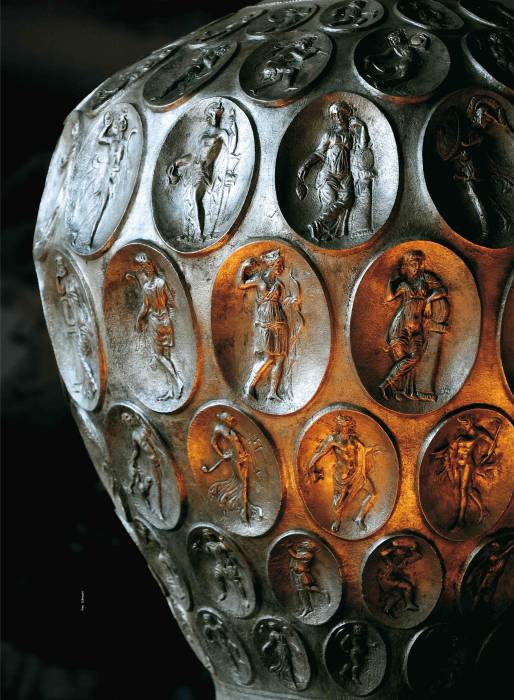
The Roman iconic object of our coast is a precious silver wine amphora, a single piece from the second half of the 4th century. A.D. It was found by a fisherman in the sea of the Gulf of Baratti in 1968. It could hold 22 liters of wine. It has very fine decorations, 132 ovals in each of which a different figure is depicted. There are divinities, characters linked to the cult of Cybele and to the Paris myth, Maenads and Bacchantes. The amphora had to have handles, unfortunately never found. It is kept at the Museum of the Territory of Piombino.
[/info_box]
Traveling along ancient roads
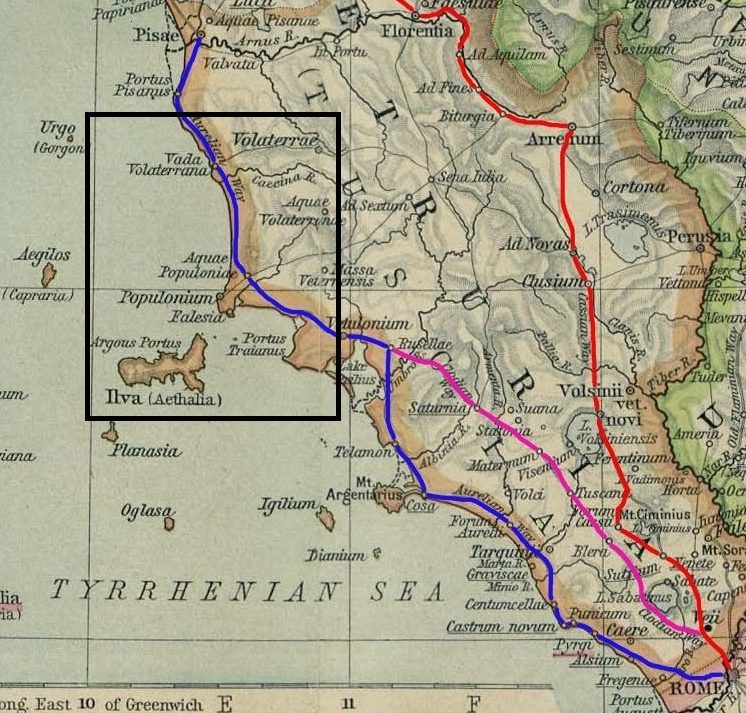
There were no significant towns in our territory (inside the black rectangle on the historical map, between Populonium and Vada Volaterrana), as in the Etruscan era.
Our area was essentially a strip of agricultural land, as today, between the hills to the east and the sea to the west. There were not the coastal pine forests at these times, today so characteristic: they will be planted by man many centuries later.
However, it was a well-populated stretch of coast, with the prevalence (as in the Etruscan era) of a scattered housing model, made up of little farms and villages. In Roman times numerous estates (villae) were also born and the surfaces of cultivated lands increased considerably. Several wooded areas were been deforested with the ancient practice of the fire. The reclamation works of the coastal wetlands, already started by the Etruscans, were also extended.
[one_third][info_box title="The local administrative center" image="" animate=""] 
A fortress dominated our territory from the top of this hill for centuries. It was born in Etruscan times and remained in the Roman one.
This place was continually inhabited from Prehistory to the Middle Ages, when it took the name of Donoratico Castle (in the picture there are the remains of the medieval tower). It evidently was a strategic site, on the top of one of the first hills towards the sea, inclined so as to have a view of the whole coast in a northerly direction. The settlement became a fortress around the middle of the 4th century BC, one of those that Populonia used for the capillary control and defense of its territory. It occupied an area of about 7000 square meters, surrounded by an imposing city wall.
In Roman times it lost its original function and became the administrative center of the territory, in which more and more agricultural settlements were being born. Unfortunately, the site is closed, placed in a private property.
[/info_box][/one_third]
In Etruscan times, Populonium (Populonia) dominated in our area. In the new Roman era the center of power shifted to Volaterrae (Volterra) and our territory become part of the ager Volaterannus (the countryside of Volterra). It included throughout that agricultural area from us up to the promontory of Castiglioncello, and in the Cecina Valley. It was not a very rich agricultural territory but, as we will see, it was exceptionally stable throughout the Roman period, from both social and economic points of view.
One of the most important changes in the Roman era was certainly the construction of the Via Aurelia (Aurelian Way, in blue on the map), one of the great Roman consular roads, built based on the previous Etruscan road system. Nothing remains of this ancient road today. The last testimonies of some original stretches dates to the eighteenth century. The current state road SS1 Aurelia (not the freeway) has almost the same route of the ancient Way; it is thought it was only a little more inland with respect to the actual. The Aurelian Way was built in the 3rd century BC to connect Rome with Cerveteri (Caere on the map). With the conquest of the rest of Etruria, it was continued till Pisa (Pisae), but here he remained firm for some time, due to the difficulty in overcoming the swamps of Versilia area (called Fossae Papirianae) and for the tenacious opposition of the populations of the Apuan Alps. It was completed towards the Liguria region only in the Augustan age (I century AC).

The most important inhabited center in the south was still Populonia (in this era Populonio or Populonium), the ancient Etrusca city Pupluna (or Fufluna). Another small port was born from one of his suburb during Roman period, called Falesia, from which Piombino will develop in the Middle Ages. However, during the Roman times, the powerful Etruscan city began to decline even if, for the first centuries, both the principal port (in the Gulf of Baratti) and the mining district remained important. In fact, iron was useful to supply armies with weapons.
From the 3rd century AD, the mining also stopped and Populonia practically became a village. In the 4th century, nothing remained but ruins of the ancient and glorious city, as recounted by Claudius Rutilius Namatianus, which had traveled by ship along the coast in 415 AD , returning from Rome to the native Gallia:
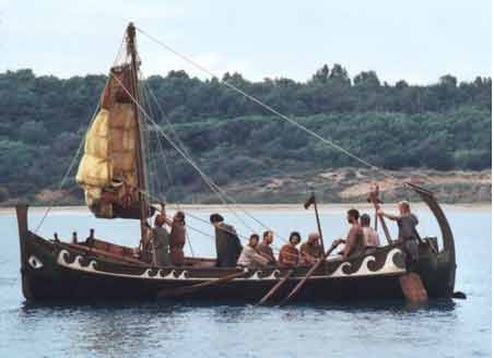
Close by, Populonia opens its dark coast bringing the natural bay right into its fields. …
No longer visible are the monuments of the past: time that devours all has consumed its thick bulwarks.
Bare traces are visible amidst crumbled walls; buried roofs lie beneath the general ruins.
Nor should we fret that mortal bodies dissolve: look well, learn from examples such as this that cities can die.
Claudius Rutilius Namazianus, 417 AC (The Return, I, 401-414)
The coaching inn in the Aurelian Way was in Aquae Populoniae, today Venturina, where there are still the thermal baths. The first place after in the map is Vada Volaterrana (more or less the current Vada, today a little village near Cecina), the ancient port of Volterra, coaching inn and also a center of a saltworks area.
Behind Vada, in the hinterland of the Cecina Valley, there was Volaterrae (Volterra), the ancient Etruscan city Velathri. Unlike Populonia, this city was able to conquer an import role also in this new times. Between the age of Caesar and that of Augustus, it became Colonia Augusta, the political and military center of our entire coast, going through a period of great prosperity. However, in Imperial times, its decline started, because the city was isolated by now from the main street system.

A soft Romanization.
As mentioned, the Romanization was been here less traumatic than elsewhere, especially in the countryside, thanks to the good work of political mediation made by the local aristocratic families. After a bit of ups and downs in their relationship with Rome, they managed to maintain their power, as well as the majority of their land properties.
In other areas of Etruria (and more) the Roman colonization took place according to a more brutal model of conquest: the lands were taken away from the old owners, were centuriated *, divided in small lots and assigned to the Roman veterans. The old Etruscan families disappeared from the positions of power. Later, with the expansion of the properties of the new ruling class, the villae were born, real specialized agricultural estates, to the detriment of small farmers above all. These estates were based essentially on slave labor and they were quite detached from the territorial context.
In our territory this model of colonization occurred only marginally. The landowners remained mostly the same old aristocratic families with Etruscan origin, well-established for centuries, controlling the agriculture and mining resources. They no longer lived in the countryside, but mostly in Volterra, the center of power, or even in Rome, like the richest local family, the Caecinae (Romanization of the Etruscan surname Ceicna).
[one_second][info_box title="The villa in Bolgheri of a noble from Volterra" image="" animate=""]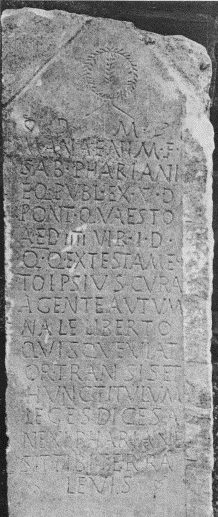
Not so far from Guado al Melo along the Bolgherese Way, in the locality called “Il Puntone di Bolgheri”, there was a Roman villa, today disappeared. Now there is a vineyard of our friend Valerio Cavallini (Campo al Coccio Winery).
Nothing remains except for a funerary stele from the II-III centuries AC, kept in the Cecina Museum, that allowed us to know the ancient owner of the villa.
The stele inscription tells us that it was commissioned by the freedman Autumnalis for a testamentary disposition, to remember the late noble owner. He was a lord from Volterra, the knight Marcus Anaenius Pharianus, municipal magistrate and many other things (the list of titles is very long). The Romanized name does not hide his Etruscan ancestry.
The inscription ends with the classic Latin phrase of the cult of the dead:
SIT TIBI TERRA LEVIS
may the ground be light to you
[/info_box][/one_second]
*Centuriation: the conquered territory was subdivided into centuriae (squares with side of 710 m, with a surface of about 50 hectares) which were the capillary base of the Roman agrarian, social, economic, legal and administrative system. This sort of chessboard was defined by two fundamental lines: the decumanus (generally traced in east-west direction) and the cardus (usually north-south). The centuriae could then be divided into even smaller units, with secondary parallel lines. Once the operations of centuriation and land assignment were carried out, the territory was represented on maps, called formae (very similar to the actual cadastral maps), preserved in duplicate in Rome and in the provincial capital.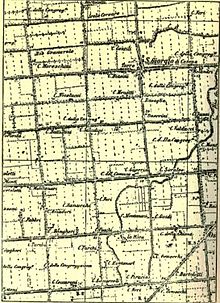
They weren't just ideal lines: along them the boundary fences or hedges were born, as well as the secondary and local public roads leading to the farms, up to the wider system of aqueducts and main roads. The ancient Roman partition of the territory has remained almost unchanged in different parts of Italy, until our days.
During the transition between Etruscan civilization and Romanization, the noble estates of our territory also evolved towards the model of the Roman agricultural villa. However, they were not the property of conquerors but of the descendants of the historical local noble families, who continued to co-exist in a balanced way with the communities of the area.
The basic social model is very different from the slave villae. The workers were, above all, free inhabitants of the nearby settlements. The owners were linked to them by relations of an ancient Etruscan clientele.
This social situation was also reflected in the relationship with small farmers, who did not tend to disappear here but rather to grow in their number. Between the third and second centuries BC, archaeologists have experienced a boom of new small farms (26 in our area). It is not known if the farmers were proprietors or not, more likely they were lessees of lands made available by the nobles.
Even agricultural techniques did not change that much. Etruscan and Roman had in common the same original agricultural matrix, already described here. It was made of rows of vines (supported by trees) or olive trees, alternating with strips of land dedicated to arable land. The Romans, in addition to tracing lines and boundaries, did not greatly change the hydraulic arrangement and the processing of the soils, except to introduce the implantation of vines in small dimples. However, we will learn more later about Roman viticulture and its important developments.
(... continues in the next post, in which we will know better the villae of our territory)
Eccellenze di Toscana 2019
Saturday 30 November and Sunday First Dicember, we will be at the tasting event "Eccellenze di Toscana", during the Fair Wine & Food in Progress, at the Stazione Leopolda in Florence.
There will be Michele Scienza, from 10.00 am h to 7.00 pm. See you.
Wine Fair of the Italian Indipendent Winegrowers (FIVI) 2019
See you at lane D, table n.18 (near the entrance).
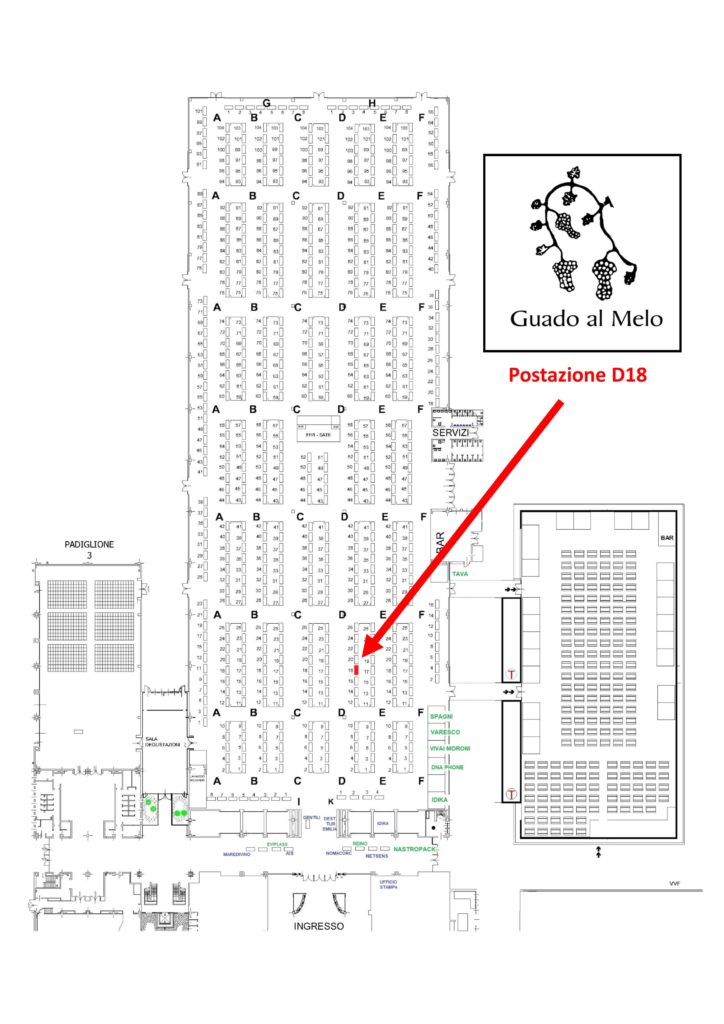
The Italian wine-guide Veronelli awards Atis 2016
We are really happy to announce that the prestigious Italian guide Veronelli has assigned this important recognition to our Atis Bolgheri DOC Superiore 2016.
By the way, it is the third consecutive time that they rewards Atis (except the 2014, that we chose not to produce), with three remarkable vintages for our territory: 2013, 2015, 2016.
Thank you very much to the editorial.
The award TreBicchieri of Gambero Rosso to Criseo 2017
This award for the Criseo Bolgheri DOC Bianco 2017 is a great pleasure for us, especially because it is the first Bolgheri white wine to receive this coveted prize.
We are particularly excited because we cannot hide the fact that it has not been easy to propose and support a wine such as Criseo in recent years, a white from a single vineyard, a field-blend of 5 varieties, aged on the yeast, in a territory that today is considered the home of great red wines, and (for critics) suitable for pleasant white wines without too many pretensions.
Criseo has instead demonstrated the whole greatness of Bolgheri and of the idea conceived twenty years ago by a craft winegrower, Michele Scienza. An idea that was not born from nothing, but from the awareness of having a great terroir behind it, or genius loci (as we love to say, in Latin style), able to give solidity to his ideas and passions.
Michele thoroughly evaluated the climate and soil characteristics of this vineyard (Campo Bianco 0,7 Ha) in the Bolgheri hills, as well as an ancient history of local viticulture widely dedicated to white wines, although now almost forgotten and (in many ways) underestimated. To all this he added his more northern origin and personal training, that made him able to measure himself in the cellar with all that respect and that sensitivity of management of the grapes, indispensable for obtaining a great white wine, perfect balance of complexity and finesse, capable of lasting over time.
The only regret is that the 2017 vintage, so difficult on the one hand but that has also given us so much in quality from the other, has been marked by the lowest production as ever in quantity.
Atis 2016 one of the best Italian wines for Bibenda
Thanks so much to the Italian Sommelier Foundation. In their wine guide Bibenda, they awards the maximum score (5 grapes) to our Atis Bolgheri DOC Superiore 2016.
The Vinitaly International Academy at Guado al Melo: the future Italian Wine Ambassadors
 On Friday 27 September Guado al Melo will host the staff and a group of students from the Vinitaly International Academy (VIA).
On Friday 27 September Guado al Melo will host the staff and a group of students from the Vinitaly International Academy (VIA).
The VIA was born within Vinitaly Fair, with an educational goal on Italian wine. Thanks to high-profile courses held around the world, it is forming a global network of highly qualified professionals in the sector, who will be the ambassadors in their countries of our great wine heritage, with its incredible diversity, history and culture. The managing director is the American journalist Stevie Kim, the scientific director is prof. Attilio Scienza.
The group will stay in Bolgheri for three days, to learn about the Denomination, also visiting various wineries in the area. It is composed of students, future Italian Wine Ambassadors, which are professionals from China, Canada, Australia, Slovenia, United States, UK, Hungary and Germany. They will be led by the staff of the Via, including Stevie Kim and the English journalist Monty Waldin, who is the conductor of the Italian Wine Podcast (the English-language podcast created by Stevie Kim on Italian wine www.italianwinepodcast.com).
The morning of Friday 27th, in Guado al Melo, will be dedicated to visiting the winery and tasting our wines, led by the owner and winemaker Michele Scienza. Then, there will be the seminar on the Denomination held by prof. Attilio Scienza, in the Guado al Melo library. In the afternoon the students will be accompanied by the professor to see the different landscape units defined by the viticultural zoning studies of the territory. On Saturday there will also be a masterclass at the Bolgheri Wine Protection Consortium.
The Italian Sommelier Association (AIS) awards Jassarte 2016 the best score (4 vines)
Many thanks to the AIS sommeliers which, in their guide "Vitae", awards with their maximum recognition (the 4 vines) our Jassarte 2016 Toscana IGT Rosso. It is a great honor for us.
Its first official release will be on the occasion of the AIS awards ceremony, Saturday 26 October, from 11.00 to 19.00, in Rome, at the "Nuvola" Congress Palace.
Wine and the Etruscan (VI): when the vine came out of the woods
The peoples of the Mediterranean began to emerge from barbarism when they learned to cultivate the vine.
(Thucydides, V century BC)
I have talked about the beautiful history of the Etruscan vine tranining system, married to a tree, which survived for over three thousand years (see here). It is a form of avanced viticulture. How was it born?
How and when did the Etruscans learn to cultivate the vine?
In the old books on the wine history it is still found that the Etruscans learned viticulture and wine production from the Greeks. Studies of the last decades have instead shown that it was a development of its own.
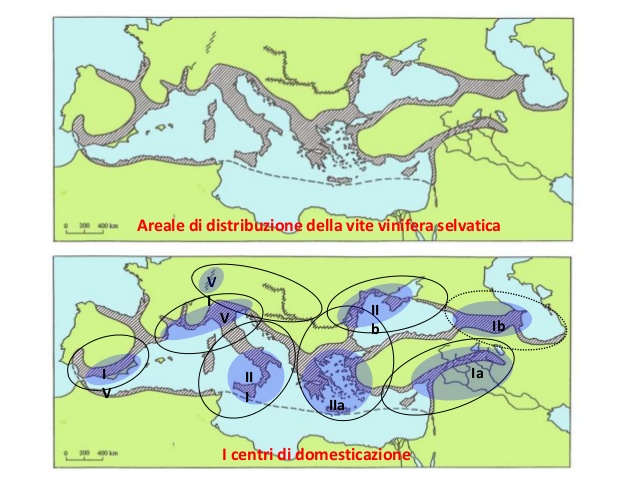
It is not easy to investigate these remote ages, when there are no documents, the remains of reference are highly perishable, moreover in a country like ours with so many historic layers. A classic example is represented by the "palmenti" (of which I have spoken here): they have been used for centuries, sometime for millennia, and this makes really difficult to find their time origin.
However, in recent decades, investigation techniques have been increasingly improved, integrating different disciplines, putting together the work of archaeologists, paleobotanists, molecular biologists and viticultural experts. They study the remains of ancient pollen, grape seeds, sediments on work tools and containers, the genetics of wild vines still present in the area and those close to archaeological sites, etc. In Tuscany, in particular, I remember in this regard the Vinum, Archeovino and Senarum Vinea projects, to which I refer mainly for this post. These and other studies are increasingly shedding light on our most ancient wine-growing history.
In many Italian areas there has been an independent birth of embryonic viticulture forms. However, for many of them the transition to fully-developed viticulture was strongly influenced by more advanced cultures (at that times).
Thus it was not for the Etruscans, the first winemakers in Italy who took the vine from the woods and cultivated it with the vine-growing system married to a tree. So, from the initial proto-viticulture, they developed a form of autonomous viticulture, which later became a key part of the Italian agricultural landscape for millennia, also considered a cultural frontier.
The contact with the Phoenicians and the Greeks will also enrich their viticulture and wine production, but they will always maintain a strong identity.
In Western Europe we can in fact trace the ancient cultural frontiers thanks to the type of historical viticulture of the territory. The Greeks have shaped viticulture in Southern Italy and Mediterranean France. The Etruscans have influenced that of Central and Northern Italy, including Rome and Northern Campania. The Romans, later, developed it in the territories of Central Europe, bringing the vine even to areas that had never seen it before.
Let us return, however, to the Etruscans and to the long and complex path of the birth of their viticulture. To simplify, scholars have divided it into phases. Some aspects are common to all the populations that have undertaken this process. Others are exclusive to the Etruscans.
The phase of pre-domestication.
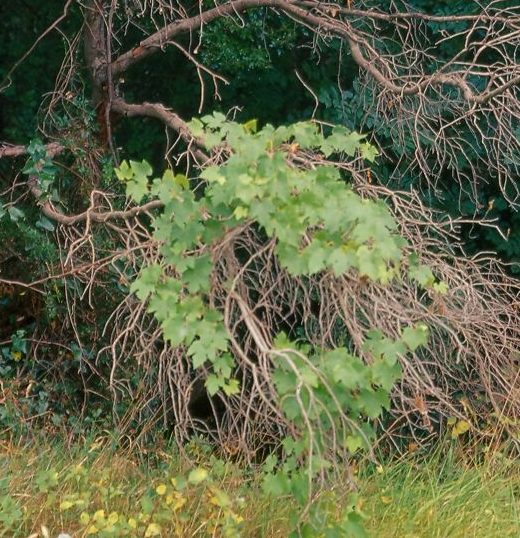
Our very distant ancestors, in Prehistoric times, gathered wild grapes (Vitis vinifera sylvestris L.) in the woods, taking what nature spontaneously gives. Grape seed remains have been found in anthropic contexts at least since the ancient Neolithic. Obviously, it is not excluded that it also happened in earlier times, we think at least from the Paleolithic.
In this period the man collects the grapes (on the right, wild grapes in Guado al Melo) but it does not seem there are traces of vinification.
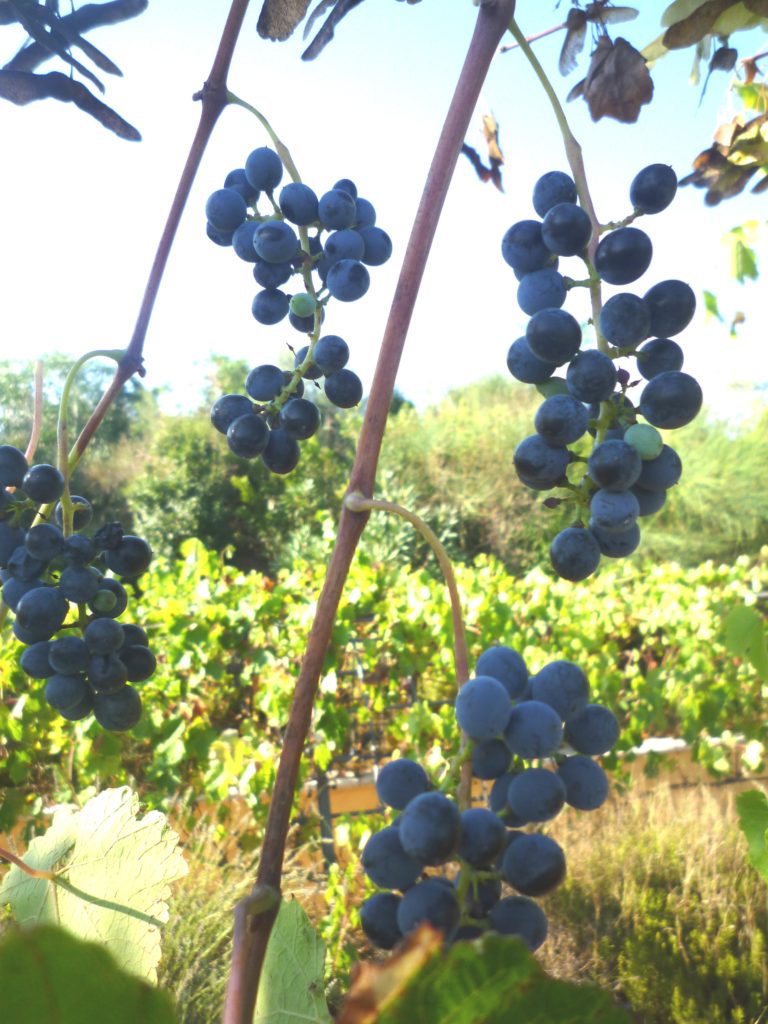
Do wild vines still exist today? In our woods it is still possible to find them (on the left, wild spontaneous vine in Guado al Melo), in fact the Vinum project worked on them. However, it is not very easy and increasingly risk disappearing. In fact, they grow mainly along streams, areas that have been constantly cleaned up for centuries by farmers to safeguard the territory. However, among the vines that can be found in a forest today, there are different situations: really wild vines, domesticated vines that came back to the wild (because there may have been an abandoned farm, etc.), spontaneous hybrids born between the wild vine and the domestic one. Are the current wild vines identical to those of the origins? It is not credible to think of it: in millennia of intense viticulture, it is very probable that the wild vines in the woods had genetic exchanges with domestic ones.
Tuscany and upper Lazio are the Italian regions that still have the largest number of wild vines, concentrated mainly in the Maremma woods overlooking the Tyrrhenian coast. Our territory, the Alta Maremma, represents its northernmost part (yellow arrow on the map below, from Attilio Scienza).
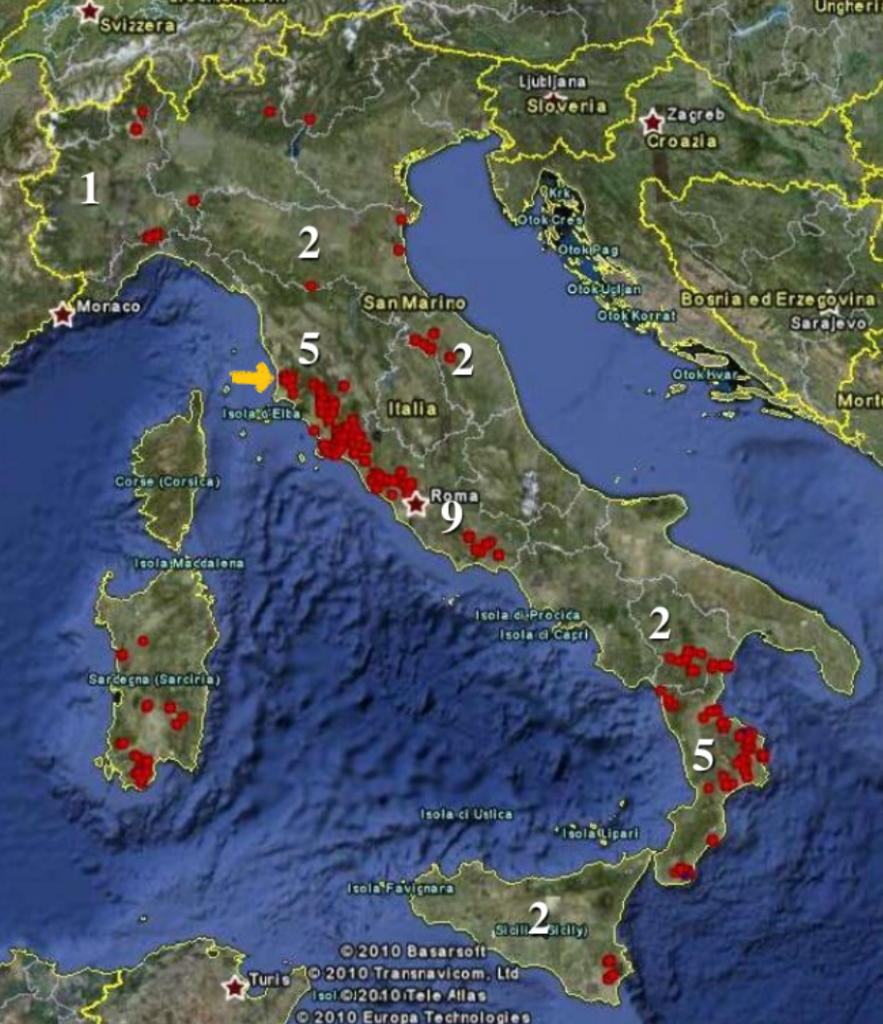

It is thought that the first form of viticulture in central Italy began towards the end of the second millennium BC, in the Bronze Age. We are at the beginning of that period that scholars have called the phase of the Lambruscaia.
This phase is a way of transition between spontaneous harvesting and an actual agricultural form, an embryonic viticulture that led to para-domestication. In this period the man from passive collector becomes active: he begins to take care of the wild vines in the woods, in the places where these grow spontaneously.
This viticulture resembles the one that Homer tells us about the Cyclops:
“Nothing is planted by their hands, not even plowed; everything grows for them without sowing or plowing: and wheat, and barley, and vines that produce wine from large bunches, and the rain of Zeus swells them "(Odyssey IX, 108-111).
The care and protection from predators makes the availability of the fruits more constant and perhaps even more abundant. A selection is not excluded in this phase, in the choice of treating the most productive vines or more pleasant in taste or the most resistant to pests.
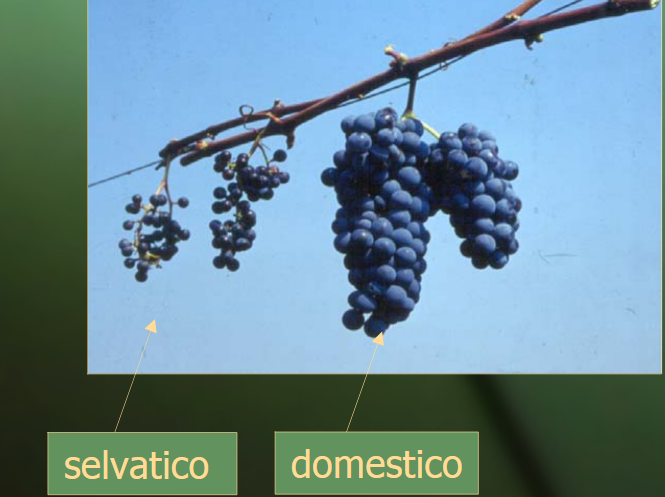
We do not know how the Etruscans called them or, better (for this period), the Villanovian peoples from which the Etruscan civilization will develope from the IX century B.C.
The term "lambruscaia" derives from the word "labrusca" which in Italy historically refers to the wild vine. Lambruscaia thus identifies the place with groups of wild vines in the woods. These plants tend to grow, in our Mediterranean forests, where there is more availability of water, for example near streams.
The word labrusca appears for the first time in a written document by Virgil (1st century BC). However, scholars think that it is much older, perhaps of Paleo-Ligurian derivation. Be careful not to confuse it with the species Vitis labrusca L., an American vine which came to Europe in the nineteenth century; here we always talk about Vitis viniferaL., the only European species, in its wild form, ie the sub-species sylvestris.
The word labrusca or its derived forms were still in use until not many years ago, to indicate the wild vine in the Center Italy: labrusca / lambrusca, abrusca, brusca, ciambrusca / cianfrusca, abrostola, abrostina, up to the most original raverusto and zampina. In Tuscany, in the past centuries, the terms averusco and abrostine were used to indicate the wine still made by wild grapes.
These words still echo in the names of several current varieties, even very different genetically. They share the fact that they remember their ancestral wild origin in the name. The most famous are the numerous Lambrusco, but there are also Abrostine, Abrusco, Abrostolo, Raverusto di Capua (another name of the Asprinio from Aversa), etc.
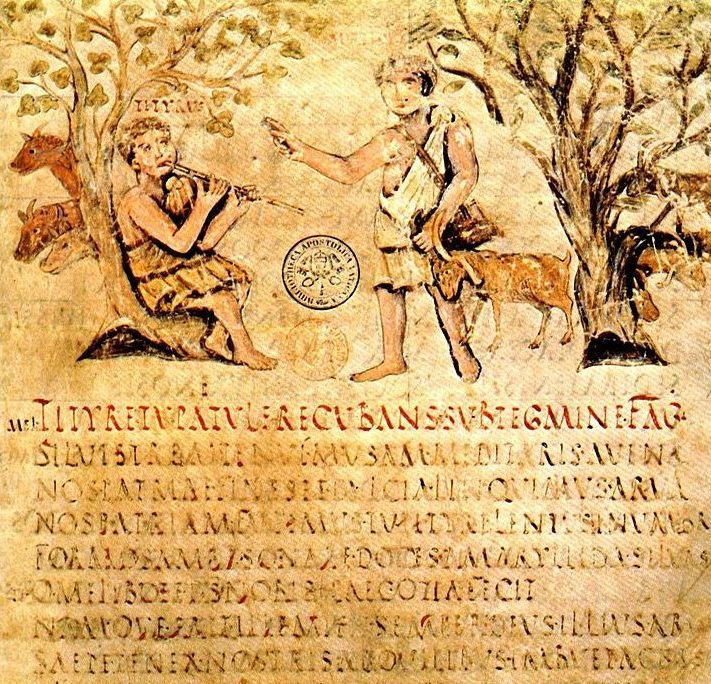
The cultivation of the lambruscaie in the woods is a primordial element characteristic of the Italian agricultural landscape, as also recalled by Emilio Sereni ("History of the Italian agricultural landscape", 1961), a reality in which the boundary between natural and agricultural environment is often very blurred. In fact, the lambruscaie will never completely disappear, even after these remote eras, despite the shift to more advanced forms of viticulture. Especially in the Maremma areas, the peasants used them again for centuries, until at least the 19th century (although in marginal form).
However, a systematic collection of grapes is documented in this period. But did they really make us wine?
It really seems so. In some archaeological sites of the early Bronze Age (Lake Massaciuccoli), medium (San Lorenzo a Greve) and final (Livorno-Stagno, Chiusi, Tarquinia) and others, large remains of grape seeds have been found, some with wild characters and others with elements of domestication. Thus, a significant amount of bunches of grapes had been harvested, brought into the town and not consumed immediately, but stored in structures used for food reserves. The oldest palmenti (rock vat for crushing the grapes) found so far seem to date back to the Bronze Age (I talked about the Etruscan and Roman production techniques here).

However, in this period, the wine produced is little, quite far from the taste we are used to today. Given the characteristics of wild grapes, it is very probably very light, sour and rich in tannin. It is accompanied by other fermented beverages, such as that obtained from cornel, sorb or other fruits. And yet it will be the drink obtained from the fermentation of the grapes to win over time, for an undoubted gustatory and conservative superiority, over all the others.
The primordial viticulture later went beyond lambruscaie, because of several productive improvements and also to the introduction of more advanced instruments, such as the long handle pennato (a local type of billhook).
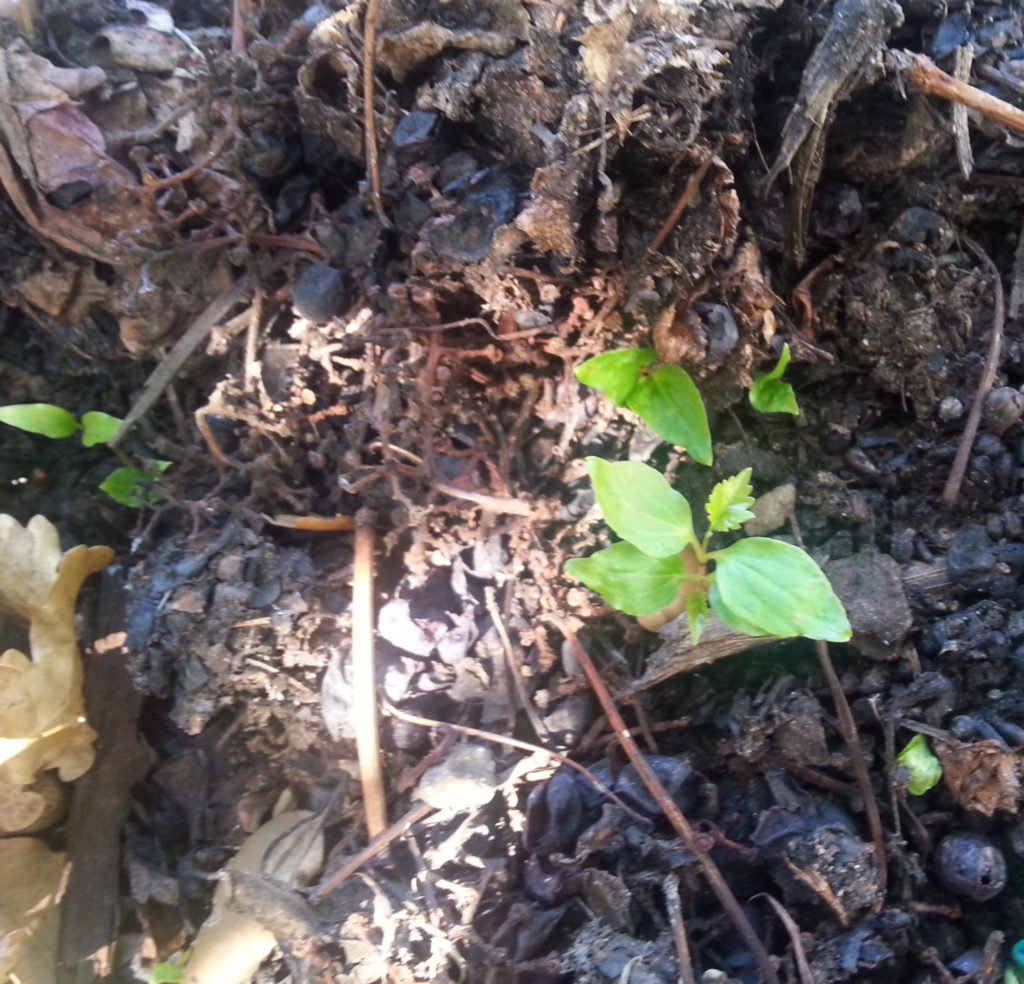
At one point the vine leaves the forest. It is not known whether this passage to a real cultivation was rational or was born from the observation of random facts. One of the most reliable hypotheses in this sense is the one called of "the garbage dump" or, more elegantly, of spontaneous vegetable gardens. According to this theory, man has started to see useful plants grow (in this case the vine) near his own settlement, in the places where he left his waste. In these places the ancient humans left food remains and even their own droppings. The seeds, thrown or present in the faeces, germinate and develop very easily in places so rich in organic material and moisture.
From the second half of the eighth century, in one way or another the wild vine came out of the wood, it was brought to its margins, near the human settlements. The structuring of a real viticulture begins, a new phase called Numana by the scholars.
In this phase the advanced Etruscan viticulture is born: the vine was cultivated always imitating nature, in the form of a vine married to the tree (of which we have already spoken here). The winegrower's work cycle becomes complete, including the vine planting and the renewal at the end of vineyard life. It is not by chance that the name of Numa Pompilius was chosen: it is the era of "normalization" of viticulture which, besides, from Etruria is transmitted to the nascent Roman civilization.
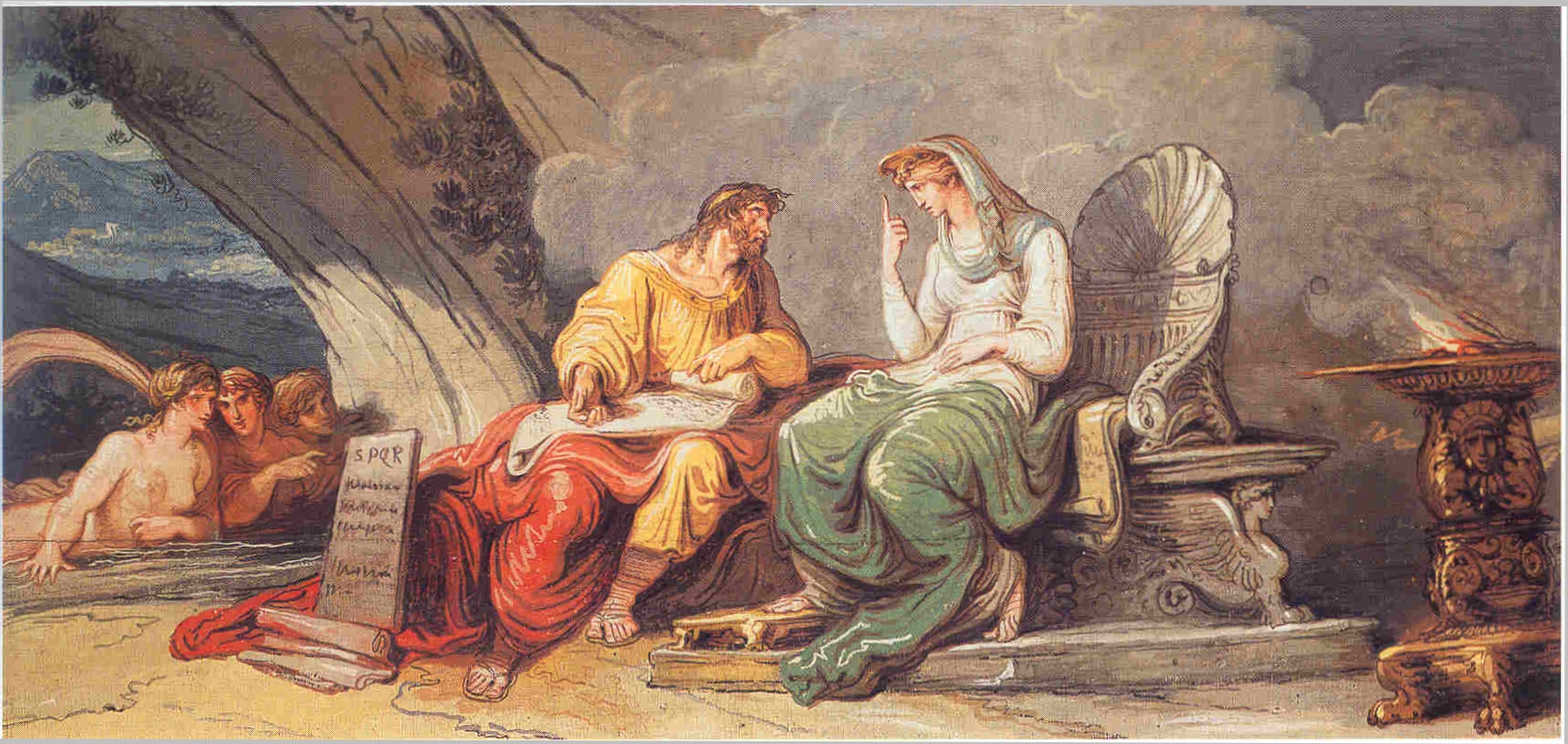
Cultivation inevitably led to increasingly intense selective pressure. The ancient winegrowers choose to plant and propagate the best vines, the hermaphrodite ones (I remember that the wild vine is instead predominantly dioic, with separate sexes), the most productive or the earliest one, those most resistant to weather or disease, etc. This is the proto-domestication.
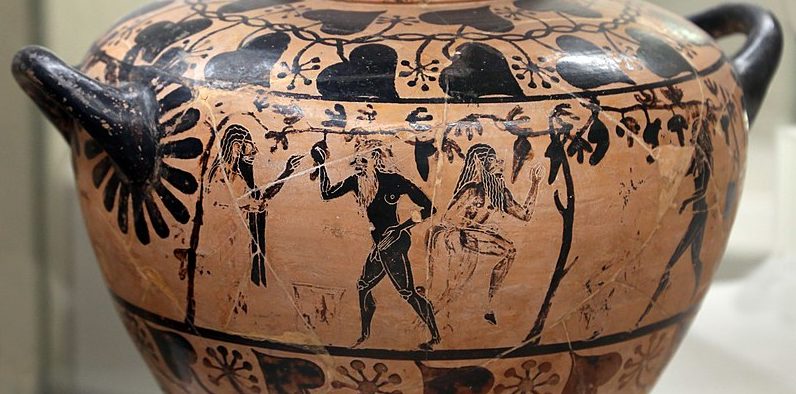
In this period also the first imported wines and the oriental vine varieties arrive, brought to Italy by the Greeks and by the Etruscans themselves. These were cultivated but also grafted and crossed (more or less voluntarily) with local varieties. The immense process of very intricate genetic plots, that generated many of the current varieties, began. This process represents the complete vine domestication (which is still ongoing since then).
It is probable that the passage from the ancient word temetum (which originally could also indicate different fermented beverages, not only that made with grapes) to that of vinum, of Greek derivation, dates back to this phase. The latter will become the most used in the Etruscan and Latin languages, till the modern European languages.
From the end of the 7th century BC, an agricultural period more similar to ours began, which was called the phase of the landscape organized in the countryside.
The gap between urban and rural life is increasingly accentuated. In the latter, more and more rural buildings were born, surrounded by cultivated lands, real farms dedicated to the production of wine, oil, cereals, etc. The married vines to the trees, placed at the margins of the plowed lands, are now subjected to pruning and ever more evolved care, as well as the production of wine is improving. The techniques and the work tools have become more and more refined, thanks also to the increasing cultural exchange with the Greek and Phoenician world.

The Etruscan society is now very evolved and the demand for wine is increasingly exigent. Local and imported wines are consumed. Wine of different quality is required, with a great circulation of varieties of different derivation. A more and more considerable production leads to overseas trade, mainly directed towards the Celts of southern France (see here).
The next phase was that called of Romanization
(more or less from the III century BC) The influence of other viticultural techniques coming from Rome may in part yet even have preceded the military conquest, which however will be completed by the first century BC. Alongside the traditional form of the married vine and the persistence of the lambruscaie, also the viticulture in rows begins, with parallel trenches (on the evolution of Roman viticulture we will speak again).
And yet it will not end here: all these forms of vine cultivation will continue to coexist for millennia, with Rome and for the following centuries (naturally with further evolutions), arriving however almost until our days.

from: A. Cianci et al. “Archeologia della vite e del vino in Etruria” Ed. Ci.Vin 2007
From slides and works by prof. Attilio Scienza
Jassarte: Gold Medal in Zurich
We are happy to comunicate that Jassarte 2015 has won the International Wine Award Expovina in Zuric, as best Italian wine.
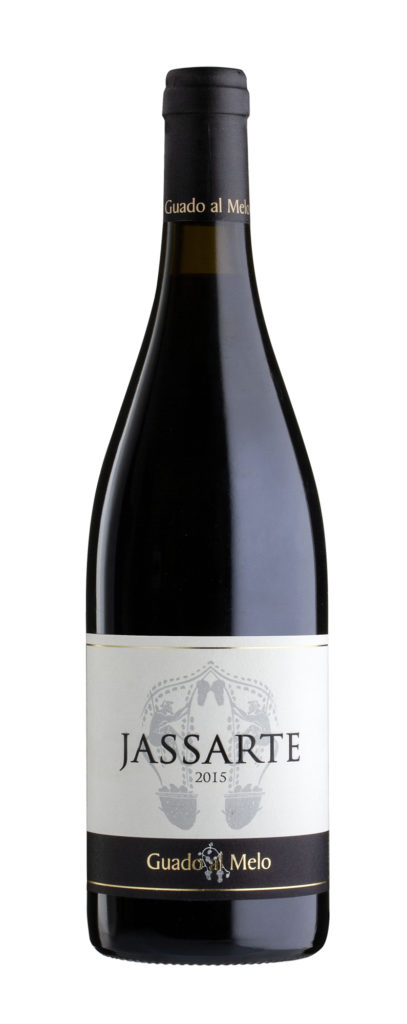
The Etruscans and wine (V): an intense wine trade to Europe
We all already know that the Etruscans were great navigators and traders but perhaps it is less known that they also traded their wine, a sort of primordial export from Tuscany.
The history of Etruscan trade began around the IX century BC, but it intensified especially from the 8th century onwards. It was interrupted only by the Roman conquest (II-I century BC). Located in a pivotal region for trade between the East and the West, the Etruscans were able to make the most of this favorable position. The Etruscan merchants became known throughout the Mediterranean and the Tyrrhenian Sea, controlled by the fleet, became almost an exclusive space. Brown arrows: trade routes and the widespread use of Etruscan products.
The wine trade was very intense between the seventh century and the first half of the fifth century B.C. Before these period, the wine-growing techniques were noticeably improved. The strong increase in production created a surplus, with respect to domestic consumption, pushing the Etruscan to wine commercialization.
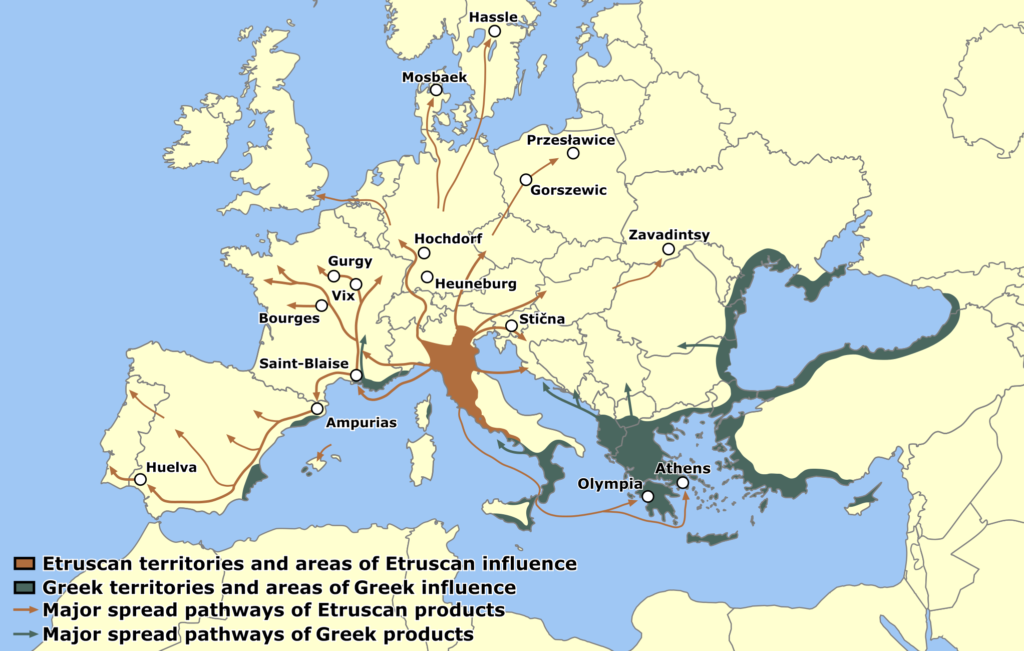
The wine trade was very intense between the seventh century and the first half of the fifth century B.C. Before these period, the wine-growing techniques were strongly improved. The increase in production created a surplus, with respect to domestic consumption, pushing the Etruscan to wine commercialization.
It was a vast trade, documented by the discovery of Etruscan wine amphorae in many regions: in Lazio, in Campania, in the Greek colonies of eastern Sicily, in Calabria, in Sardinia, in Corsica, in southern France and in the Iberian peninsula, both on the coasts Mediterranean and the southern Atlantic areas. There was also a minor trade by land, both internally and towards the territories of central Europe, where numerous objects of the Etruscan symposium have found.
The most important market were the Celto-Ligurian settlements of Southern France, such as Saint-Blaise in Provence, Lattes and La Monedière in Languedoc, penetrating for some tens of kilometers inland along the waterways. Large quantities of bucchero vases and Etruscan wine amphorae were found in the archaeological remains of more than 70 sites in the region.
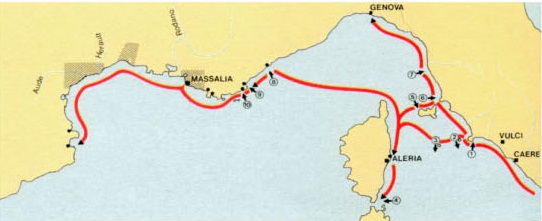
We can also follow the routes of these trips thanks to the remains of shipwrecks found in Cap d’Antibes, Bon Porté, Point du Dattier and other places. From Etruria, the merchants followed the islands of the Tuscan archipelago and passed near Corsica. On the seabed, Etruscan ships have been found with entire loads of wine amphorae and fine tableware.
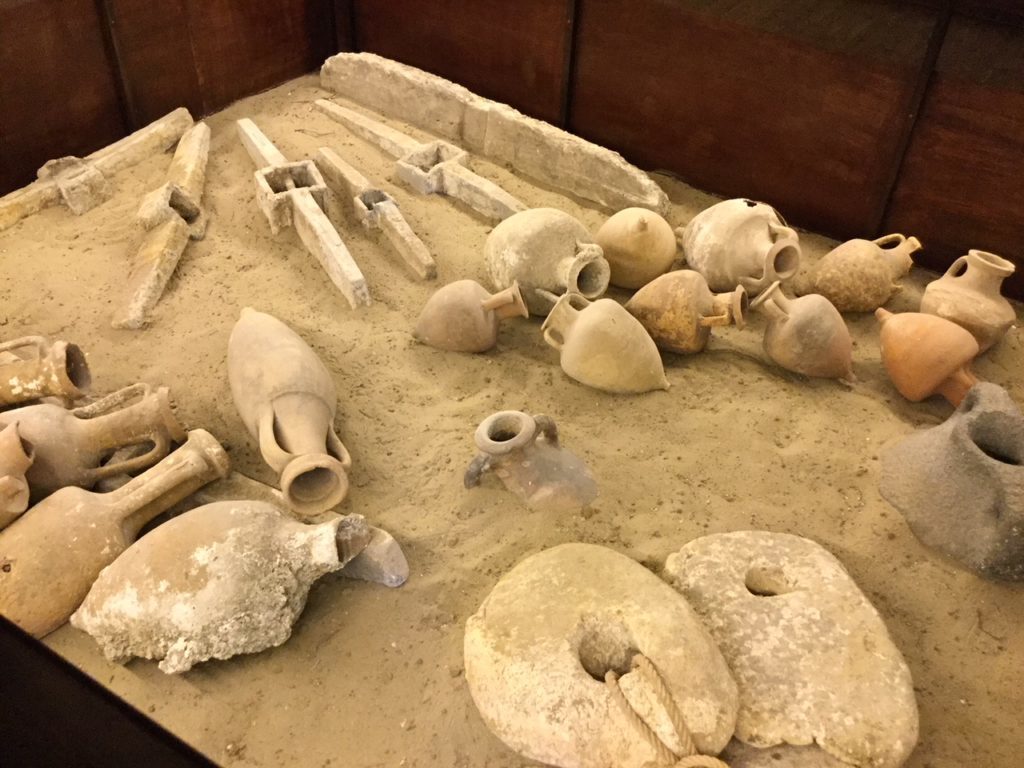

At that time in the south of France wine was not yet known and, in return, the Etruscans procured various commodities, probably skins, cattle, slaves, especially tin that, along the Rhone route, came from Cornwall (I remember that tin was fundamental for the production of bronze, in alloy with copper).
This trade in wine came less from the 6th century BC because of the colonization of the Focei (from Focea, the Greek city of Ionia, in present-day Turkey). These gradually supplanted the Etruscans, imposing a real territorial domain, especially towards the end of the century.
From that moment on, the markets of Southern France began to supply from the wine production of Marseilles (Massalia), which had been founded by the Focei around 600 BC. The Etruscan wine trade diminished significantly and focused mainly on crafts and luxury goods.

The wine was transported in terracotta amphorae,
also used for preservation, ancestors of the most famous Roman amphorae. The Etruscan amphora appears to have originated from Phoenician models and appeared with the beginning of the commercialization of the product. At the beginning they had red paint inscriptions, as if to evoke the practice of giving. However then they become standardized, they become all identical, without decoration, a real mass production. Inside they were coated with resin and closed with cork stoppers sealed with pitch. The shape was different depending on the place of production and evolved over time towards increasingly elongated shapes, to facilitate storage in ships.

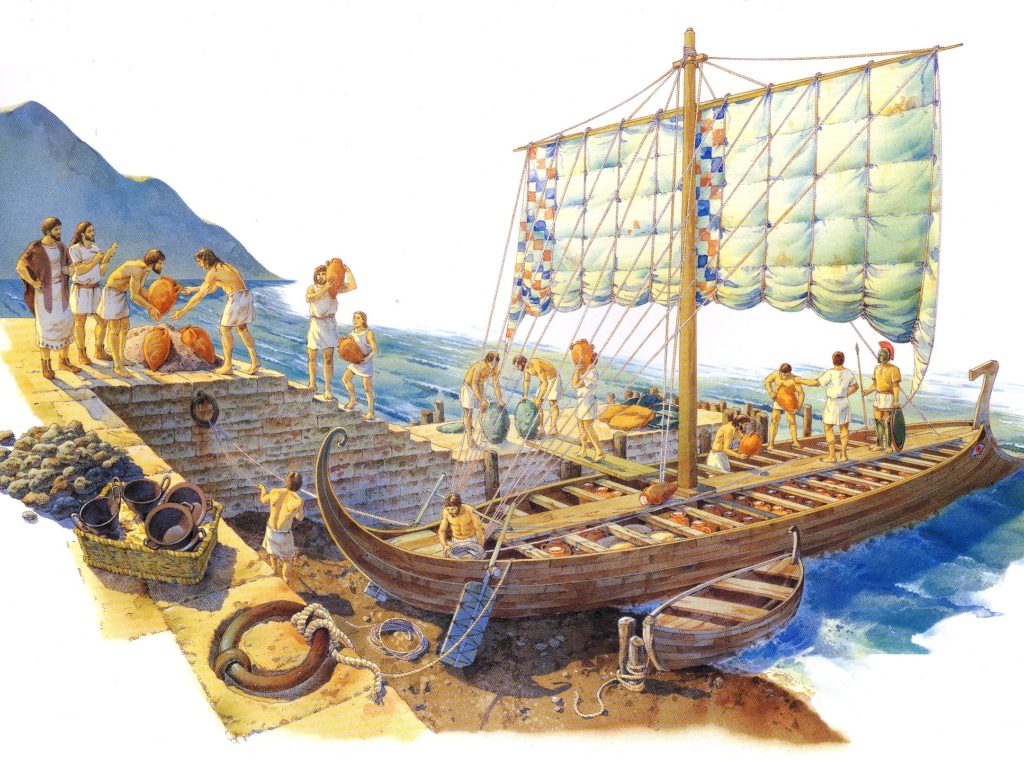
In the holds, the amphorae were stacked in parallel rows, one above the other, taking advantage of the spaces between the handles of the row below to insert the tip of the one above. The loads were balanced so as to avoid the imbalance of the boat. The interstices between the amphorae were filled with juniper or heather twigs, rushes or fagots, to avoid breakage and movement during transport.
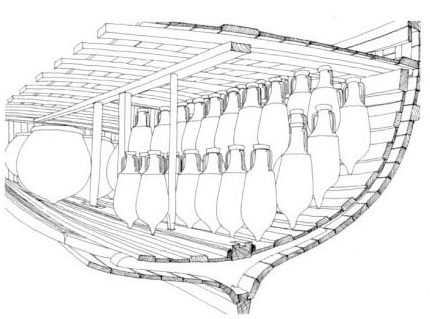
The Etruscans kidnap Dionysus
From the 6th century B.C. the Etruscan merchant appeared depicted in Greek literature as a pirate, while the Phoenician one had the role of the cunning merchant. The Greek one, of course, progressively triumphs over obstacles, imposing himself on others. This iconography, obviously very biased, had a historical background however: the commercial trips of the time were not entirely unrelated to episodes of raids. However, it is thought that, rather than pirate acts, it was a sort of corsair war.
The figure of the Etruscan-merchant, but above all of the Etruscan-corsair, caused the spread of a myth that tells of the kidnapping of Dionysus by the Etruscan, represented on Greek vessels starting from the VI century BC. This myth appears for the first time in the Hymn 7 attributed to Homer, probably reporting archaic oral narratives.
The myth tells that the Etruscans found a beautiful sleeping boy on an island, with black curls and a rich purple coat.
... Presently there came swiftly over the sparkling sea Tyrsenian pirates on a well-decked ship —a miserable doom led them on. ...
Thinking he was the son of a king, they took him to ask for his ransom. Dionysus, awakened tied up on the ship, turned into a bear and then into a lion, while vine shoots wrapped around the main mast. The pirates, terrified, threw themselves into the sea and were transformed into dolphins. The God spared only the helmsman, who had opposed from the beginning the attempt to tie him, since he had guessed the divine nature of the young men.
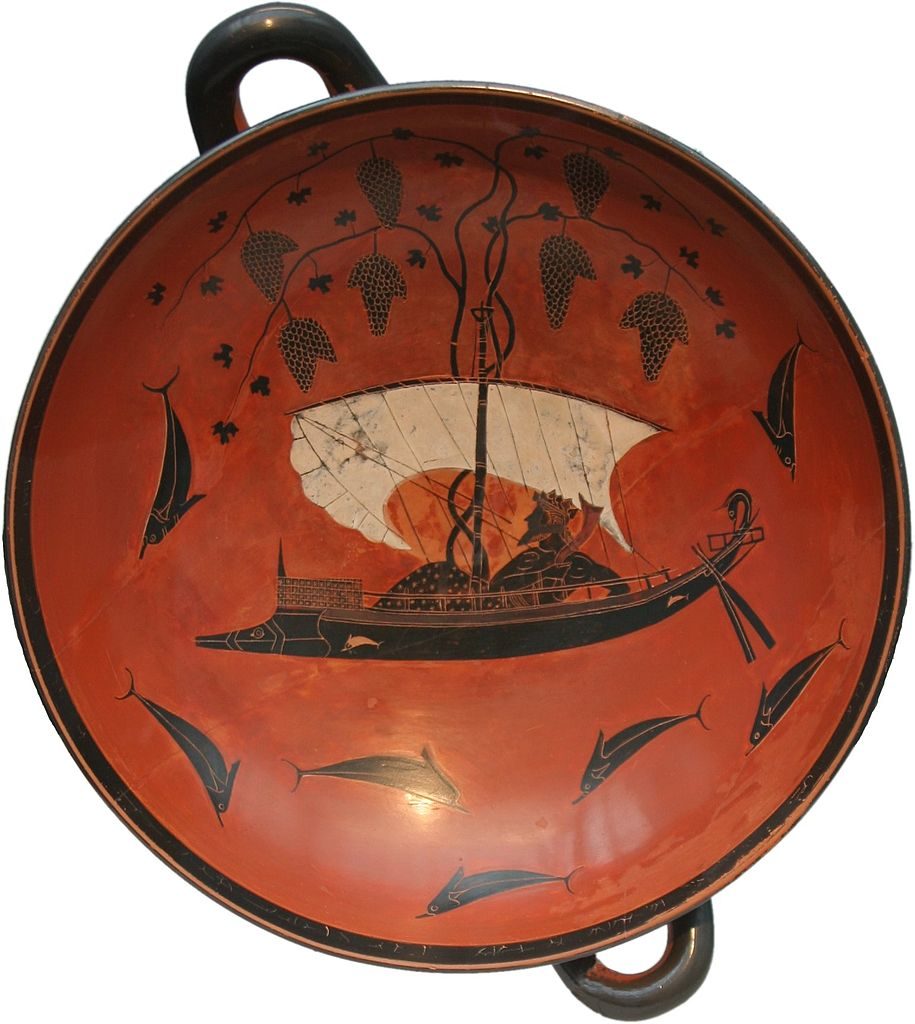
It seems that the Etruscans appreciated this myth, in fact they themselves represented it, as in the hydria (water amphora) of Toledo.
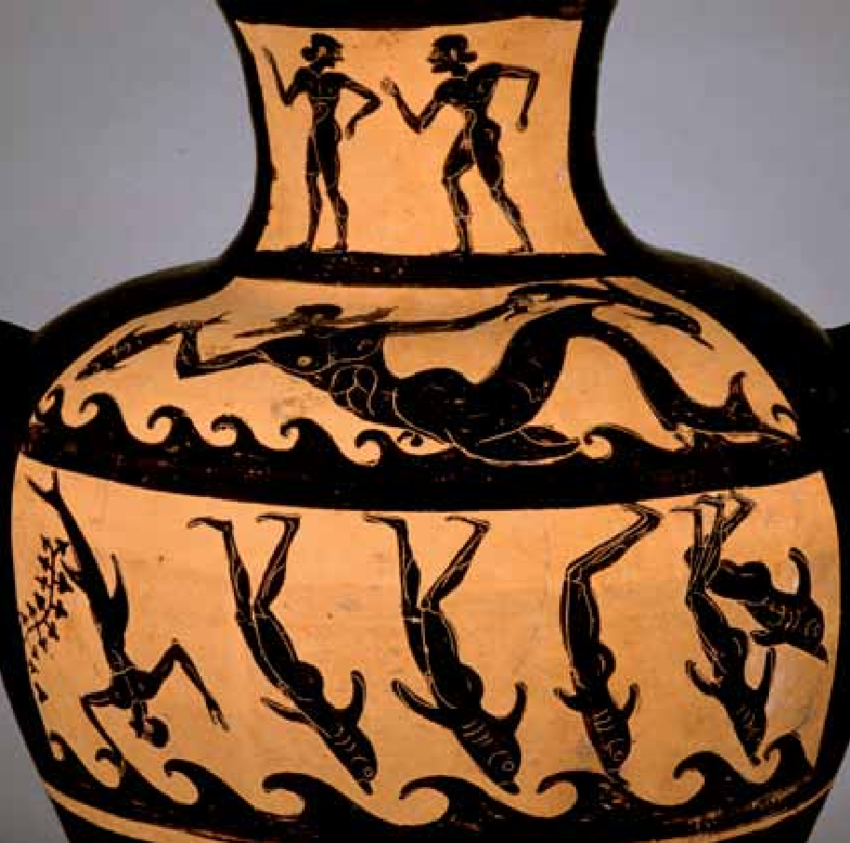
Apart from Homer, this myth is rarely remembered in Greek literature, except in later periods, where it appears with different additions or variations. In the Hellenistic period Pindar claims that the abduction was "commissioned" by Hera, with Silenus and the Satyrs leaving for his research. It is even more frequent in the Greek literature of the Roman period, with Apollodorus, Nonnus of Panopolis and other authors.
In Rome the myth is mentioned by Ovid in the Metamorphoses, according to which the kidnapping would have taken place on the island of Chios. When the young man wakes up, he asks to be taken to Naxos. The pirates pretent only to go along his request and, when Dionysus realizes it, the prodigies begin. The ivy and the vine wrap around the mast of the ship, different fairs appear. The pirates who throw themselves into the sea are described at different stages of the metamorphosis into dolphins. Then they emerge and weave a dance around the ship. The saved helmsman comes to Delos and becomes a follower of the worship of God.
In the Oedipus by Seneca the prodigies are still different: the sea becomes a meadow, with also trees and birds. Hyginus tells that the companions of Dionysus (who was not alone, in this case) begin to sing a wonderful song that fascinates the pirates, who begin to dance and fall into the sea cause of the enthusiasm. Lucian recalls this story, saying that Dionysus uses the dance to subdue the Tyrrhenians, emphasizing its importance in the worship of God.

Scholars consider that originally the myth was linked to the initiation rites to the Dionysiac mysteries , as a teaching or as a demonstration of punishment for those who do not want to recognize the God. Then it became a sort of Greek propaganda against Etruscan acts of piracy. In Hellenistic and Roman times, however, it also took on an eschatological connotation, related to the cult of Dionysus, God of transformation and renewal, which leads to salvation.
The relationship between Dionysus (wine) and the sea are elements and metaphors of the passage between life and death, however very present in Greek culture and then also in the Etruscan one. The journey by sea metaphorically represented the journey to the afterlife. The Etruscans believed that it precisely the dolphins accompanied the dead to the Isle of the Blessed. The figure of the dolphin is in fact proposed in Etruscan art with symbolic-ritual significance linked to death, as in several tombs, but also a good omen. these aquatic animals were surely very familiar to this people of navigators.
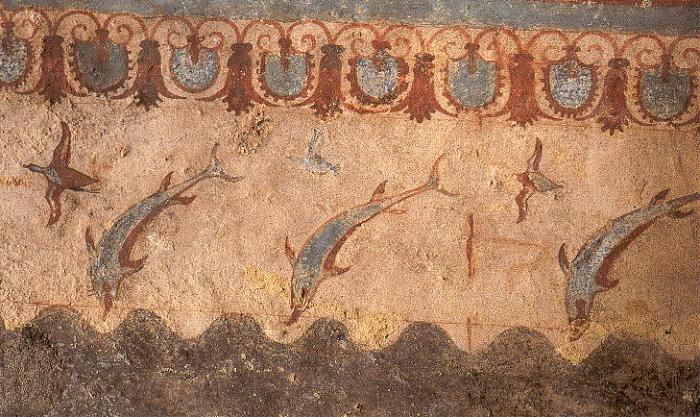
This bond will remain even in Roman art , with the representation of this myth in funerary monuments. However, it was also rapresented in mosaics of private houes.
I like to think of this myth in a different way too. The Etruscans kidnap the God of wine, Dionysus, or rather the very soul of wine, and take it to the West, in Italy, which will increasingly become the land of wine par excellence.
Hymn 7 - To Dionysus (by Homer)
I will tell of Dionysus, the son of glorious Semele, how he appeared on a jutting headland by the shore of the fruitless sea, seeming like a stripling in the first flush of manhood: his rich, dark hair was waving about him, and on his strong shoulders he wore a purple robe. Presently there came swiftly over the sparkling sea Tyrsenian pirates on a well-decked ship —a miserable doom led them on. When they saw him they made signs to one another and sprang out quickly, and seizing him straightway put him on board their ship exultingly; for they thought him the son of heaven-nurtured kings. They sought to bind him with rude bonds, but the bonds would not hold him, and the withes fell far away from his hands and feet: and he sat with a smile in his dark eyes. Then the helmsman understood all and cried out at once to his fellows and said:
“Madmen! what god is this whom you have taken and bind, strong that he is? Not even the well-built ship can carry him. Surely this is either Zeus or Apollo who has the silver bow, or Poseidon, for he looks not like mortal men but like the gods who dwell on Olympus. Come, then, let us set him free upon the dark shore at once: do not lay hands on him, lest he grow angry and stir up dangerous winds and heavy squalls.”
So said he: but the master chid him with taunting words: “Madman, mark the wind and help hoist sail on the ship: catch all the sheets. As for this fellow we men will see to him: I reckon he is bound for Egypt or for Cyprus or to the Hyperboreans or further still. But in the end he will speak out and tell us his friends and all his wealth and his brothers, now that providence has thrown him in our way.”
When he had said this, he had mast and sail hoisted on the ship, and the wind filled the sail and the crew hauled taut the sheets on either side. But soon strange things were seen among them. First of all sweet, fragrant wine ran streaming throughout all the black ship and a heavenly smell arose, so that all the seamen were seized with amazement when they saw it. And all at once a vine spread out both ways along the top of the sail with many clusters hanging down from it, and a dark ivy-plant twined about the mast, blossoming with flowers, and with rich berries growing on it; and all the thole-pins were covered with garlands. When the pirates saw all this, then at last they bade the helmsman to put the ship to land. But the god changed into a dreadful lion there on the ship, in the bows, and roared loudly: amidships also he showed his wonders and created a shaggy bear which stood up ravening, while on the forepeak was the lion glaring fiercely with scowling brows. And so the sailors fled into the stern and crowded bemused about the right-minded helmsman, until suddenly the lion sprang upon the master and seized him; and when the sailors saw it they leapt out overboard one and all into the bright sea, escaping from a miserable fate, and were changed into dolphins. But on the helmsman Dionysus had mercy and held him back and made him altogether happy, saying to him: “Take courage, good...; you have found favour with my heart. I am loud-crying Dionysus whom Cadmus' daughter Semele bare of union with Zeus.” Hail, child of fair-faced Semele! He who forgets you can in no wise order sweet song.
Il mito di Dioniso e i Pirati Tirreni in epoca romana, Lucia Romizzi Latomus T. 62, Fasc. 2 (AVRIL-JUIN 2003), pp. 352-361 (12 pages) Published by: Société d'Études Latines de Bruxelles
Cristofani, Etruschi, ed. Giunti.
Gli etruschi, abili commercianti e navigatori. Gli scambi, i prodotti che compravano e vendevano, gli empori di Finestre sull'Arte, scritto il 24/06/2018
But when is the harvest?
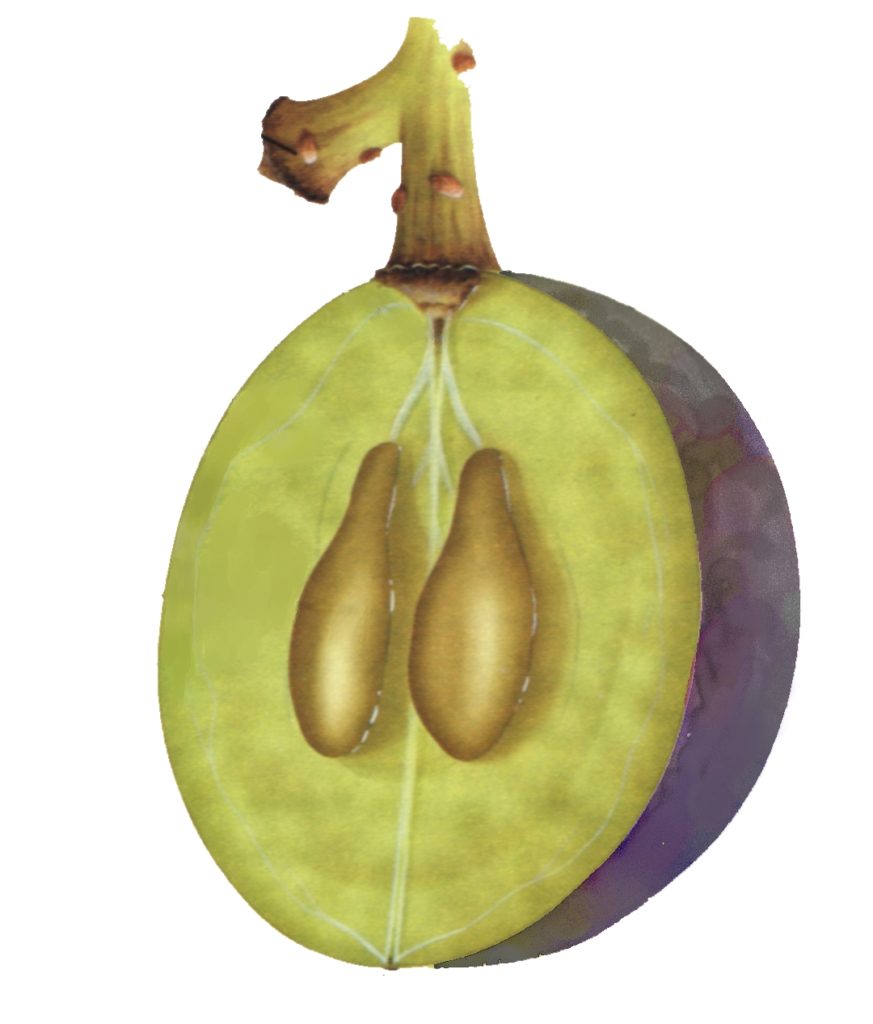
Now the grapes are finishing to change color (veraison). From the complete change, they will still go from 3 to 5 weeks to perfect maturity. Every variety has its moment, some are more precocious and others are ripen later.
But when is the harvest?
It is common to answer: when the grapes are ripe. But how do we understand it ?! ??
It is certainly not enough to taste the grape as we could do just to eat it: for this reason it is enough that it is sweet enough to satisfy our palate. To make any wine, it could be enough. Not to make great wines!
The winemakers try hard to capture that perfect moment.

In reality, in the past, not everyone did it: up until about thirty years ago and going back in time, the high-quality production was not such a widespread priority. The harvested was done when the grapes were ripe more or less, often when there was time to do it (in many small and medium-sized farms young people generally did other jobs, to round off the poor income of agricultural activity).
However, let us be interested in those seeking quality and try to ask some expert.
 Columella (I c. AC) would tell us:
Columella (I c. AC) would tell us:
“… but the signs of the maturity of the grapes vary according to the authors.
Some have believed that the time for harvesting has come when they sees a part of the bunches becoming soft; others, on the other hand, when they see colored and shiny grapes, others when they see the vine leaves fall.
But all these signs are fallacious: they are all phenomena that can occur when the bunches are still immature, due to the bad weather due to the excessive sun or the year.
Then others tried to test the maturity from the taste of grapes, estimating it according to whether the grape had a sweet or sour taste. Even this sign, however, presents some uncertainty, because some qualities of grapes never become sweet due to their excessive acidity.
The best thing, as I myself use to do, is to observe the natural maturation by itself. On the other hand, natural maturity occurs if, having pressed out the pips, which are hidden in the grape, they are dark in color or some very black. In fact, nothing can give color to grape seeds unless the natural maturity ... " (De Re Rustica ”, 4 - 70 ca. AC)
Let's try to ask Dr. Pietro de' Crescenzi, from Bologna, who tells us about it in his work “Ruralium Commodorum libri XII” (1304), reporting different opinions:
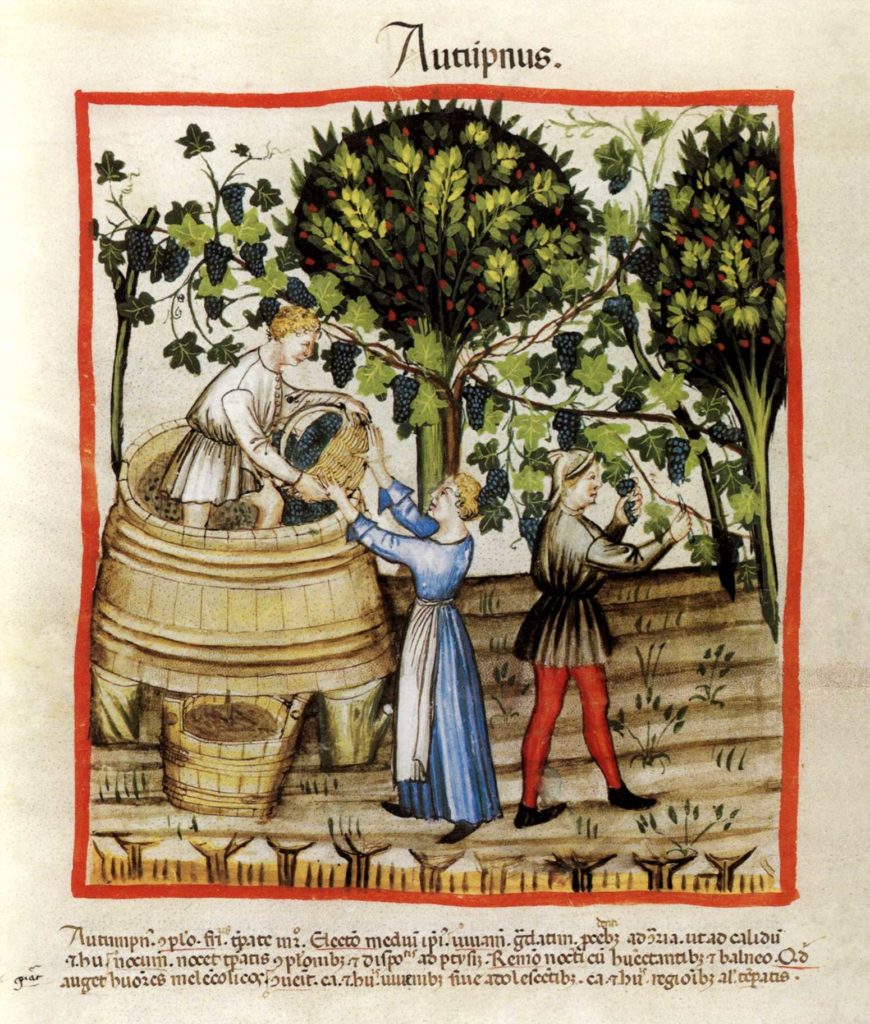
- “Collecting the grapes too soon causes the wine to be thin, infirm and does not last. Others harvest too late and the vines have lost their strength. The harvest moment is recognized by tasting and the eye.
- Avicenna, Democritus and the African say that the grapes must be ripe six days and no more. And if the grape berry is no longer green but black or other color as it should be, according to the variety of that grape, then it means that it is ripe.
- Some others conjecture that the grape is ripe when it begins to wither.
- Others make such a test. They take out a berry from a bunch, which is beautiful and thick, and after one or two days, they will consider whether the place where there was the berry is the same as before, and if the other berries around it have not grown, they prepare to do the harvest. But if the place where the berry was will be made smaller by the growth of the others around, they wait to harvest until the grapes grow.
- We must then make the harvest, and most of all when the moon is in Cancer, or in Leo or in Libra or in Scorpio or in Capricorn or Aquarius. But once the moon is over and being buried (new moon), one must make the harvest hurriedly, as Borgondio says in the book which he translated from the Greek into Latin. …
- Too ripe grapes make the wine sweet but less powerful and less durable than those harvested before. The unripe grapes make the wine unripe. But the well ripen grapes make the wine powerful and that lasts longer.
- The grapes harvested in a crescent moon make the wine less durable, in the waning moon more. ... "
Pietro collected the knowledge of the ancients and that of his time. More or less, it will remain almost unchanged for centuries (including the history of the moon, which we brought from the Middle Ages to the present day ...).
The understanding of the chemical phenomenon of fermentation (from the late eighteenth century onwards) led then to increasingly understand the optimal harvest time.

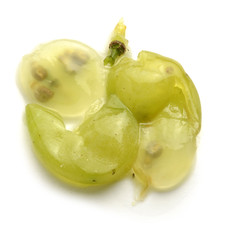
Our old experts were right on several points . In fact, some of these are the result of accurate observations of the changes in the maturation period. However, even if true, they allow only a rough evaluation of the maturation (see below). They alone are not sufficient for the fineness we want to achieve today in artisanal wine. Surely, they were sufficient for past ages, even if this knowledge was not for everyone, given the widespread ignorance in the peasant world.


Today we all know by now that the best moment of the harvest is chosen, for each variety and for each particle of vineyard, from the comparison of different grape elements:
- sugar content,
- acidity,
- pH,
- phenols (tannins and anthocyanins) for the dark grapes
- the tasting of the grapes. Only by this way the expert winegrower, in our case Michele, knows how to evaluate elements of greater fineness otherwise undetectable, such as the maturation of the tannins of the grape seeds, the aromatic evolution of the fruit, the consistency of the peel ...
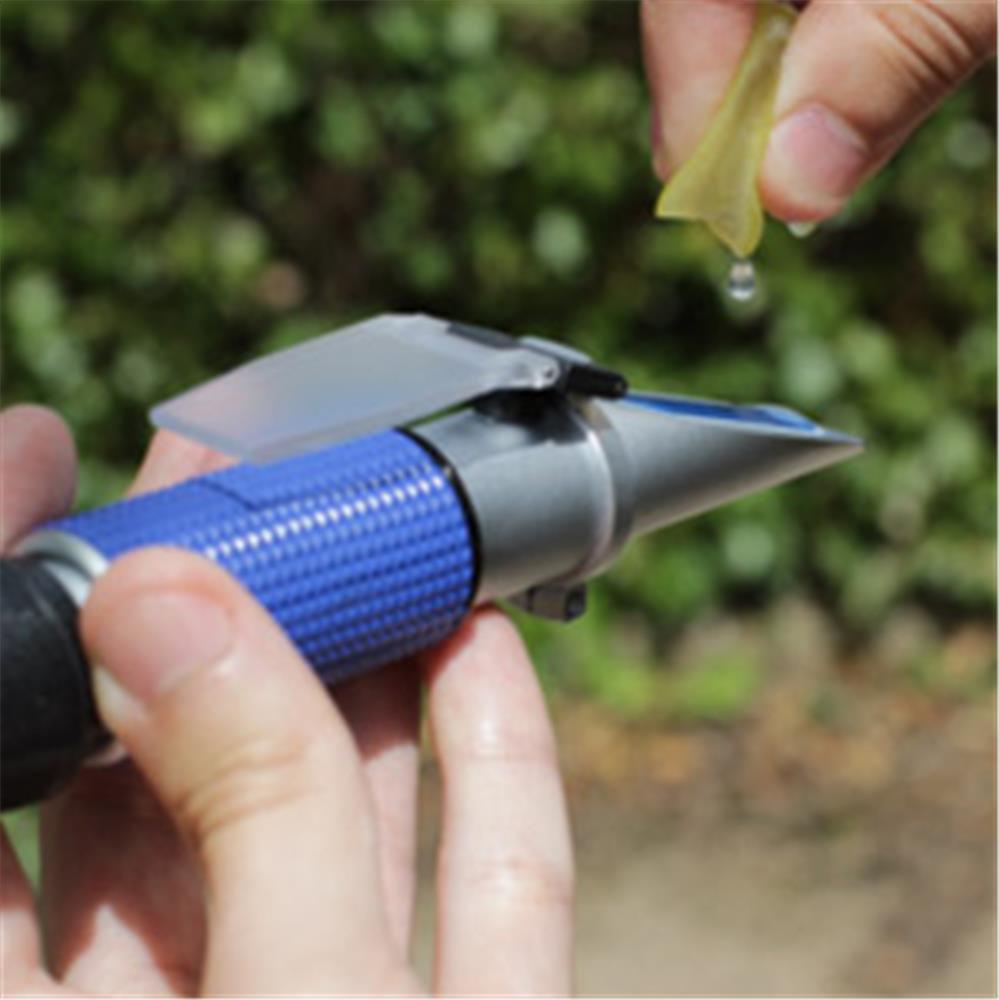 However, all these elements do not coincide temporally with each other for the optimal moment. Only the winegrower, again, with great experience and knowledge (and a bit of personal flair), is able to reach the goal to identify the best balance.
However, all these elements do not coincide temporally with each other for the optimal moment. Only the winegrower, again, with great experience and knowledge (and a bit of personal flair), is able to reach the goal to identify the best balance.
This balance is different for each wine that will be born, depending on the type (white, red, still, sparkling, young, medium or long aging, raisin, ...), the territory, the varieties, the vintage in general and the seasonal trend during the harvest period (if particularly bad, it could oblige to force harvest times). You can also make mistakes, however little if you are experienced enough.
 The truly perfect moment, however, remains ineffable, a myth perhaps, an infinite to tend towards, but you will never know for sure if you have really achieved it. The great wines are born from this endless research.
The truly perfect moment, however, remains ineffable, a myth perhaps, an infinite to tend towards, but you will never know for sure if you have really achieved it. The great wines are born from this endless research.
"Never be satisfied, this is the art" (Jules Renard)
Returning to the ancients, how right were they?
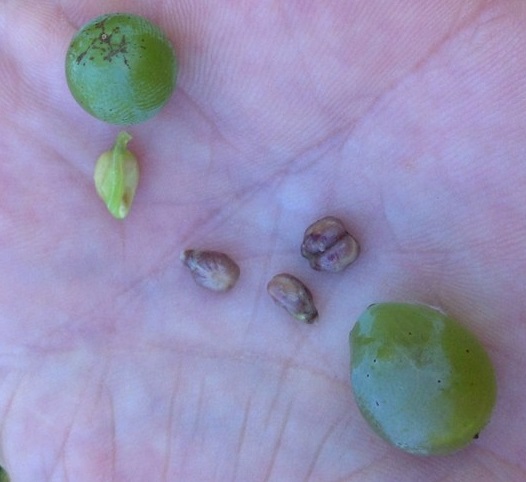
Columella, the first true agronomist in history, does not disappoint us: he discards any too variable and not objective parameter. He recognizes that always the color of the seeds changes with maturity. This was one of the parameters most used by the experts over the centuries (before our analyzes that give us more accurate answers). The most important color leap of grape seeds is during the veraison, when from green they become yellowish / brownish. Then they darken more and more. However, to evaluate the different shades of brown becomes very difficult.
(picture on the left from da www.wining.it)

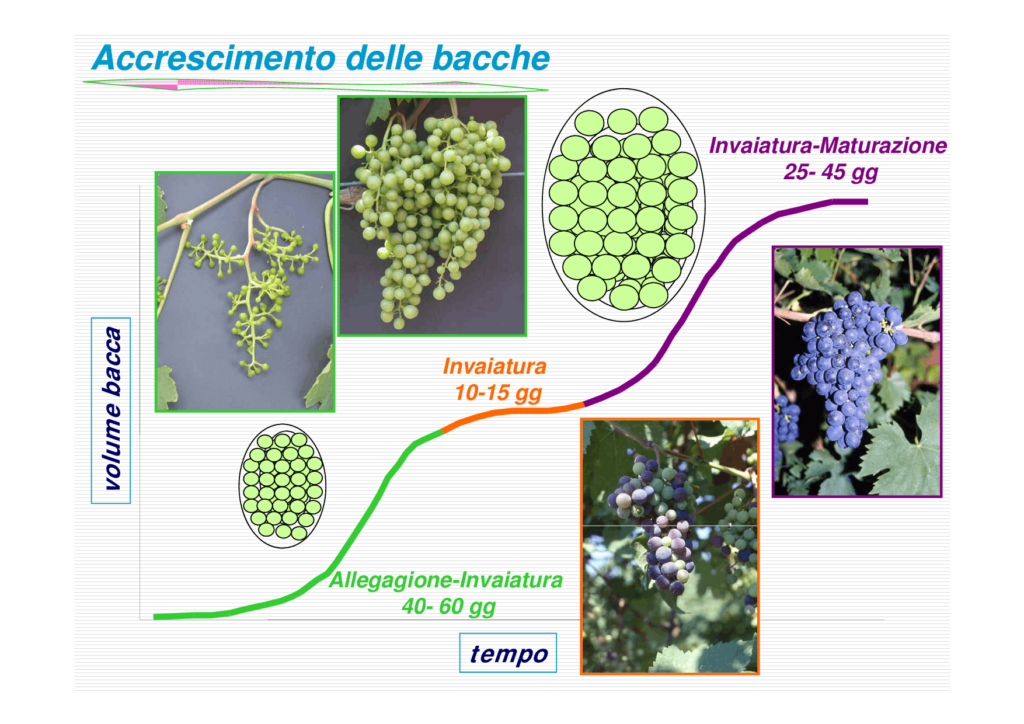 About Pietro de’ Crescenzi:
About Pietro de’ Crescenzi:
- OK
- When the grapes have changed color they are not ripe, they need at least 3-5 weeks before to be really ready (six days are really too few).
- True. This is also an objective parameter of grape maturity. The pulp, during the maturation, becomes more and more soft and it does not remain adherent to the seeds (or other parts) as when it is unripe. As mentioned above, however, this element alone is considered insufficient today.
- No, it may already be too late, unless you want to make raisin wines or late-harvest wine.
- This is also a good system. The grape increases its size during maturation and stops in the final phase.
- Pietro mentions Palladius (Rutilius Taurus Aemilianus Palladius, 4th century AD, author of the work Opus agriculturae or De re rustica; he was the last agrarian author of the classical era). He in turn quotes Columella (see above). At the time of Pietro de' Crescenzi, Columella was known only through the quotations of other authors. His original work was rediscovered only in 1417 by the Florentine humanist Giovanni Francesco Poggio Bracciolini. He had found a manuscript of it, forgotten, in a German monastery.
- At that time, the moments of the year were indicated with astronomical observations, degenerated (sometimes) in fanciful astrological descriptions. Here Pietro seems to refer more to a period of the year. …
- It is right: grape must be neither unripe nor overripe (when it is sweeter but loses its acidity, so the wine will be less durable).
- Like the stars, the moon also illuminates our nights and makes us dream ... nothing more.
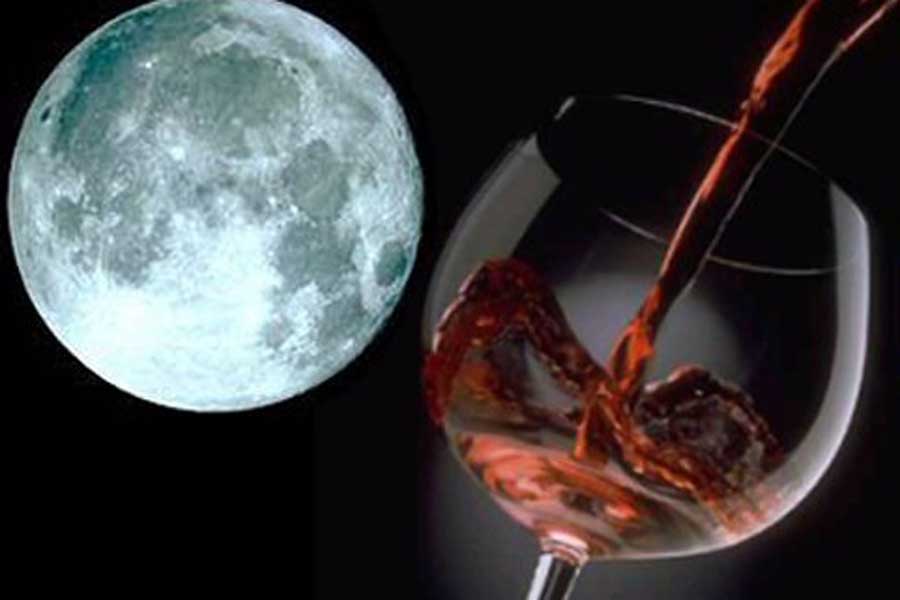
Food & Travel Italy 2019 Awards
We are pleased to announce that Attilio Scienza has obtained the recognition awards 2019 of Food & Travel Italy for research and innovation. These are awards to Italian and international excellences that will be characterised by their quality and services. The prizes will be officially delivered on October 4th at Forte Village Resort in Sardinia.
Criseo 2017 - it is ready!
Our wine Criseo Bolgheri DOC Bianco 2017 is ready.

The vintage 2017 has been very dry, with big drops in production. The wines are well concentrated but very balanced. A lot of work has been done in selection to eliminate withered berries. In fact, the Criseo has a great freshness that perfectly balances the full and enveloping body, almost "fat", and very long. The color is light golden. The set of aromas is incredible: it changes over and over again. We left the glasses to the side, returning to smell them from time to time and ... each time different scents came. We have smelled aromas of tropical fruit (especially pineapple), apricot, candied fruit, orange jam, honey, yeast, saffron, broom, chamomile, mineral notes (flint and kerosene), cedar, lemon leaves ...
We are talking about a craft wine, that it was born from a single vineyard (Campo Bianco 0,7 ectares, naear to the ford, the "guado"), a field blend of different varieties: mostly Vermentino, and Verdicchio, Fiano, Petit manseng, Manzoni bianco. They are picked up all togheter, co-fermented and then aged on the lees for 1 year (not wood, in a steel tank), and 1 year again in bottle.
Behind all this is the work of Michele Scienza, a winemaker who fully gathers the legacy of his family.
Taste and enjoy it !
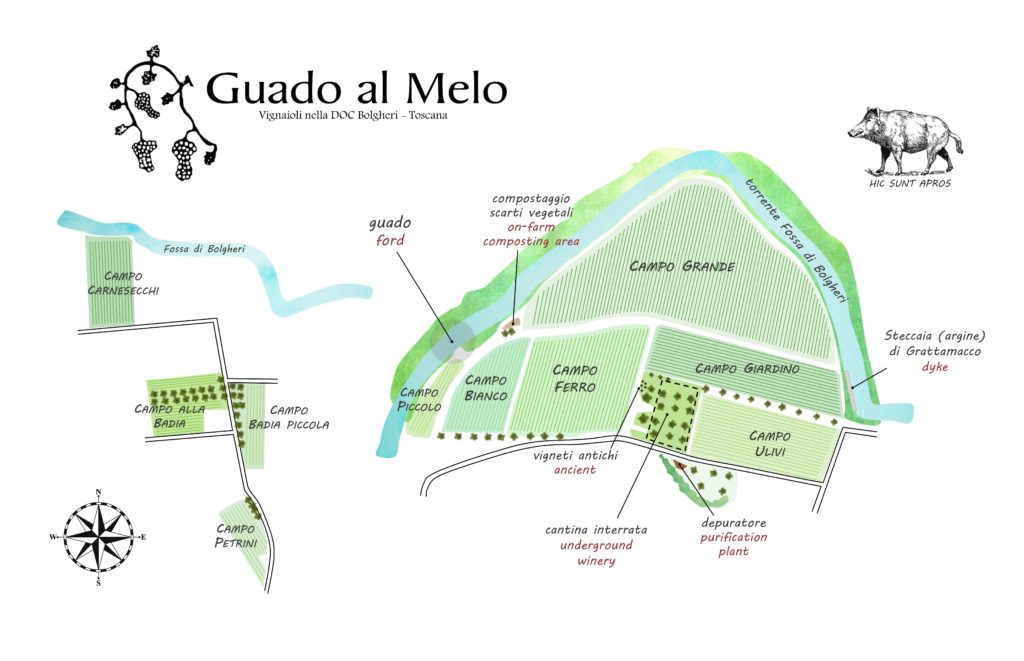
Happy Easter: we are open
We are open on Saturday, Monday and on April 25 (they are Italian public holidays), h 10-13 15-18.
We are waiting for you!
Guado al Melo is "Quality Made"
Quality Made is a high quality Cultural Identity brand that certifies companies whose activities are based on principles of cultural, environmental and social sustainability.
Quality Made is aimed at travellers looking for genuine and unique places, a travel experience that is environmentally-friendly and respectful of local communities.
Quality Made-certified companies are united by deep roots in their local territory, attention to the peculiarities of the local culture, special care in the creation of high quality products and services and their strong artisan and territorial connotation.
Founded in 2018, the brand operates in France and Italy and covers an initial group of 75 companies.


